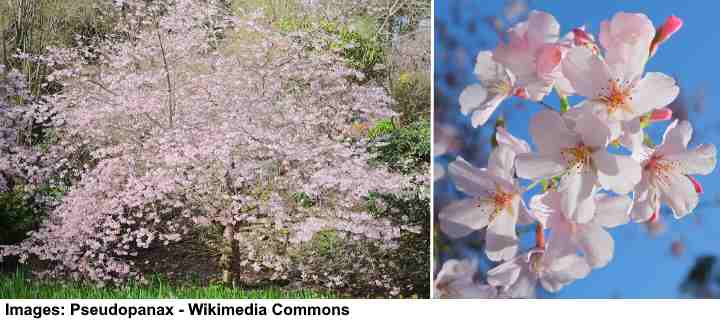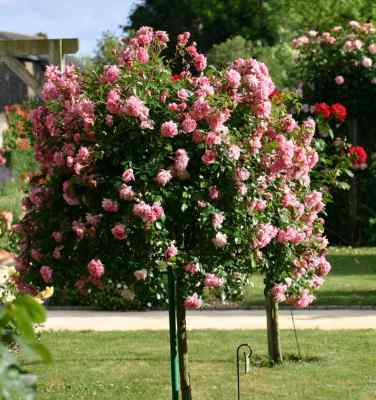210 Flowering Trees (with Pictures and Names): Identification Guide
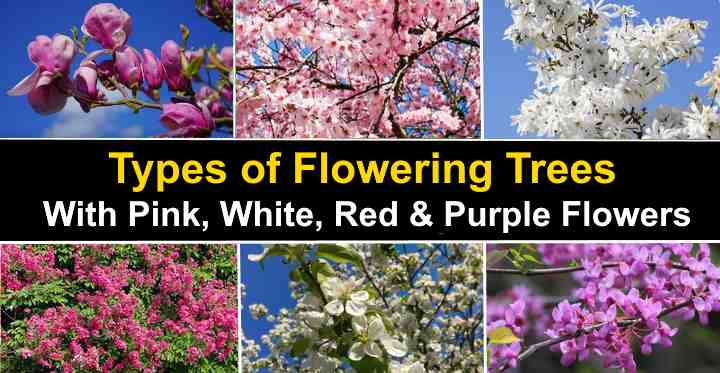
Are you looking to enhance your garden with beautiful flowering trees? Adding flowering trees to your garden can bring vibrant pink, red, purple, or white colors to any size of the garden. With careful planning of your garden landscape, you can enjoy a stunning array of tree blossoms throughout spring, summer, and fall.
Some flowering fruit trees such as apple, pear, or cherry trees have the added benefit of producing delicious fruits. Other popular types of trees give you exceptional vibrant colors when they bloom in spring.
This article is a comprehensive guide to 210 flowering trees with pictures to help you identify the perfect ornamental trees for your landscaping needs.
List of Flowering Trees with their Pictures and Names
Here’s a list of flowering trees with their pictures.
Pink Flowering Trees (With Pictures)
Eastern Redbud (Cercis canadensis)
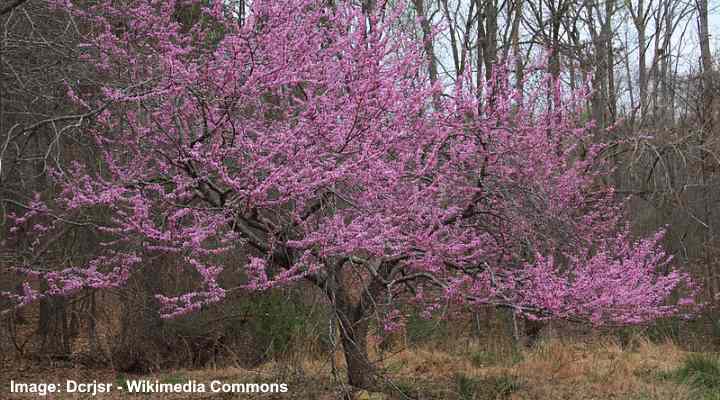
Eastern redbud (American redbud) tree with pink flowers
The eastern redbud tree is a compact deciduous tree known for its decorative clusters of vibrant pink or purple, pea-like flowers. These eye-catching pink blooms form a remarkable floral spectacle during early spring, adorning the tree’s bare branches. Complementing its striking floral display, the tree boasts heart-shaped leaves that exhibit a vibrant green hue, as well as a hint of red. These leaves also transition into a beautiful, pale yellow color in the autumn season.
Eastern redbud trees have exceptional adaptability, growing in diverse soil types. These trees are prized additions to gardens, providing a vibrant burst of color and enhancing their beauty as magnificent ornamental trees. With their distinct branching pattern and rounded crown, they serve as beautiful specimen trees and contribute to the charm of shrub borders. During the early spring season, eastern redbuds entice pollinators, amplifying the ecological value of the landscape.
Mature Size: 20 to 30 ft. (6 – 9 m) tall and 25 to 35 ft. (7.5 – 10.5 m) wide
USDA Hardiness Zones: 4 to 9
Sun: Full sun to partial shade
Kanzan Cherry Tree (Prunus serrulata ‘Kanzan’)

The Kanzan cherry tree is a beautiful flowering tree known for its stunning double pink flowers. These flowers have frilly petals and are grouped together in dense clusters, creating a vibrant and captivating spring show. After the blossoms drop, reddish-copper leaves appear that gradually turn dark green. In the fall, the glossy green foliage turns to shades of orange and bronze. This cultivar doesn’t produce any fruit.
Kanzan cherry trees require minimal maintenance and can thrive in different types of soil. They are often chosen for landscaping purposes as they add a pop of color and beauty to any outdoor space. Additionally, their small size makes them a suitable choice for smaller gardens, where they can provide shade.
Mature Size: 25 to 30 ft. (8 – 9 m) tall and 25 ft. (8 m) wide
USDA Hardiness Zones: 5 to 9
Sun: Full sun
Weeping Cherry Trees (Prunus pendula)
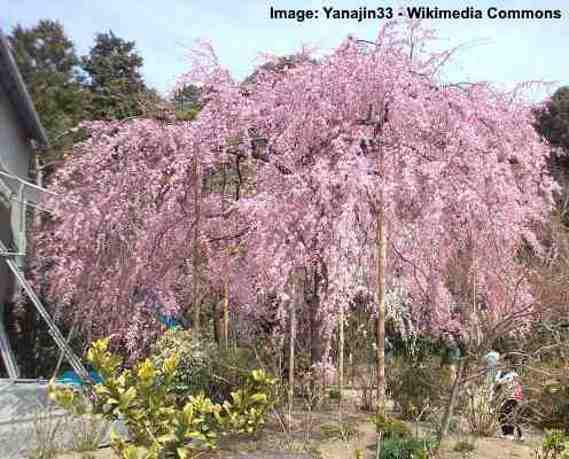
Weeping cherry trees are attractive trees known for their delicate pale pink or pinkish-white flowers. These flowering trees are highly valued for their elegant weeping form and drooping foliage. The glossy green leaves of weeping cherry blossom trees transform into vibrant hues of yellow, orange, or bronze during the autumn season. These trees also have small black fruits.
During spring, weeping cherry trees put on a breathtaking display of cascading flowers, making them a perfect choice to create a focal point in gardens. These drooping cherry tree branches almost reach the ground. So, regular pruning is required to walk or sit under the tree in the shade.
Opting for a pink blossom weeping cherry tree can add a touch of beauty and charm to your outdoor space. In addition, these trees emit a pleasant fragrance, enhancing their overall appeal in landscaping.
Mature Size: 15 to 25 ft. (4.5 – 7.5 m) tall and wide
USDA Hardiness Zones: 6 to 8
Sun: Full sun
Cherry Blossom Tree ‘Pink Perfection’ (Prunus serrulata ‘Pink Perfection’)
The ‘Pink Perfection’ cherry blossom cultivar is a stunning and decorative tree known for its abundant clusters of fragrant pink flowers.
Deciduous cherry blossom trees are identifiable by their spreading habit and vase-shaped, rounded crown. The pink flowers emerge in mid to late spring and grow in dangling clusters of pinkish-white flowers.
As autumn arrives, the cherry blossom tree’s twisted branches showcase vibrant red and orange leaves.
‘Pink Perfection’ cherry blossom trees are compact in size, making them an ideal choice for smaller landscapes, such as lawns or as specimen plants. They also thrive when planted in containers, offering a beautiful burst of color to brighten up patios or decks.
Mature Size: 10 to 15 ft. (3 – 4.5 m) tall and up to 12 ft. (3.6 m) wide
USDA Hardiness Zones: 6 to 8
Sun: Full sun
Pink-Flowering Crabapple Trees
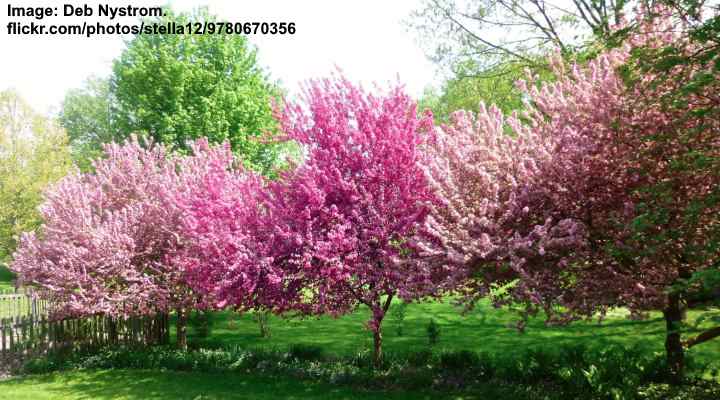
Crabapple trees
Pink-flowering crabapple trees are known for their beautiful displays of pink blooms during the spring season. These attractive fruit trees showcase blossoms in a range of hues, from delicate soft pinks to deeper shades of pink. The flowers can be single, semi-double, or double, with the double blooms creating fragrant, showy floral displays.
Crabapple trees are a wonderful choice for introducing shades of pink to spring gardens. Following the blooming period, the irregular canopy becomes adorned with dark green leaves, while twisted branches give way to small cherry-like pomes. Planting these small trees in rows can also create a charming informal hedge or a vibrant flowering border.
Here are some notable varieties of crabapples that feature pink flowers:
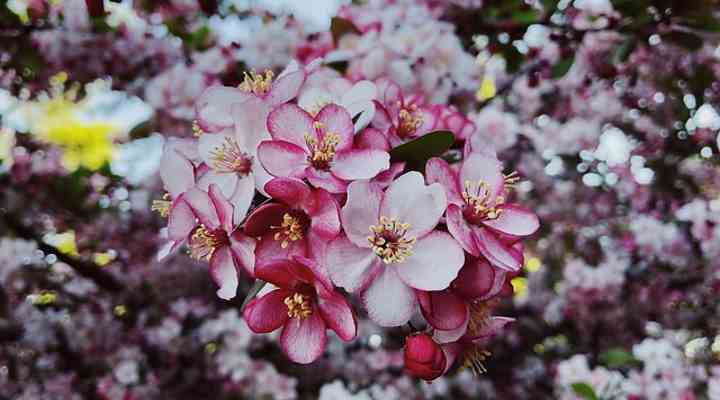
Crabapple Malus ‘Robinson’
Crabapple Malus ‘Robinson’ – ‘Robinson’ crabapple trees are highly valued for their beautiful pink flowers, making them excellent choices for enhancing the aesthetics of landscapes. These trees are versatile, and can thrive in zones 4 through 8. With a height and spread ranging from 15 to 25 ft. (4.5 – 7.6 m), they offer a balanced size for creating visually appealing outdoor spaces.
Crabapple Malus ‘Brandywine’ – ‘Brandywine’ crabapple trees have attractive pink double blooms. These flowers appear on the tree in mid-summer, accompanied by vibrant cherry-red leaves, creating a beautiful sight. The ‘Brandywine’ crabapple trees typically reach a height of 15 to 20 ft. (4.5 – 6 m) and can spread up to 20 ft. (6 m).
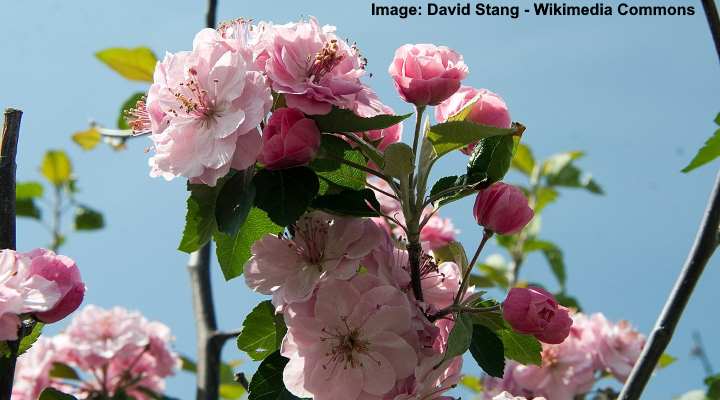
Crabapple Malus ‘Brandywine’
Pink Flowering Dogwood (Cornus florida ‘Rubra’)
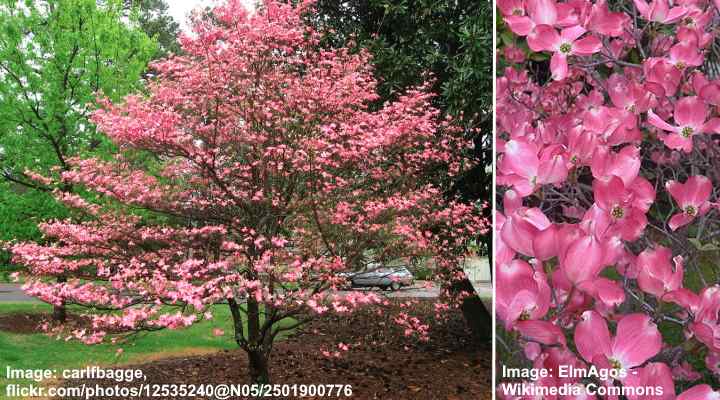
Pink Flowering Dogwood (Cornus florida ‘Rubra’)
The pink-flowering dogwood is easily identified by its stunning pink flowers that bloom in early spring. As summer arrives, orange-red fruits emerge after the flowering stage. The dogwood tree has ovate green leaves that have a slight twist and transform into vibrant shades of red during the autumn season.
The bark of dogwood trees has a scaly appearance and readily peels. It serves as a distinctive identifying feature of flowering dogwood trees. In numerous dogwood varieties, the gray-brown bark has a unique pattern reminiscent of alligator skin. This characteristic enhances the tree’s appeal in a winter garden landscape.
Flowering dogwood trees have a fast growth rate. Dogwoods grow up to 1 ft. (30 cm) a year and can reach their full height within ten years.
Pink flowering dogwood trees provide year-round interest in gardens exposed to either full sunlight or partial shade. Their ornamental value is evident throughout the seasons, starting with the pink flowers in spring, followed by a dense and rounded canopy of green leaves and red fruits in summer, stunning red foliage in the fall, and even eye-catching alligator-like bark visible in winter.
These pink-flowering dogwoods are ideal choices as ornamental trees, especially for compact landscapes where their beauty can truly shine.
Mature Size: 15 to 30 ft. (4.5 – 9 m) tall and wide
USDA Hardiness Zones: 5 to 9
Sun: Partial shade
Pink Flowering Japanese Dogwood Tree (Cornus kousa ‘Rutpink’ and ‘Miss Satomi’)
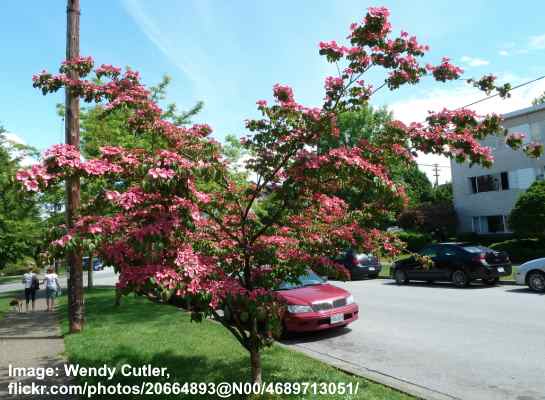
A young Japanese dogwood tree with pink flowers
Japanese dogwood trees display stunning pink flowers that adorn their rounded or vase-shaped canopies. These clusters of pink star-shaped flowers beautifully contrast with the tree’s elliptical-shaped leaves. Following the flowering season, small berry-like fruits in pinkish or pale red hues appear, attracting birds and wildlife. Dogwood trees are also characterized by their graceful branching patterns.
Two exceptional varieties of Japanese dogwoods are particularly noteworthy: Cornus kousa ‘Rutpink’ and Cornus kousa ‘Miss Satomi.’
Pink Flame Kousa Dogwood (Cornus kousa ‘Rutpink’): This dogwood variety can be identified by its clusters of pink star-shaped flowers, reddish-purple fall foliage, and exfoliating bark. It thrives in full sun or partial shade and can reach a height of 20 to 25 ft. (6 – 7.5 m) in USDA zones 5 to 8.
Kousa Dogwood ‘Miss Satomi’: This dogwood variety is recognized by its clusters of pink flowers with four petals, rosy-pink summer fruits, bright red fall foliage, and mottled tan bark that peels during winter. It is a decorative tree that grows 12 to 15 ft. (3.6 – 4.5 m) tall when exposed to full sun in USDA zones 5 to 8.
Crape Myrtle (Lagerstroemia indica)
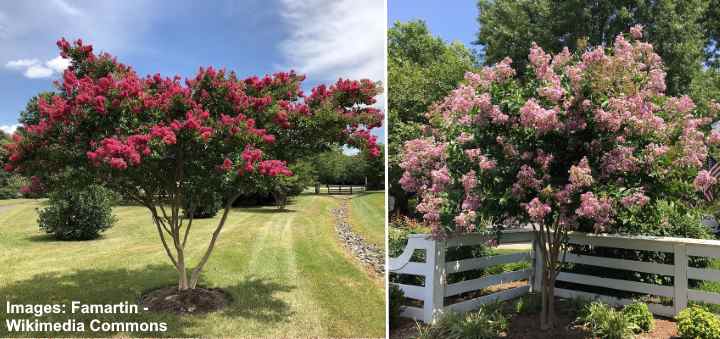
Crape myrtles are small flowering trees that grow best in full sun and are suitable for compact spaces
Crape myrtle trees are known for their abundant clusters of fragrant pink flowers, which can vary in shades depending on the specific cultivar. These showy flowers form cone-like clusters that appear on the tree throughout the summer season, lasting for several weeks. As autumn arrives, the tree’s oblong leaves, characterized by their leathery texture and dark green color, undergo a beautiful transformation, turning shades of orange, red, and purple.
Crape myrtle trees serve as stunning pink-flowering ornamental trees, adding visual appeal to various landscape settings. They can also be grown as large shrubs, used as screens, or planted as informal hedges.
For optimal growth, it is recommended to plant crape myrtle trees in well-draining soils with a loamy or clay texture. These trees are known for their resilience to drought and require minimal maintenance once established.
Crape myrtles come in various sizes, from tall trees, small to medium sized trees and dwarf trees. There are even crape myrtle shrubs.
Due to their ability to thrive in hot and humid conditions, crape myrtle trees are often referred to as the “Lilac of the South.”
Mature Size: 6 to 25 ft. (1.8 – 7.6 m) tall and up to 20 ft. (6 m) wide
USDA Hardiness Zones: 7 to 9
Sun: Full sun
Saucer Magnolia (Magnolia x soulangeana)

Saucer magnolia or Japanese magnolia has large flowers that come in shades of pink, purple and white
The saucer magnolia is an attractive deciduous tree known for its abundant spring-blooming, fragrant pink flowers. It is also commonly known as the tulip magnolia due to its large goblet-shaped flowers in shades of pink and white hues. This heat-loving magnolia tree features green obovate foliage that transforms into a beautiful golden brown hue during the fall season.
With its rounded shape and multiple stems, the saucer magnolia is a popular choice in ornamental gardens. It does well as a specimen tree, lawn tree, or accent tree, bringing a touch of elegance and beauty to any landscape. Magnolias thrive best in well-drained soil and prefer full sun to partial shade.
If you’re searching for a small pink-flowering tree suitable for a compact garden, the saucer magnolia ‘Lilliputian’ is an excellent option. This compact multi-stemmed magnolia tree grows to a height of 10 to 12 ft. (3 – 3.6 m) and showcases beautiful pale pink showy flowers, making it perfect for smaller yards.
Mature Size: 15 to 20 ft. (4.5 – 6 m) tall and wide
USDA Hardiness Zones: 6 to 9
Sun: Full sun to partial shade
Western Redbud (Cercis occidentalis)
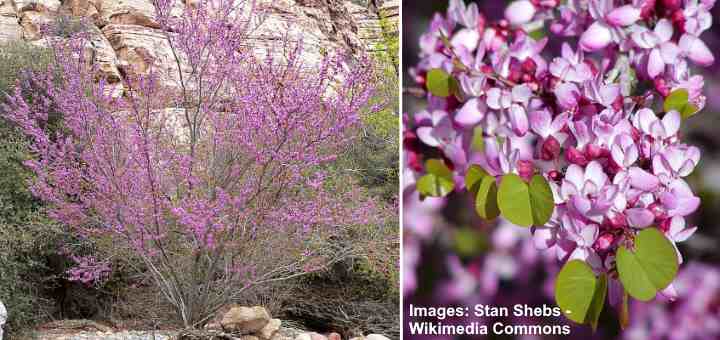
The western redbud, native to California, is a striking deciduous tree known for its beautiful pink flowers and its open, rounded shape. The heart-shaped leaves further enhance its appeal. The tree showcases its spectacular display of pink flowers in early spring, before the leaves emerge, creating a captivating sight. During the fall season, the redbud’s foliage turns into shades of golden yellow or rusty red.
Western redbud trees bring year-round interest to residential gardens. Following the blooming of the pink flowers, long purple-brown seed pods appear. The tree’s compact and irregular branching pattern adds to its beautiful appearance during the winter months. Due to their small size and multi-trunked growth habit, western redbuds are well-suited as specimen trees in gardens with limited space.
Western redbud trees can thrive in various soil types and are drought tolerant once they are established. Additionally, western redbud trees require relatively low maintenance, making them a convenient choice for garden enthusiasts.
Mature Size: 10 to 15 ft. (3 – 4.5 m) tall and wide
USDA Hardiness Zones: 6 to 9
Sun: Full sun to partial shade
Black Lily Magnolia (Magnolia liliiflora ‘Nigra’)
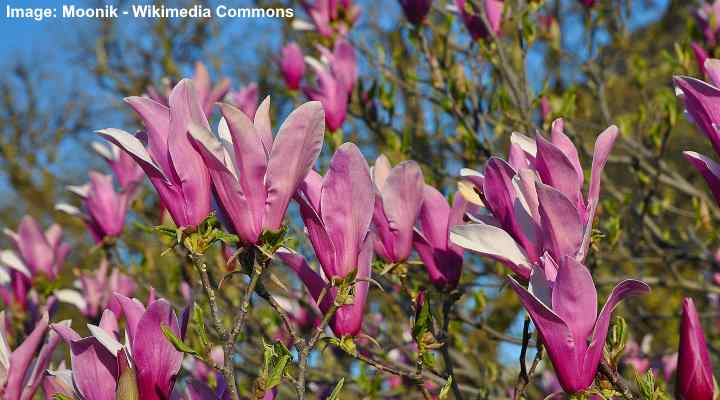
Black lily magnolia trees have deep pink tulip-shaped flowers
The black lily magnolia is a small tree known for its stunning, lily-like flowers in shades of dark pink to purple. These fragrant pink flowers appear on the tree in late spring and continue to sporadically bloom throughout the summer, adding bursts of color to the surroundings. Against the backdrop of glossy, dark green leaves, the vibrant flowers create a captivating visual display. Notably, the flowers can reach a length of 5″ (12 cm).
With their compact size, black lily magnolias are excellent trees for small front or backyards. Whether in cottage gardens, city gardens, or as a focal point on a lawn, these trees bring beauty and charm to their surroundings. They thrive best in well-drained, slightly acidic soils, ensuring optimal growth and blooming.
Mature Size: 8 to 12 ft. (2.4 – 3.6 m) tall and wide
USDA Hardiness Zones: 5 to 9
Sun: Full sun to partial sun
Pink Peacock Flower (Caesalpinia pulcherrima ‘Rosea’)

The pink peacock flower is a beautiful small ornamental tree adorned with clusters of stunning pink-reddish flowers. These flowers exhibit a distinctive exotic look, characterized by long, slender stamens emerging from bowl-shaped blossoms. The tree’s foliage is equally impressive with attractive fern-like leaves that contrast well alongside its brown seed pods.
With their compact size, pink peacock trees are ideal for smaller gardens or as accent trees in larger yards. Their branches, covered with spines, can serve as a security solution when planted as a hedge, privacy screen, or foundation planting. The vibrant pink flowers of the tree make it a popular choice for adding a splash of color and visual interest to any garden.
Mature Size: 10 to 15 ft. (3 – 4.5 m) tall and 6 to 12 ft. (1.8 – 3.6 m) wide
USDA Hardiness Zones: 9 to 11
Sun: Full sun
Higan Cherry Tree (Prunus × subhirtella)

The Higan cherry tree is a stunning ornamental tree, known for its attractive pinkish-white flowers. These beautiful flowers, with their delightful fragrance, bloom in clusters. As autumn arrives, the foliage of the tree transitions into hues of yellow or reddish-orange, further enhancing its visual appeal. During summer, clusters of small oval black fruits appear that attract various birds and mammals.
The Higan cherry is adaptable to various well-drained soil types. The abundant display of pink blooms in spring makes it a perfect choice as a lawn tree or as a focal point in a garden. Moreover, its tolerance for urban environments makes it an excellent addition to city gardens, where its beautiful blossoms can enhance the overall aesthetics.
Mature Size: 20 to 30 ft. (6 – 9 m) tall and 15 to 30 ft. (4.5 – 9) wide
USDA Hardiness Zones: 6 to 8
Sun: Full sun to partial shade
Yoshino Cherry Tree ‘Awanui’ (Prunus x yedoensis ‘Awanui’)
The Awanui Yoshino cherry tree is a magnificent medium-sized tree that showcases an abundance of fragrant pale flowers in the spring. These almond-scented single pink flowers form clusters, offering a breathtaking floral spectacle that attracts birds and pollinators. These trees have small black cherry fruits that are inedible but attract birds in the summer. The tree’s blooming period spans two to three weeks, filling the surroundings with natural beauty. Following the blooming phase, vibrant green leaves emerge, accompanied by clusters of shiny black drupes.
Awanui Yoshino cherry trees are not only admired for their soft pink flowers but also for their low-maintenance nature. They can thrive in various soil types, making them versatile ornamental trees. The tree’s dense foliage provides shade in temperate landscapes during the summer months, creating a cool and inviting atmosphere. Moreover, it excels as a specimen plant or lawn tree, adding charm and elegance to outdoor spaces.
Mature Size: 20 ft. (6 m) tall and 26 ft. (8 m) wide
USDA Hardiness Zones: 5 to 8
Sun: Full sun
Red Horse Chestnut (Aesculus carnea)
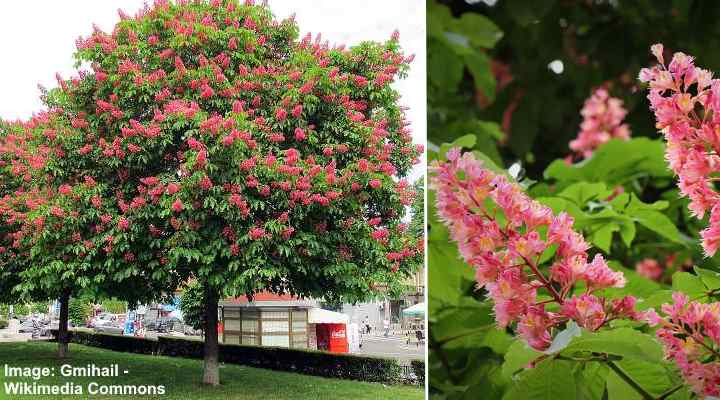
Red Horse Chestnut (Aesculus x carnea)
The red horse chestnut tree is a remarkable shade tree admired for its breathtaking clusters of bright rose-red and pink flowers. These vibrant pink flowers grow on the tree in late spring. The upright conical flower clusters create a striking visual display against the backdrop of its dark green foliage. Although the tree doesn’t have significant fall colors, its stunning spring blooms compensate for it.
The bark on the red horse chestnut is primarily gray and smooth. It eventually develops rounded scales separated by shallow fissures giving the light gray bark a rough texture.
The fruit from a red horse chestnut tree is a spiny capsule measuring 1.5” (3.8 cm) in diameter containing a glossy brown inedible seed.
Red horse chestnut trees are of medium size, making them well-suited for various landscapes. They can be used as shade trees or as specimen trees, particularly in larger yards or park settings, where their beauty can truly shine.
In addition to its cone-like clusters of pink flowers, the red horse chestnut tree is characterized by its spiny capsules that house shiny brown nuts, adding an interesting and unique feature to its overall appearance.
Mature Size: 30 to 40 ft. (9 – 12 m) tall and wide
USDA Hardiness Zones: 5 to 8
Sun: Full sun or partial shade
Orchid Tree (Bauhinia variegata)
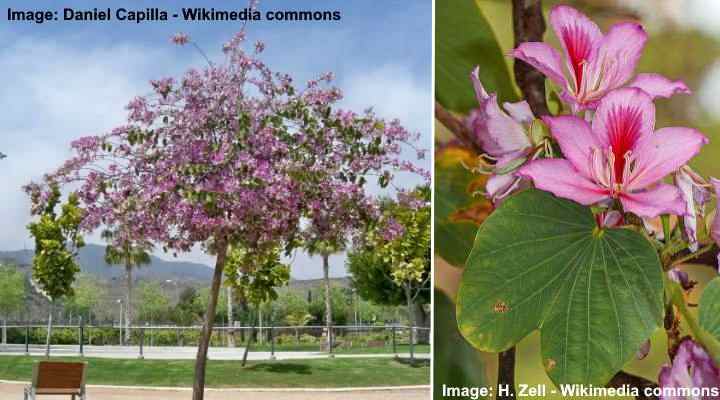
Orchid Tree (Bauhinia variegata)
The orchid tree is an excellent option for those seeking an exotic tropical tree with pink flowers. This beautiful tree is characterized by its stunning pink blooms that bear a resemblance to orchids. It features a spreading canopy, light green leaves resembling butterfly wings, and long seed pods with sharp beaks. In the warmest regions, the tree’s foliage remains evergreen.
Orchid trees are highly sought after as ornamental trees, primarily due to their striking tropical flowers. They thrive best in well-drained and moist soil, while also exhibiting good drought tolerance. Whether as a specimen tree, in small groups, or as part of a mixed border, this attractive tree can enhance the visual appeal of any landscape.
Mature Size: 20 to 35 ft. (6 – 10.5 m) tall and wide
USDA Hardiness Zones: 9 to 11
Sun: Full sun to partial shade
Hong Kong Orchid Tree (Bauhinia × blakeana)
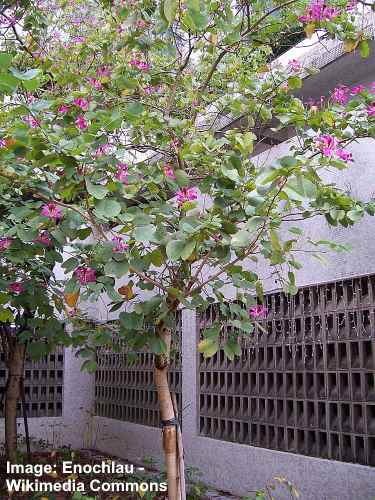
The Hong Kong orchid tree stands out with its magnificent orchid-like blossoms that bloom abundantly from fall to spring. These large, captivating flowers feature vibrant hues of pink or purple, accompanied by gracefully arching creamy-white stamens. The leaves of this tree are distinctively shaped, resembling the wings of butterflies. When in full bloom, the tree becomes a sight to behold as the flower clusters envelop it, creating a truly beautiful display.
Hong Kong orchid trees thrive in warm and sunny environments. They have an umbrella-shaped canopy adorned by gray-green heart-shaped leaves. While the foliage is noteworthy, it is the pink flowers that steal the spotlight. Planting an orchid tree as a focal point in gardens can add a touch of beauty to your surroundings.
Mature Size: 12 to 20 ft. (6 – 12 m) tall and wide
USDA Hardiness Zones: 9 to 11
Sun: Full sun
Desert Willow (Chilopsis linearis)
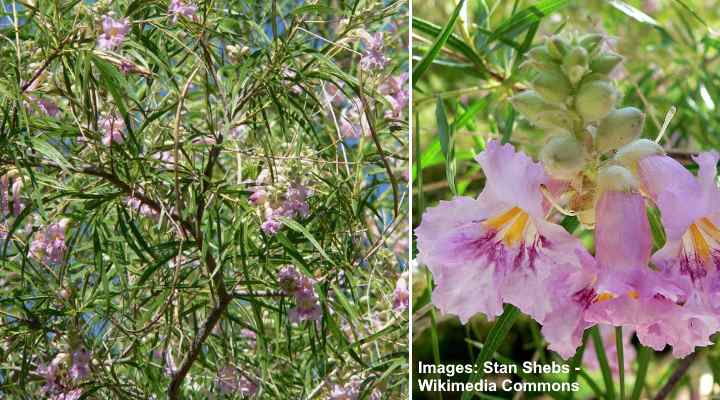
Desert Willow (Chilopsis linearis)
Desert willow is a deciduous tree known for for its exquisite pink flowers with streaks of dark pink and purple. The blooms, shaped like trumpets, appear in sizeable clusters and emit a sweet fragrance. Following their emergence from late spring until fall, the tree produces lengthy seed pods resembling beans. The foliage of the tree showcases elongated, slim, and pointed leaves, contributing to its elegant appearance.
Desert willow trees have rapid growth rate and can also endure drought, thriving in scorching and arid climates. They are a favored tree for gardens in desert regions. The tree’s distinct beauty and its capacity to attract hummingbirds and butterflies make it a great addition to any landscape, whether as a lawn tree or a standout specimen plant.
Desert willows flourish in hot and arid climates, making them highly sought after in states across the United States, including California, Texas, Arizona, and Nevada.
Mature Size: 15 to 30 ft. (4.5 – 9 m) tall and wide
USDA Hardiness Zones: 7 to 11
Sun: Full sun
Pink Trumpet Tree (Handroanthus heptaphyllus)
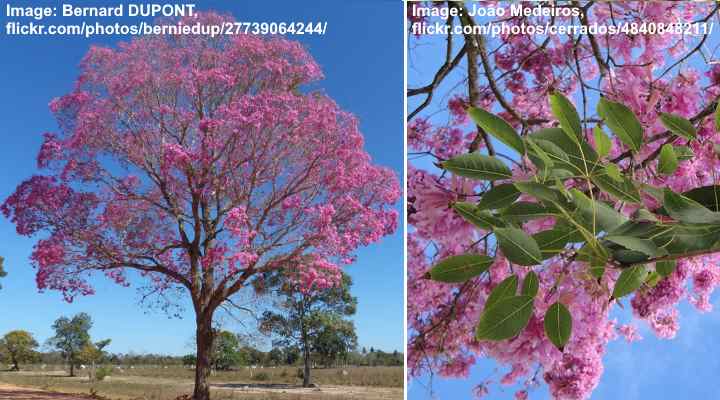
Pink Trumpet Tree (Handroanthus heptaphyllus)
The pink trumpet tree catches the eye in gardens with its vibrant pink flowers shaped like trumpets. These beautiful tubular flowers, ranging in shades from pale to deep pink, grace the tree during the spring season, lasting for several weeks. Its leaves are dark green, palmate compound leaves with serrated edges.
Pink trumpet trees are indigenous to tropical and subtropical regions of South America. These ornamental trees thrive best in well-drained clay, loam, or sandy soils. With their delightful pink hues, they bring a burst of color to expansive garden landscapes.
Mature Size: 40 to 50 ft. (12 – 15 m) tall and 35 to 50 ft. (10 – 18 m) wide
USDA Hardiness Zones: 10 and 11
Sun: Full sun or partial shade
Rosy Trumpet Tree (Tabebuia rosea)
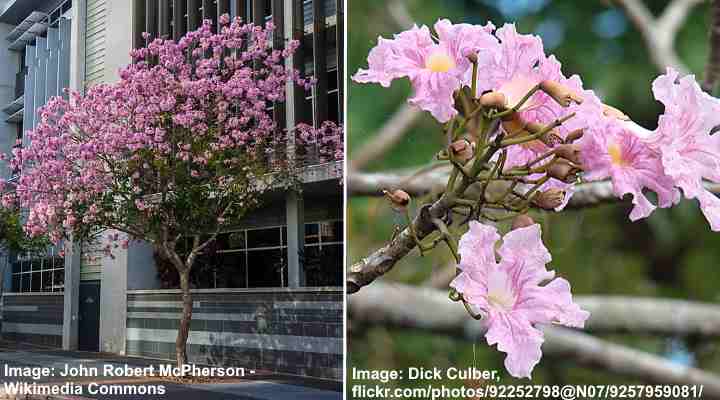
The rosy trumpet tree has captivating lavender-pink tubular flowers with yellow centers. This deciduous tree boasts tropical trumpet-shaped flowers, varying in shades from light pink to deep magenta. The flowers emerge in clusters, enveloping the tree in a breathtaking array of colors.
In addition to its vibrant pink blooms, the rosy trumpet tree features glossy green compound leaves and elongated seed pods that can reach up to 14 inches (35 cm) in length.
For optimal growth, rosy trumpet trees prefer deep, fertile soil that offers proper drainage while retaining moisture. Once established, these trees require minimal maintenance and exhibit tolerance to drought conditions. Planting rosy trumpet trees in large tropical and subtropical regions can provide shaded areas and infuse your gardens with a delightful splash of color.
Mature Size: 60 to 90 ft. (18 – 27 m) tall and 30 to 50 ft. (9 – 15 m) wide
USDA Hardiness Zones: 9 to 11
Sun: Full sun
Chinese Plum Tree (Prunus glandulosa)
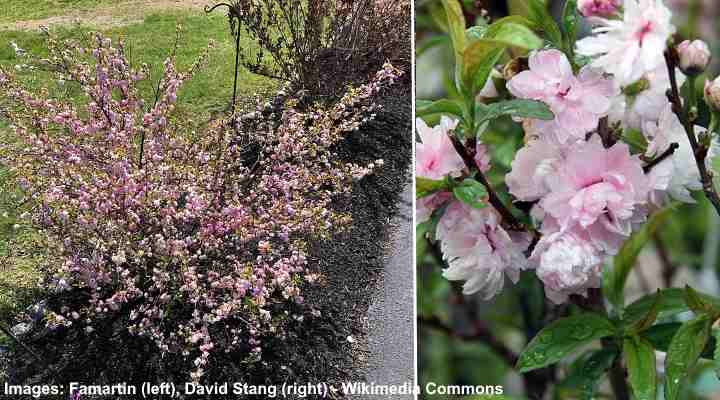
The Chinese plum tree, also referred to as the flowering almond, is a compact ornamental shrub or small tree renowned for its pink blossoms. This deciduous tree produces clusters of pinkish-white flowers, creating an enchanting spectacle. The cherry-like double flowers emerge in early spring, preceding the appearance of leaves, and appear on the tree with an exquisite display of pink blooms. While the oval green leaves of the tree transform into a modest yellow hue during the fall season.
Chinese plum trees are effortless to cultivate and exhibit adaptability to various soil types. However, ensuring adequate drainage is essential. The most common application of the dwarf flowering almond tree is as an ornamental tree in front or backyards, serving as a captivating focal point that enhances the beauty and fragrance of any landscape.
Mature Size: 4 to 5 ft. (1.2 – 1.5 m) tall and wide
USDA Hardiness Zones: 4 to 8
Sun: Full sun to partial shade
Purple Leaf Plum ‘Nigra’ (Prunus cerasifera ‘Nigra’)
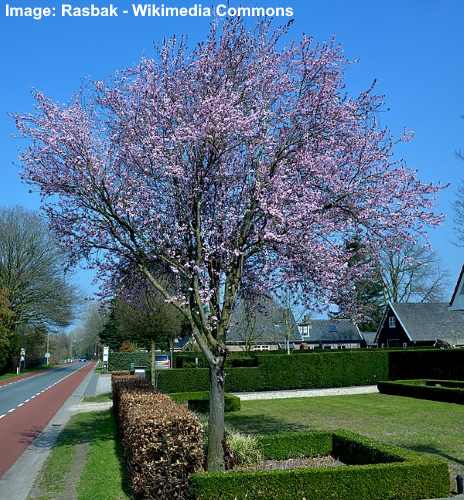
Prunus cerasifera ‘Nigra’
The ‘Nigra’ variety of purple leaf plum brings a captivating allure to gardens with its charming pink flowers and dark purple foliage. Distinguished by deep pink flower buds, fragrant star-shaped pink blooms, and dark purple leaves, this pink-flowering tree stands out among plum tree varieties with its exceptionally rich leaf coloration.
The purple leaf plum tree also produces small plum-like yellow or red edible fruit.
The purple-leaf plum ‘Nigra’ proves to be a versatile tree, thriving in moderately fertile soils that offer proper drainage. With its compact size and relatively low height, this tree can be planted in small gardens to serve various purposes. In addition, the attractive dark foliage tree performs well in full sun and can tolerate some shade.
Whether as a standout specimen plant, a flowering hedge, or a privacy screen, the ‘Nigra’ purple leaf plum adds both beauty and functionality to your outdoor space.
Mature Size: 15 to 20 ft. (4.5 – 6 m) tall and wide
USDA Hardiness Zones: 4 to 9
Sun: Full sun produces the darkest foliage colors
Silk Tree (Albizia julibrissin)
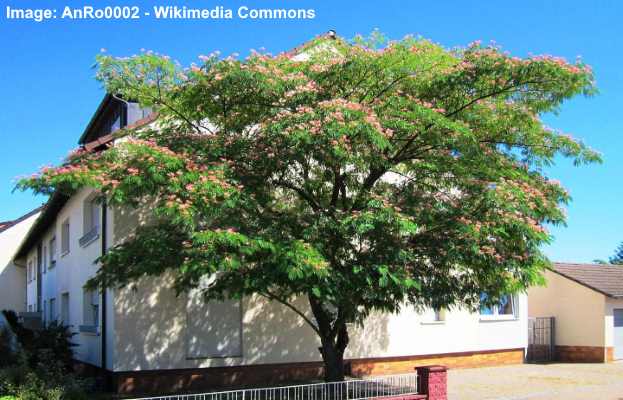
Mimosa Tree (Albizia julibrissin)
The silk tree, also referred to as the mimosa tree, is instantly recognizable due to its distinctive pink flowers resembling fluffy powder puffs. These unusual pink blooms, adorned with delicate, elongated stamens, emerge during early summer, enveloping the tree in a cloud of fluffy flowers. Another notable characteristic of this tree is its fern-like leaves that have a folding behavior at night or when gently touched. In addition, the trees are also recognizable by their long spreading branches.
Silk trees require relatively minimal maintenance and exhibit tolerance to drought, heat, and salt spray. These ornamental trees thrive particularly well in coastal gardens, adding an exotic touch to semi-tropical landscapes.
Mature Size: 20 to 40 ft. (6 – 12 m) tall and wide
USDA Hardiness Zones: 6 to 9
Sun: Full sun
Common Smoke tree (Cotinus coggygria)
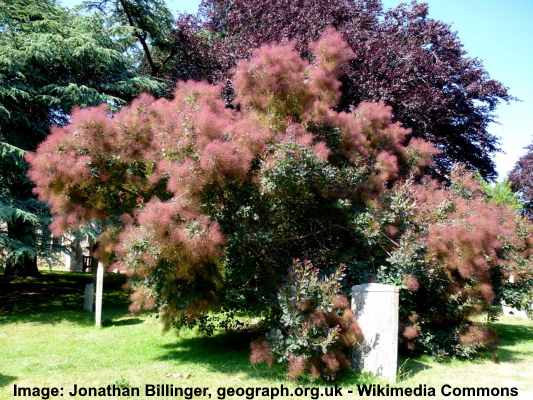
smoke tree in landscape
The common smoke tree is an attractive deciduous tree commonly used for ornamental purposes. It displays captivating clusters of flowers in shades of purple-pink. These unique pink flowers have delicate filaments that give them an ethereal, smoky look. The tree’s leaves can range in shades of purple before turning red, yellow, or orange in the fall.
Different varieties of smoke trees can tolerate colder climates, thriving in USDA hardiness zones 4 to 9. To maintain their vibrant foliage, smoke trees generally prefer full sun to partial shade.
Smoke trees can be planted as flowering hedges, screens, or even as standout specimen trees, adding visual interest to your landscape.
The ornamental plant is relatively short-lived and typically grows for around 20 years. But most gardeners agree that the beauty a smoke tree brings to a yard is worth it.
Mature Size: 10 to 15 ft. (3 – 4.5 m) tall and wide
USDA Hardiness Zones: 4 to 8
Sun: Full sun or partial shade
Pink-Flowering Fringe Trees (Loropetalum chinense var rubrum ‘Sizzling Pink’)
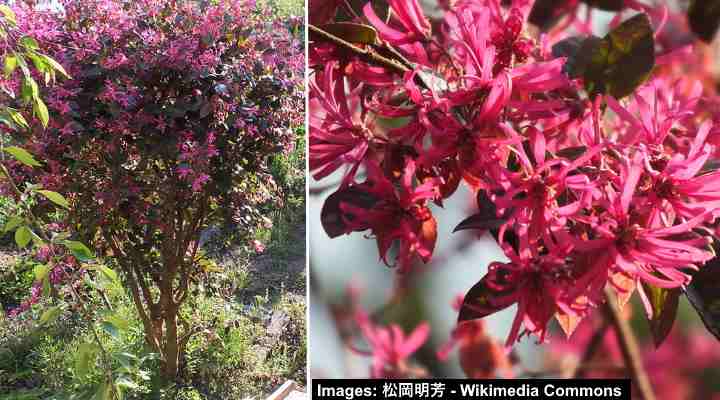
The pink-flowering fringe tree has stunning flowers with slender, wiry petals in a deep pink hue. These delicate fringe flowers bloom during late spring and emit a pleasant fragrance. The dwarf trees have dark purplish leaves, enhancing their dramatic appeal. Fringe trees thrive in well-drained soils and are well-suited for foundation planting, small groupings, or even container gardening.
Mature Size: 6 to 8 ft. (1.8 – 2.4 m) tall and wide
USDA Hardiness Zones: 7 to 9
Sun: Full sun to partial shade
Floss Silk Tree (Ceiba speciosa)
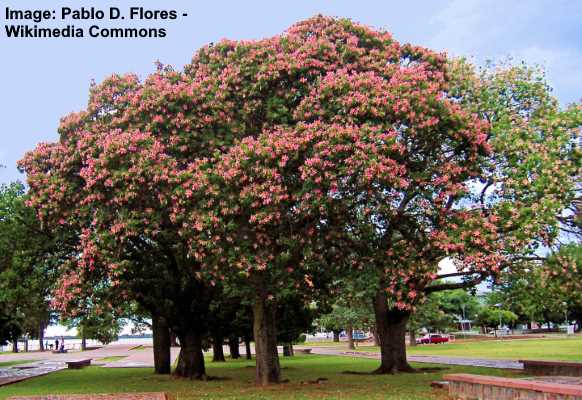
Floss Silk Tree (Ceiba speciosa)
The floss silk tree delights with its year-round display of vibrant pink hibiscus-like flowers. Each flower features five magenta-pink petals with wavy edges and a prominent stamen. During the fall season, the tree’s dark green palmate leaves transition to a lovely shade of yellow. The tree bears pear-shaped fruits that enclose pea-like seeds surrounded by silky floss.
Floss silk trees are notable for their distinctive trunk adorned with sharp spines. The trunk also boasts a smooth, grayish-brown bark. Due to the spines, it is important to consider the tree’s placement carefully when planting.
Mature Size: 35 to 50 ft. (10 – 15 m) tall and 40 to 55 ft. (12 – 17 m) wide
USDA Hardiness Zones: 9 to 11
Sun: Full sun
Pink Shower Tree (Cassia grandis)
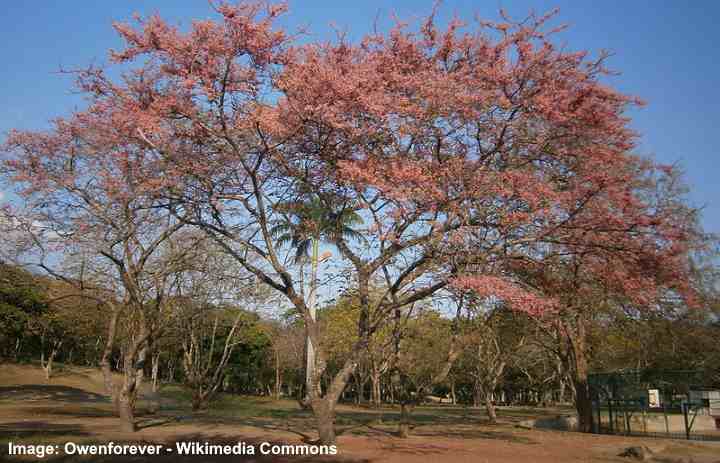
The pink shower tree is a delightful tropical tree that sheds its leaves and grows pink flowers. The tree displays clusters of stunning pink blooms, complemented by appealing pinnate leaves and elongated seed pods resembling beans. With its lush foliage, this tree serves well as a shade provider, while its attractive pinkish-white flowers contribute an exotic touch to any landscape.
Mature Size: 40 to 60 ft. (12 – 18 m) tall and wide
USDA Hardiness Zones: 10 to 12
Sun: Full sun to partial sun
Discover many other beautiful pink flowering trees to plant in your garden.
Types of White Flowering Trees (With Pictures)
White Flowering Crape Myrtle Tree (Lagerstroemia indica)
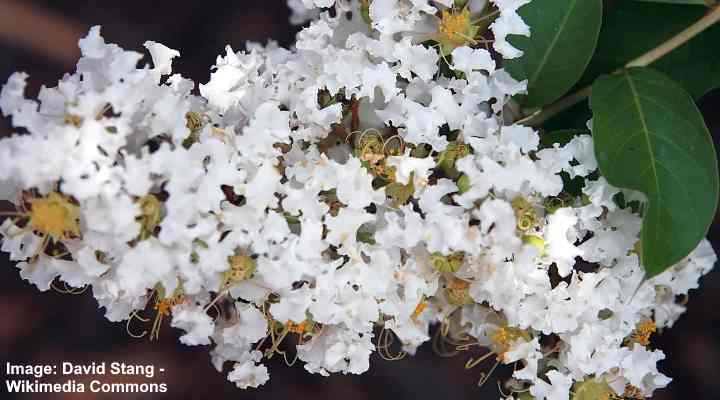
White flowering crape myrtle trees make for beautiful additions to any landscape, with clusters of cone-shaped white flowers resembling delicate crepe paper. These beautiful flowers bloom repeatedly throughout the summer season, creating a captivating display. The striking white blooms beautifully contrast with the tree’s dark green leaves. In autumn, the crape myrtle trees display lovely yellow leaves.
Crape myrtle trees with white flowers thrive best in well-drained soil with average moisture levels. They can be planted as standout specimen trees, used as foundation plants, or arranged in groups to create a stunning visual impact. It’s worth noting that other varieties of crape myrtle offer blooming periods in summer and fall, showcasing an array of colors such as pink, purple, red, and lilac.
With proper care and attention, white flowering crape myrtle trees can bring years of beauty to your landscape, enriching it with their elegant presence.
Mature Size: 5 to 25 ft. (1.5 – 7.5 m) tall, depending on the species
USDA Hardiness Zones: 6 to 9
Sun: Full sun exposure
Japanese Crape Myrtle (Lagerstroemia subcostata var. fauriei)
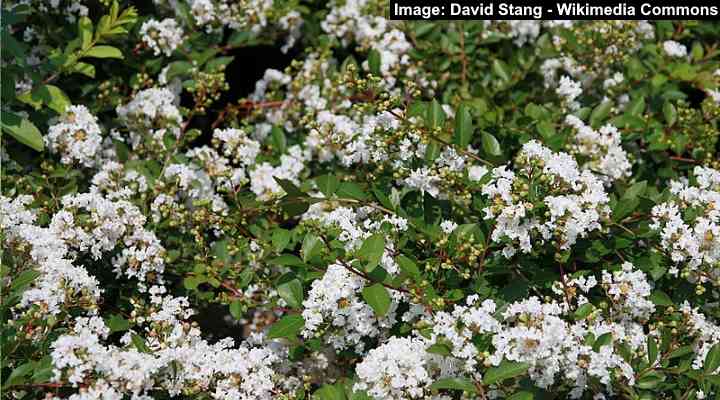
The Japanese crape myrtle is an enchanting tree with multiple trunks, known for its striking white flowers. The tree has abundant clusters of showy white flowers that resemble crepe paper, blooming in cone-shaped clusters. These vibrant flowers bring color and fragrance to summer gardens, as they have a long blooming season. In addition, the Japanese crape myrtle tree has leathery leaves that transition to a golden yellow shade in the fall.
Japanese crape myrtle trees thrive in sunny locations with well-drained soil. These shrub-like trees do well as white-flowering lawn trees, specimen plants, or when grouped to create a stunning display of white flowers. Known for their ability to bloom throughout the summer and fall, these trees enhance any landscape with their vibrant colors and natural beauty.
One of the distinctive features of the Japanese crape myrtle is its attractive light brown bark, which peels to reveal a cinnamon-colored inner bark. This characteristic, along with its other ornamental features, ensures that the tree offers visual interest throughout all four seasons.
Mature Size: 20 to 30 ft. (6 – 9 m) tall and wide
USDA Hardiness Zones: 6 to 9
Sun: Full sun exposure
Bigleaf Magnolia Tree (Magnolia macrophylla)
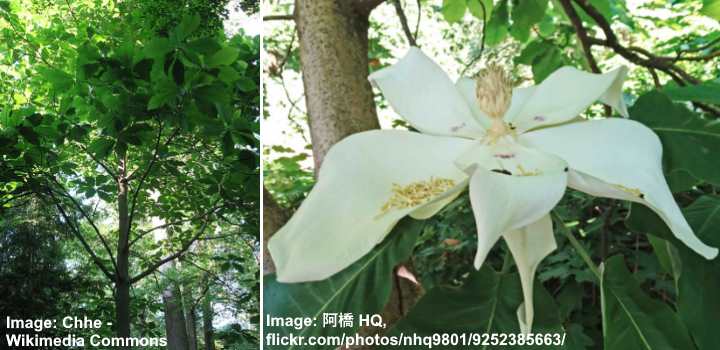
The white flowering bigleaf magnolia tree can be identified by its large, wide leaves and attractive star-shaped flowers with creamy-white hues. The white magnolia flowers feature lance-shaped petals with a rose-purple base. The tree’s broad oblong leaves can grow up to 3 feet (1 meter) long and 1 foot (0.3 meters) wide. Towards late summer, the tree produces red egg-shaped fruits.
The bigleaf magnolia is native to North America and thrives in well-drained soils enriched with organic matter. The magnolia tree performs well as a shade provider or a standout specimen plant in spacious garden landscapes. The large, captivating flowers attract important pollinators like bees and butterflies during the late spring and summer seasons.
Mature Size: 30 to 40 ft. (9 – 12 m) tall and wide
USDA Hardiness Zones: 6 to 9
Sun: Full sun or partial shade
Southern Magnolia (Magnolia grandiflora)
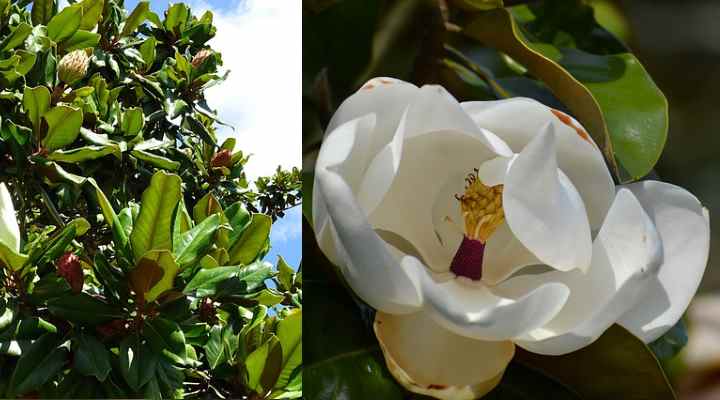
The white flowering southern magnolia tree can be recognized by its dense evergreen foliage, eye-catching white cup-shaped flowers with a pleasant fragrance, and cone-shaped seed pods housing red seeds. This magnificent evergreen tree features thick, leathery, oblong leaves, fragrant white flowers, and a rounded canopy, making it an appealing choice for providing shade and ornamental value in southern landscapes. The white flowers usually bloom during the late spring and early summer seasons.
Southern magnolias thrive best in soil that is neutral to rich in nutrients and offers excellent drainage. Once established, these trees can tolerate various soil types, including sandy or heavy clay soils. However, they are not well-suited for extreme drought conditions or highly polluted environments. With their rapid growth and natural resistance to pests, southern magnolias require minimal maintenance when cultivated in warm climates.
Southern magnolias are highly regarded for their ability to withstand the heat and humidity prevalent in southern gardens, making them excellent trees for enhancing such landscapes.
Mature Size: 60 to 80 ft. (18 – 24 m) tall and 30 to 50 ft. (9 – 15 m) wide
USDA Hardiness Zones: 7 to 10
Sun: Full sun or partial shade
English Hawthorn (Crataegus laevigata)
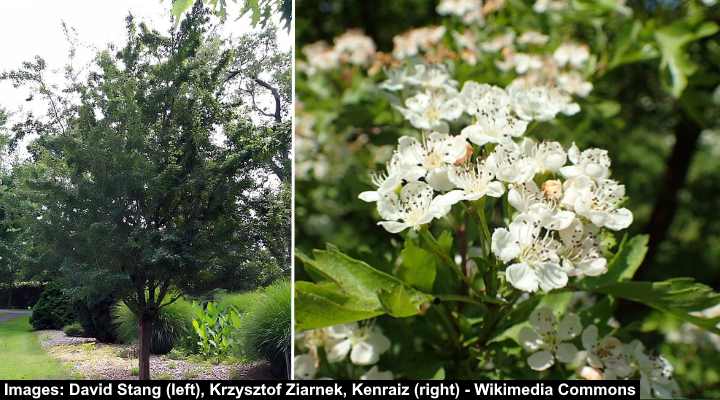
The English hawthorn is a charming deciduous tree highly valued for its clusters of pretty white flowers which grow during the spring season and emit a sweet fragrance. These delicate blossoms consist of petite oval petals accompanied by pale-yellow stamens. The vibrant white flowers create a striking contrast against the tree’s deep green foliage. This small ornamental tree features glossy green leaves, large thorns, attractive red fruits in the autumn, and zig-zag branches.
English hawthorn trees are resilient and versatile, adapting well to various soil types, including clay, loam, and sandy soils. These adaptable ornamental trees perform well as security hedges or standout specimen trees. Their ability to withstand salty air makes them a great choice for coastal landscapes and wildlife gardens.
Mature Size: 15 to 20 ft. (4.5 – 6 m) tall and wide
USDA Hardiness Zones: 5 to 8
Sun: Full sun
Flowering Cherry Tree (Prunus serrulata)

A variety of flowering cherry trees are known for their captivating display of white flowers. During spring, the tree’s spreading crown is adorned with abundant, fragrant white blossoms, creating a delightful visual spectacle. The cherry blossom tree flowers often feature double blooms with delicately ruffled petals that beautifully contrast with the dark green foliage.
White-flowering cherry trees thrive best in well-drained and fertile soil, receiving full sunlight. These trees are relatively easy to maintain and can be planted individually as standout specimen trees or arranged in groups to create a striking floral exhibition. In addition, they offer the added beauty of vibrant fall foliage, as their leaves transition into shades of yellow, orange, and red.
Several varieties of cherry blossom trees produce beautiful white flowers, including:
Prunus ‘Shirotae’: This small deciduous tree features pure white blossoms in spring, growing on a tree with a flat canopy.
Prunus ‘Shogestu’: This variety has white double flowers and forms large hanging clusters that can reach 6 inches (15 cm) in length.
Prunus ‘Snow Fountains’: This beautiful weeping cherry blossom tree has cascading branches adorned with small snow-white flowers that bloom throughout spring and early summer.
Prunus ‘Tai-Haku’: Known for its large white cherry blossoms, this variety produces clusters of flowers that cover the branches during the spring season.
Mature Size: 15 to 20 ft. (4.5 – 6 m) tall and wide
USDA Hardiness Zones: 5 to 8
Sun: Full sun exposure
Yoshino Cherry (Prunus x yedoensis)
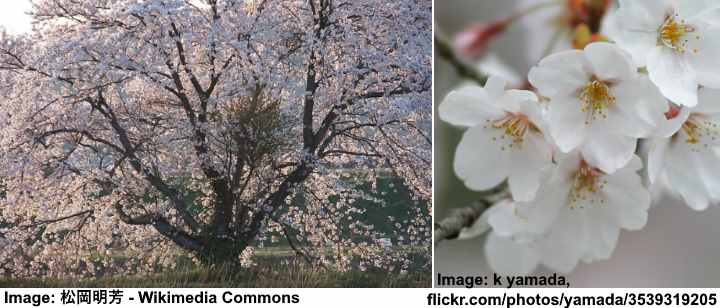
Yoshino cherry trees are known for their captivating display of white-pink blossoms that cover the tree during early spring, resulting in an attractive floral display. These trees are further distinguished by their dark green leaves and the magnificent shades of red, orange, and yellow that adorn their foliage during the fall season. This tree also produces small black ornamental fruits.
Cherry blossom trees are known for their extraordinary beauty, and exhibit an upright, spreading growth habit. They thrive in various well-drained soil types, provided they receive a minimum of four hours of sunlight each day and regular watering. Yoshino cherry trees are perfect for planting as lawn trees or as specimen plants in your garden.
Mature Size: 20 to 30 ft. (6 – 9 m) tall and have a wider spread
USDA Hardiness Zones: 5 to 8
Sun: Full sun or partial shade
White Flowering Almond Tree (Prunus glandulosa alboplena)
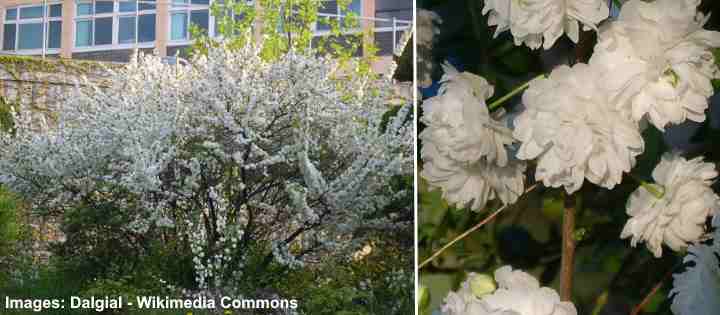
The white flowering almond tree is known for its small white blossoms that appear in early spring. The beautiful flowers on this tree have a soft cloud-like appearance. As the blooming period ends, vibrant green leaves emerge, ensuring that this tree remains a standout feature throughout the year, serving as a lush backdrop for its captivating flowers.
Whether used as a focal point, border tree, or planted in mass for a striking visual impact, the white flowering almond tree offers versatility in garden design.
Mature Size: 6 to 8 ft. (1.8 – 2.4 m)
USDA Hardiness Zones: 4 to 8
Sun: Full sun
White Flowering Pear tree (Pyrus spp.)
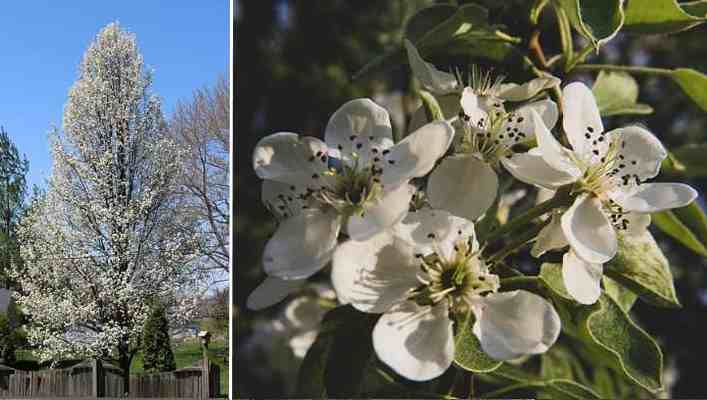
White flowering pear trees make stunning additions to any landscape with their clusters of creamy-white flowers. The blossoms of the white flowering pear tree beautifully stand out against its glossy green leaves during the spring season. As autumn arrives, the leaves of the pear tree transform into shades of yellow, orange, and red, enhancing the tree’s ornamental appeal.
Following the blossoming period in early summer, pears begin to develop and grow on the tree, reaching their optimal harvest time in late summer and early fall.
Adaptable and versatile, white flowering pear trees can thrive in various soil types, ranging from clay to sandy soil, as long as the soil provides proper drainage. These trees serve multiple landscaping purposes, including as specimen trees or small shade trees. In addition, their compact size makes them suitable for small backyards. With their naturally attractive shape, there is no need for pruning to maintain their appealing appearance.
Mature Size: 20 to 30 ft. (6 – 10 m) tall and wide, depending on the species
USDA Hardiness Zones: 6 to 9
Sun: Full sun
White Flowering Crabapple Trees (Malus spp.)
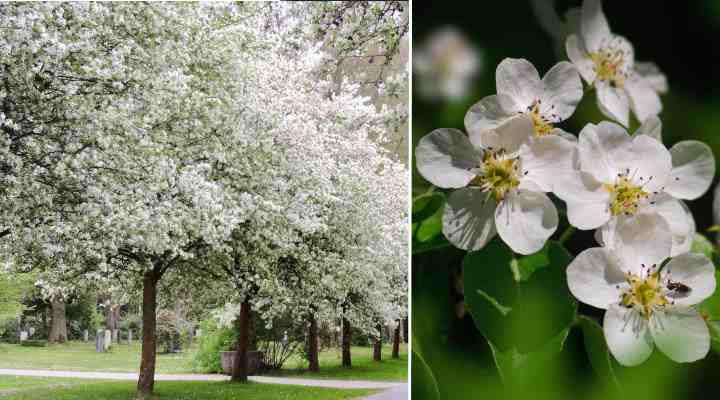
The white flowering crabapple tree is a small deciduous fruit-bearing tree known for its abundant clusters of fragrant white flowers. With its multi-stemmed structure, pink flower buds, dark green lobed leaves, and clusters of small cherry-like fruits hanging from twisted branches, this tree adds charm to any garden. Its blooming period typically occurs in mid to late spring and lasts for approximately 2 weeks.
Different species of crabapple trees have a variety of unique flowers, ranging from single to semi-double or full-double blooms in hues of white, pink, magenta, orange, or red. In addition, certain flowers emit pleasant fragrances reminiscent of cinnamon or cloves.
Although crabapple trees can reach heights of up to 40 ft. (12 m) with a similar width, it is recommended to choose dwarf cultivars when incorporating them into landscaped gardens. One such example is the ‘Camelot’ crabapple, a compact variety that features clusters of white flowers and grows to a maximum height of 9 ft. (2.7 m).
Crabapples require minimal maintenance and pruning, making them relatively easy to care for. They can also serve various purposes in a landscape, such as providing privacy as a screen, serving as a lawn tree, or forming a flowering hedge.
Adding beauty throughout three seasons, crabapple trees are an attractive addition to any landscape.
Here are some varieties of crabapple trees that feature white flowers:
Sargent Crabapple (Malus sargentii) – A dwarf landscape tree with an abundance of sweetly-scented white flowers. ‘Sargent’ crabapple trees typically grow between 6 and 10 feet (1.8 – 3 meters) in height, with a spread of up to 12 feet (3.6 meters) wide.
Lollipop Crabapple (Malus ‘Lollizam’) – This compact crabapple tree has clusters of fragrant white flowers each spring. With its slender, upright trunk and rounded growth habit, the ‘Lollipop’ crabapple reaches a height of approximately 8 feet (2.4 meters).
Snowdrift Crabapple (Malus ‘Snowdrift’) – Ornamental ‘Snowdrift’ crabapple trees produce clusters of fragrant white flowers in spring. These trees can grow to be around 15 to 20 feet (4.5 – 6 meters) in height.
Siberian Crabapple (Malus baccata) – Siberian crabapples are cold-hardy trees that have showy clusters of fragrant white flowers blooming in early spring. These tall trees can reach heights of 30 to 40 feet (9 – 12 meters).
Mature Size: 6 to 40 ft. (1.8 – 12 m) tall and wide, depending on the species
USDA Hardiness Zones: 5 to 9
Sun: Full sun
Carolina Silverbell Tree (Halesia carolina)
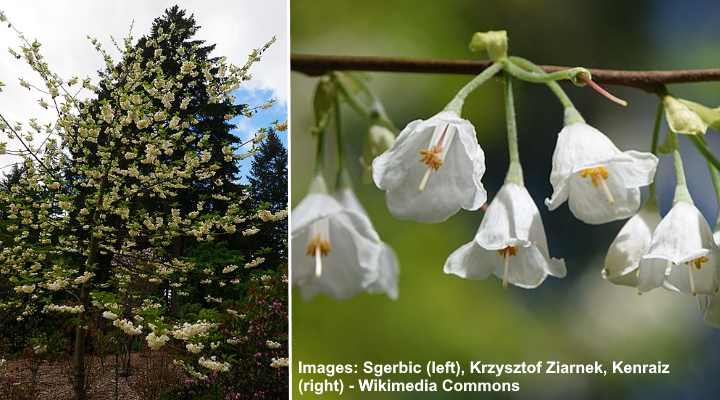
The white flowering Carolina silverbell trees can be identified by their delicate white bell-shaped flowers that hang gracefully from the branches. These charming white flowers bloom early in the season and emit a pleasant fragrance, attracting beneficial pollinators like bees and butterflies. The tree’s leaves, characterized by their vibrant green color and serrated edges, undergo a beautiful transformation, turning yellow in the fall.
Carolina silverbell trees thrive in well-drained soil that retains moisture. This deciduous plant can be cultivated as an attractive ornamental shrub or small tree, adding beauty to any landscape. Whether used as a specimen lawn tree, part of a shrub border, or an understory tree, the Carolina silverbell’s medium size and beautiful white flowers will greatly improve the appearance of your garden.
Mature Size: 30 to 40 ft. (10 – 12 m) tall and 20 to 35 ft. (6 – 11 m) wide
USDA Hardiness Zones: 4 to 8
Sun: Partial shade
Japanese Snowbell (Styrax japonicus)
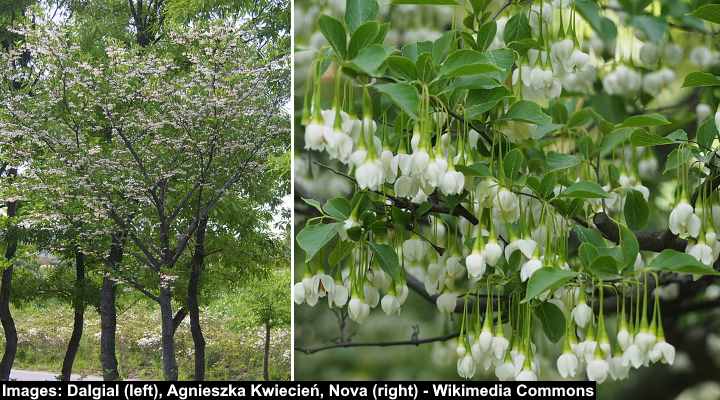
Japanese snowbell is a small tree that sheds its leaves in the winter and is known for its delicate bell-shaped white flowers. These beautiful flowers have yellow stamens and emit a pleasant fragrance, hanging in clusters from the branches. As autumn approaches, the tree’s dark green leaves turn a lovely shade of yellow, enhancing its visual appeal.
In addition to its beautiful white flowers, the Japanese snowbell features attractive bark that peels off, revealing a smooth trunk with a cinnamon-like color.
Japanese snowbell trees thrive in acidic, well-draining soils that are rich in organic matter. When protected from cold winds, these elegant trees can be successfully grown in woodland gardens, containers, or as individual focal points. They require minimal maintenance and are generally not prone to significant pest or disease issues.
Mature Size: 20 to 30 ft. (6 – 9 m) tall and wide
USDA Hardiness Zones: 6 to 8
Sun: Partial shade
Northern Catalpa Tree (Catalpa speciosa)

The northern catalpa tree is a deciduous tree that is easily recognizable by its large heart-shaped leaves and clusters of white, trumpet-shaped flowers. These white flowers, which bloom in the spring, have purple speckles and yellow blotches. After the attractive flowers fade, long seed pods resembling beans appear. As autumn arrives, the tree’s leaves transition to a yellow color, providing additional visual interest.
Northern catalpa trees are versatile and can thrive in various soil types, including clay, loam, and sandy soils. They are well-suited to be used as shade trees or as focal points in large landscapes.
Mature Size: 50 to 70 ft. (15 – 21 m) tall and 20 to 50 ft. (6 – 15 m) wide
USDA Hardiness Zones: 4 to 8
Sun: Full sun to partial shade
Horse Chestnut (Aesculus hippocastanum)
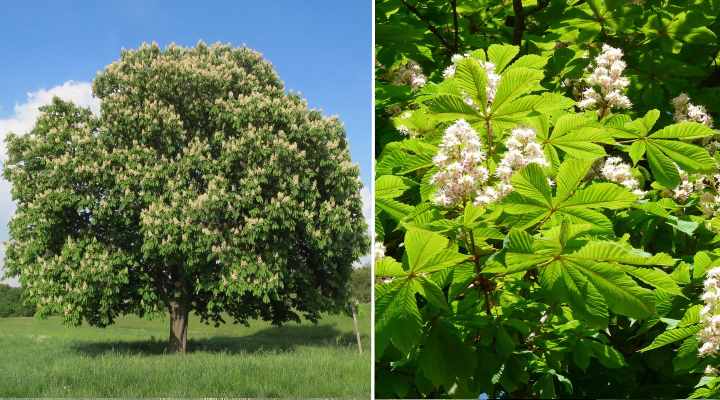
Horse chestnut trees are easily identified by their tall, upright clusters of white flowers and large, uniquely-shaped leaves. The pinkish-white flowers bloom in late spring, forming cone-like clusters that reach a height of 12 inches (30 cm). The broad, palmately compound leaves of the tree display a beautiful yellow or orange color during the fall season.
Horse chestnut trees are relatively easy to care for and require minimal maintenance. Given their large size, they are best suited as shade trees or decorative trees in spacious landscapes or park areas.
One distinct characteristic of horse chestnut trees is their spiny capsules which contain shiny brown nuts. These capsules add to the tree’s unique appearance and natural charm.
Mature Size: 50 to 75 ft. (15 – 23 m) tall and wide
USDA Hardiness Zones: 3 to 8
Sun: Full sun or partial shade
Ohio Buckeye Tree (Aesculus glabra)
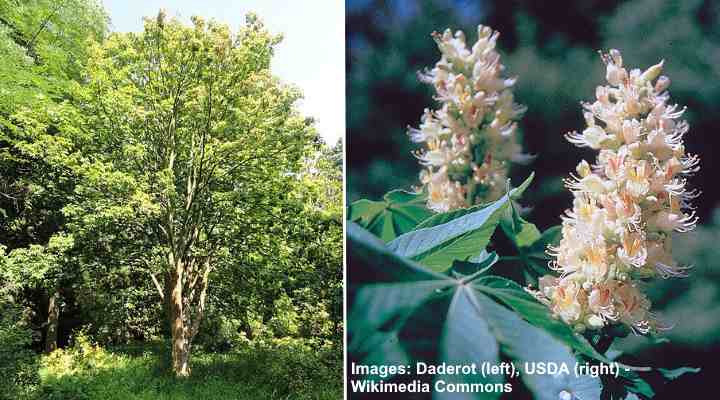
The Ohio buckeye tree is renowned for its eye-catching white flowers, palmate leaves, and distinctive fruit that resembles a buck’s eye. Similar to horse chestnut trees, this deciduous tree produces cone-shaped clusters of white, tube-shaped flowers during the spring season. Following the bloom, these flowers develop into round, spiky fruit capsules that house glossy brown nuts.
Also referred to as the Texas buckeye, these towering and expansive trees thrive in well-drained, moist, and fertile soil. They are highly valued for their ability to provide shade, their attractive spring blossoms, and their dense foliage. As native trees in the southern regions of the United States, buckeye trees are commonly found in parks and open landscapes.
Mature Size: 20 to 40 ft. (6 – 12 m) tall and wide
USDA Hardiness Zones: 3 to 7
Sun: Full sun or partial shade
White Fringe Tree (Chionanthus virginicus)
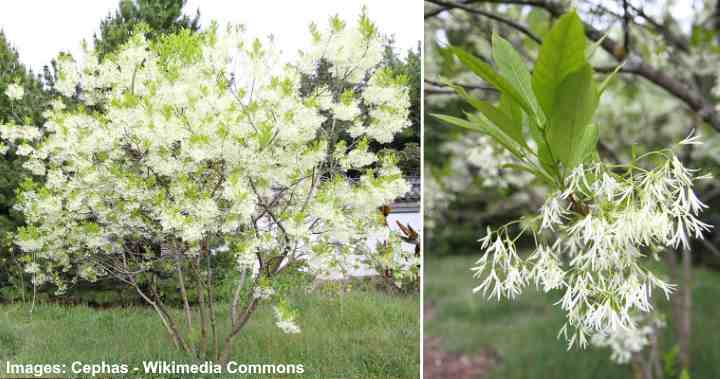
The white fringe tree, native to the eastern regions of the United States, is characterized by its abundant clusters of fragrant cream-white flowers. These attractive fringe-like flowers, with their delicate wiry petals, bloom during the spring season. The fringe tree has lance-shaped leaves that transition to a shade of yellow in the fall. During the summer, clusters of dark blue fruits will appear, as well as a blanket of white petals beneath the tree.
The white fringe tree thrives in areas that receive full sun to partial shade, showcasing its adaptability to varying lighting conditions. However, to promote optimal growth and abundant flowering, it is advisable to provide the tree with at least six hours of direct sunlight per day.
White fringe trees are adaptable to various soil types and are easy to cultivate. These small white-flowering trees can be planted in mixed borders, as eye-catching specimen plants, or in groups to create a captivating floral exhibition.
With their stunning white flowers and attractive foliage, white fringe trees serve as an attractive addition to any landscape.
Mature Size: 12 to 20 ft. (3.6 – 6 m) tall and wide
USDA Hardiness Zones: 3 to 9
Sun: Full sun to partial shade
Flowering Dogwood (Cornus florida)
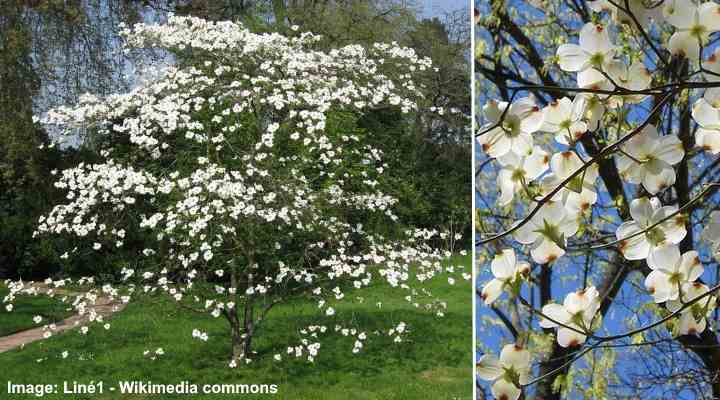
Flowering dogwood is a small deciduous tree known for its attractive white bract-like flowers. White-flowering dogwoods are especially captivating, displaying large, showy star-shaped blooms, complemented by dark green leaves. During summer, the tree produces bright red berries, while in fall, it transforms into shades of purple and dark red. In addition, its unique bark resembling alligator skin adds to its appeal throughout all four seasons.
Flowering dogwoods thrive in well-drained, acidic soil and prefer partial shade. These small decorative white flowering trees also do well as understory trees in woodland gardens. Consider planting them in your front or backyard, near patios or lawns, to enhance their visual impact.
Many gardening enthusiasts consider white dogwoods among the most attractive small flowering trees, making them a popular choice for any landscape.
Mature Size: 15 to 30 ft. (4.5 – 9 m) tall and wide
USDA Hardiness Zones: 5 to 9
Sun: Partial shade
Giant Dogwood (Cornus controversa)
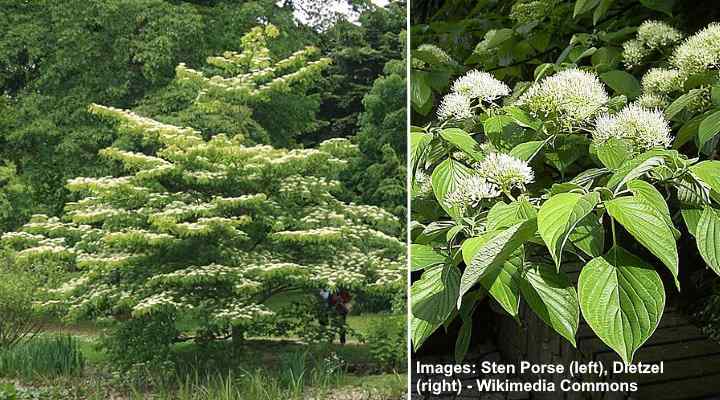
The giant dogwood tree stands out as one of the most beautiful white-flowering specimens. With an abundance of creamy-white flowers, vibrant green or variegated leaves, and alluring black berries, the giant dogwood delivers an attractive floral display. Its horizontal branches are layered, resembling tiers of a wedding cake, earning it the fitting nickname of the “wedding cake tree.”
Thriving in organically fertile, acidic, and well-drained soil, the giant dogwood has a compact growth habit. This exceptional tree serves as an ideal focal point or specimen in small to medium-sized gardens, while also offering shade and ornamental value in larger landscapes. In addition, it attracts a variety of birds, as its berries serve as a valuable food source.
Mature Size: 30 to 40 ft. (9 – 12 m) tall and wide
USDA Hardiness Zones: 5 to 8
Sun: Partial shade to full sun
Tea Plant (Camellia sinensis)
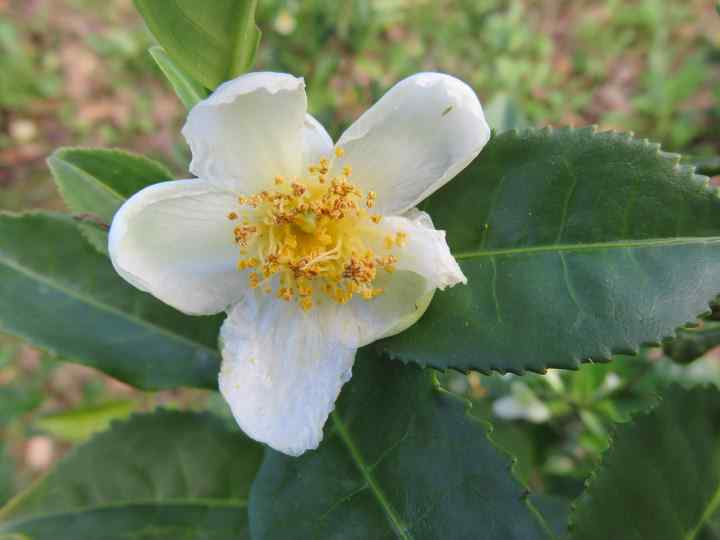
The tea plant, an evergreen shrub or small tree, has charming white flowers alongside its aromatic tea leaves. Although not recognized for their blossoms, tea plants bear beautiful, small white flowers with yellow centers. With glossy green foliage and fragrant white blooms, tea plants serve as splendid additions to shaded areas of your garden, lending a touch of elegance to the landscape.
Thriving in acidic, well-drained, and consistently moist soils, tea plants are particularly well-suited for temperate climates. Whether grown in containers or directly in the ground, they offer versatility in cultivation. Beyond their visual attractiveness, tea plants also provide the added benefit of their leaves being suitable for preparing various types of tea.
Mature Size: 10 to 15 ft. (3 – 4.5 m) tall and 6 to 10 ft. (1.8 – 3 m) wide
USDA Hardiness Zones: 7 to 9
Sun: Partial shade
Japanese Lilac Tree (Syringa reticulata)
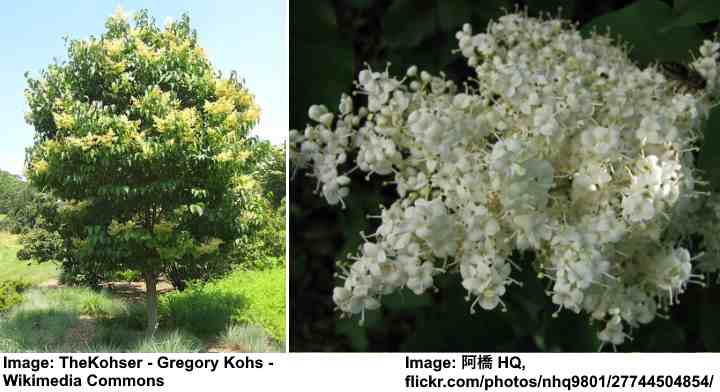
The Japanese lilac tree is a deciduous tree of small to medium size which is renowned for its clusters of fragrant and creamy-white flowers. Distinctive features of the Japanese lilac include its reddish-brown bark that peels and its dark green leaves with sharp tips. During early summer, the tree features white lilac flowers, which bloom for several weeks and create a captivating floral spectacle.
Japanese lilac trees thrive in various soil conditions such as clay and sandy soils. These small trees are excellent choices for foundation plantings, specimen trees, or enhancing the beauty of any landscape. With their low-maintenance nature, they are ideal for garden landscapes in temperate and cooler climates.
Mature Size: 20 to 30 ft. (6 – 9 m) tall and 15 to 25 ft. (4.5 – 7.5 m) wide
USDA Hardiness Zones: 3 to 7
Sun: Full sun to partial shade
American Elderberry (Sambucus canadensis)
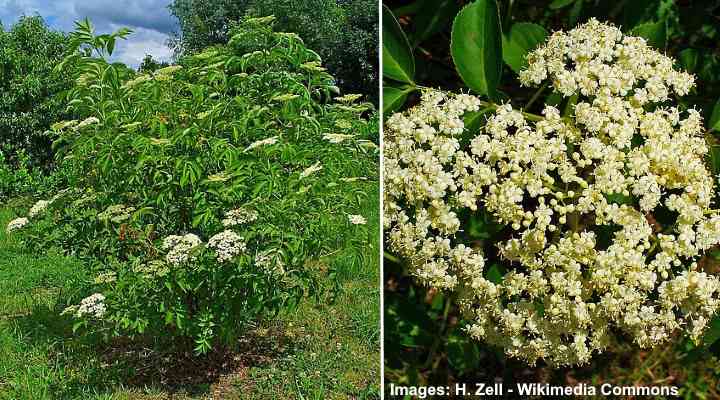
The American elderberry is a deciduous shrub or small tree, known for its clusters of small, fragrant white flowers in spring. The flat-topped flower clusters provide a pleasing contrast against the lush, lance-shaped green leaves. After the flowering period, glossy edible black berries form in clusters. In addition, American elderberries are renowned for their rapid growth rate.
Elderberries are native to North America and thrive in wetland areas, along stream banks, and within open woodlands. This resilient shrub can be trained to grow as a tree or allowed to develop into a bushy plant, forming an informal screen or hedge. The fragrant white flowers attract pollinators, while the berries act as a magnet for birds and other wildlife.
Mature Size: 5 to 12 ft. (1.5 – 3.7 m) tall and wide
USDA Hardiness Zones: 3 to 9
Sun: Full sun to partial shade
Whitebeam (Sorbus aria)
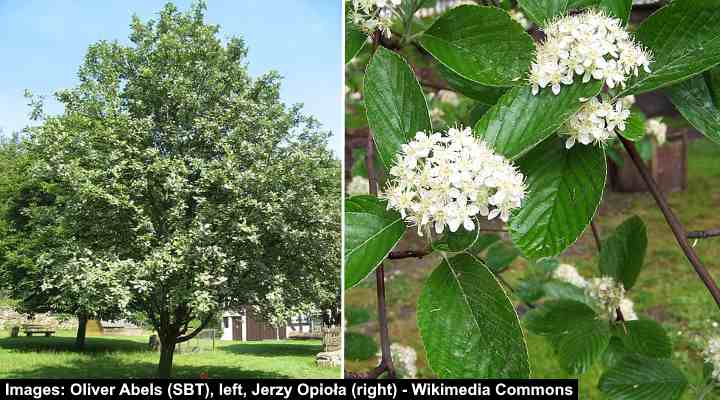
The whitebeam is a deciduous tree adorned with beautiful, creamy-white flowers. Notable characteristics of this tree include its leaves with a silvery and fuzzy underside, clusters of white flowers in spring, and small red berries that appear in the autumn. Whitebeam trees have oval-shaped leaves with a distinct silvery-white underside, from which they derive their name. Because of their unique foliage, these trees offer ornamental appeal throughout all four seasons.
Whitebeam trees are known for their adaptability, thriving in various well-drained soil types such as clay, loam, and sandy soil. Apart from their landscaping features, whitebeam trees provide crucial habitat and a source of food for wildlife.
Whether used as specimen trees, incorporated into hedgerows, or as part of mixed plantings, whitebeam trees prove to be excellent choices for landscaping purposes.
Mature Size: 25 to 30 ft. (8 – 9 m) tall and up to 25 ft. (8 m) wide
USDA Hardiness Zones: 4 to 7
Sun: Full sun to partial shade
Swedish Whitebeam (Sorbus intermedia)
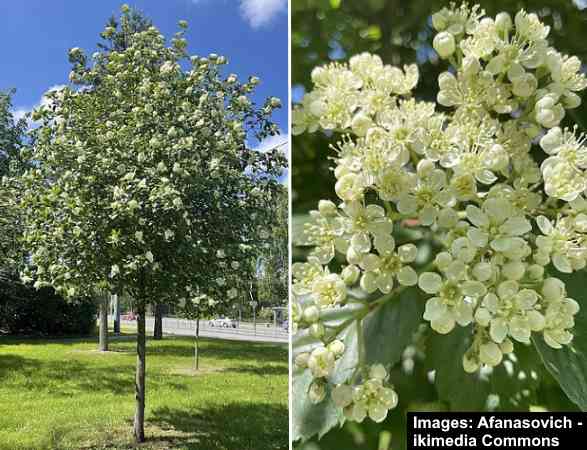
Originating from Northern Europe, the Swedish whitebeam is a captivating addition to any landscape with its attractive white flowers. Distinguished by its deeply-lobed dark green leaves, profuse clusters of brilliant tiny white flowers, and vibrant red berries, this tree showcases its recognizable features. Its rounded crown has dense foliage that transitions to a vibrant yellow hue during the autumn season.
The Swedish whitebeam demonstrates exceptional hardiness, capable of withstanding a wide range of environmental conditions. Thriving in urban settings and salty air, this white-flowering tree proves suitable for planting in cities or coastal areas. It also serves as an excellent shade tree within vast, open landscapes.
Mature Size: 30 to 40 ft. (9 – 12 m) tall and wide
USDA Hardiness Zones: 5 to 8
Sun: Full sun or partial shade
Devilwood (Cartrema americanus)
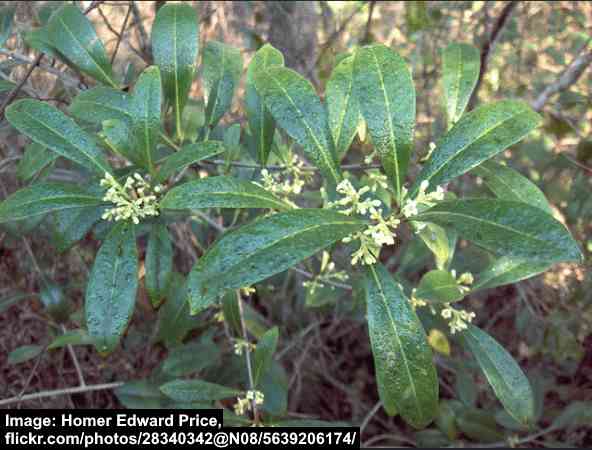
The devilwood, also known as American olive, is a small evergreen tree that is native to the southeastern United States. This tree reveals fragrant white flowers, infusing any garden or landscape with a delightful scent. In addition, the devilwood tree has green leaves with curvy edges and dark blue fruits. The small white flowers bloom during the late spring season and serve to further enhance the tree’s beauty.
The name devilwood derives from the tree’s robust, dense wood, known for its strength and toughness. To facilitate optimal growth, it is advisable to plant this tree in moist, well-drained soils. Devilwood trees make exceptional additions to small gardens due to their dense foliage and captivatingly scented flowers. They serve as outstanding specimen plants or natural barriers, adding beauty and functionality to outdoor spaces.
Mature Size: 10 to 30 ft. (3 – 9 m) tall and wide
USDA Hardiness Zones: 6 to 9
Sun: Full sun to deep shade
Black Locust (Robinia pseudoacacia)
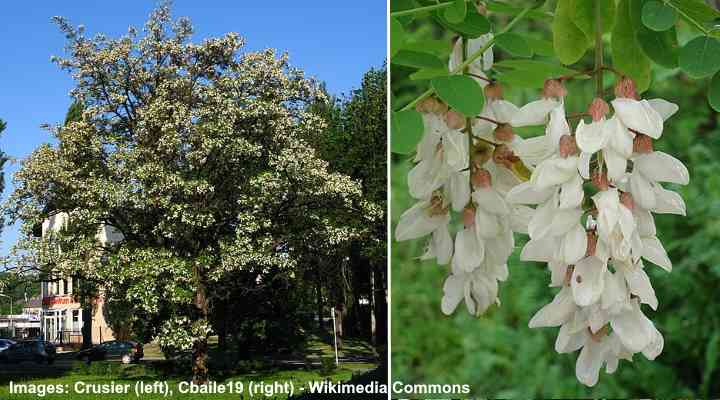
The black locust is a deciduous tree recognized for its thorny bark and clusters of fragrant white flowers during spring. The tree bears abundant white pea-like flower clusters that hang gracefully from its dark branches. Its foliage is a vibrant green color, featuring large compound leaves composed of small oval leaflets. During autumn, the leaves turn a pleasing shade of yellow.
Originating from North America, black locust trees, with their spiny bark, are known for their ability to thrive in challenging conditions. These trees have a fast growth rate and grow well in dry to medium soils with excellent drainage.
Other distinctive features of black locust trees include deeply furrowed rough bark, elongated flat purplish-brown seed pods, and snow-white flowers.
Mature Size: 30 to 50 ft. (9 – 15 m) tall and wide
USDA Hardiness Zones: 4 to 9
Sun: At least six hours of sunshine daily
Allegheny Serviceberry (Amelanchier laevis)

The Allegheny serviceberry is a deciduous tree known for its beautiful white flowers and edible berries. This tree’s ornamental features include clusters of small, star-shaped white flowers, leaves that emerge with a purplish-bronze hue, and blue-black summer berries. With its smooth bark and delicate branching pattern, this white-flowering deciduous tree offers visual appeal throughout all four seasons.
Native to North America, the Allegheny serviceberry thrives in well-drained, acidic soil. It demonstrates great adaptability, tolerating various conditions, including clay soil and urban environments. As a small ornamental tree, it can be used as a specimen tree, flowering hedge, privacy screen, or as an addition to native plant gardens.
Mature Size: 15 to 25 ft. (4.5 – 7.5 m) tall and wide
USDA Hardiness Zones: 4 to 9
Sun: Full sun to partial shade
Shadblow Serviceberry Tree (Amelanchier canadensis)
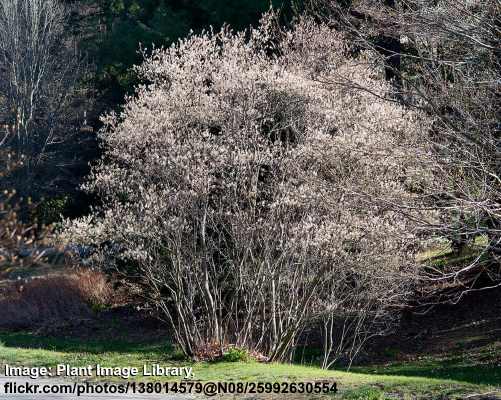
The shadblow serviceberry, also known as the Canadian serviceberry and thicket serviceberry, is a small tree with a shrub-like appearance. During March and April, it produces clusters of white flowers. These fragrant flowers emerge from pink buds in early spring, with their five petals spreading outwards in a star shape.
The shadblow serviceberry has dark green oblong leaves with finely-toothed edges and produces edible purple berries. Its bark is smooth initially but develops furrows as the tree matures. Thriving in partial shade and moist soil, this tree is well-suited to such conditions.
To cultivate the shadblow serviceberry as a specimen tree, it is recommended to remove the suckers during winter. As the tree grows, it forms a dome-shaped crown that becomes adorned with delicate aromatic flowers in early spring. It can be grown as a specimen tree or used as a flowering living fence.
Mature Size: 15 to 25 ft. (4.5 – 7.5 m) tall and up to 20 ft. (6 m) wide
USDA Hardiness Zones: 3 to 8
Sun: Full sun with some afternoon shade
Angel’s Trumpet (Brugmansia suaveolens)
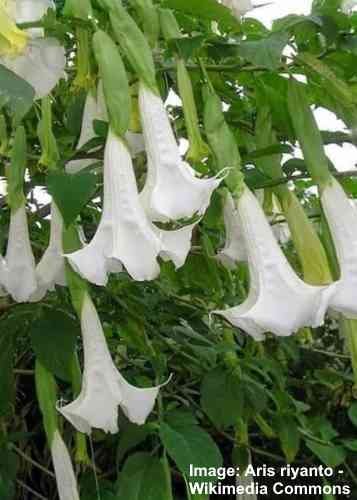
Angel’s trumpet is easily recognizable by its large, trumpet-shaped white flowers that hang from the branches. This captivating shrub or small tropical tree blooms from summer to fall, displaying a vibrant vase-like shape. It has mid-green leaves and highly fragrant funnel flowers, with exotic white blooms measuring an impressive 12 inches (30 cm) in length.
Native to South America, angel’s trumpet thrives in warm climates. It thrives best in organically rich and fertile soil that provides good drainage. This tropical tree is ideal for enhancing beds and borders, serving as an attractive specimen plant, or adding an exotic touch to decks and patios.
All parts of the angel’s trumpet tree are toxic if ingested, so it is important to be cautious when planting this tree in landscapes where children or pets may come into contact with it.
Mature Size: 3 to 8 ft. (1 – 2.4 m) tall and 2 to 4 ft. (0.6 – 1 m) wide
USDA Hardiness Zones: 9 to 11
Sun: Full sun or partial shade
American Yellowwood (Cladrastis kentukea)
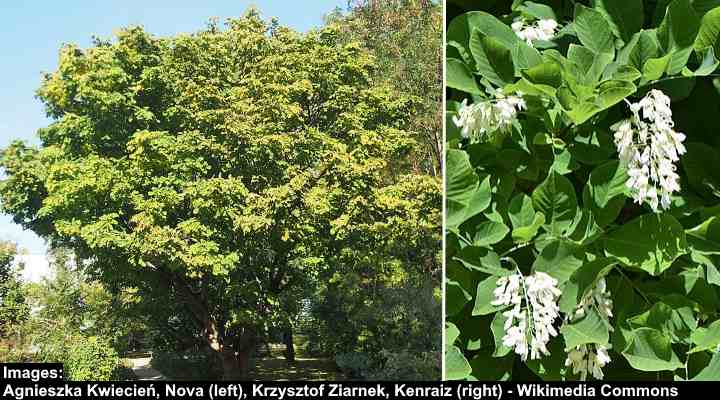
The American yellowwood is a deciduous tree native to the southeastern United States. This tree has ornamental qualities, including clusters of lovely fragrant white flowers, yellowish-green leaves that transform into bright yellow hues during the fall, and dangling seed pods. The white flowers, resembling peas, hang in long, drooping clusters, offering a beautiful display throughout the summer season.
To thrive, American yellowwood trees require moist, well-drained soil and full sun exposure. They are well-suited as lawn trees, planted near patios and decks, or used as shade trees in medium to large backyards.
Mature Size: 30 to 50 ft. (9 – 15 m) tall and 40 to 55 ft. (12 – 15 m) wide
USDA Hardiness Zones: 4 to 8
Sun: Full sun
Japanese Stewartia (Stewartia pseudocamellia)

The Japanese stewartia, also known as the false camellia, is a deciduous tree adorned with captivating white flowers resembling camellias. These flowers feature a yellow center and bloom during the late spring to the early summer period. As autumn arrives, the tree’s dark green leaves turn into vibrant shades of orange, red, and purple that create a captivating display of fall colors.
Native to Japan, the plant features several trunks that branch close to the ground, giving the tree a sizable and dense bush-like form.
Japanese stewartia trees thrive when planted in well-drained, acidic soil and prefer partial shade to full sun exposure. They require relatively low maintenance and can be utilized as striking specimen trees or arranged in groups for an impactful effect. In addition, the tree’s attractive bark has exfoliating patches that unveil a beautiful mosaic pattern.
Mature Size: 20 to 40 ft. (6 – 12 m) tall and wide
USDA Hardiness Zones: 5 to 8
Sun: Partial shade to full sun
Discover many other types of white flowering trees to plant in your garden landscape.
Types of Purple Flowering Trees (With Pictures)
Jacaranda Tree (Jacaranda mimosifolia)
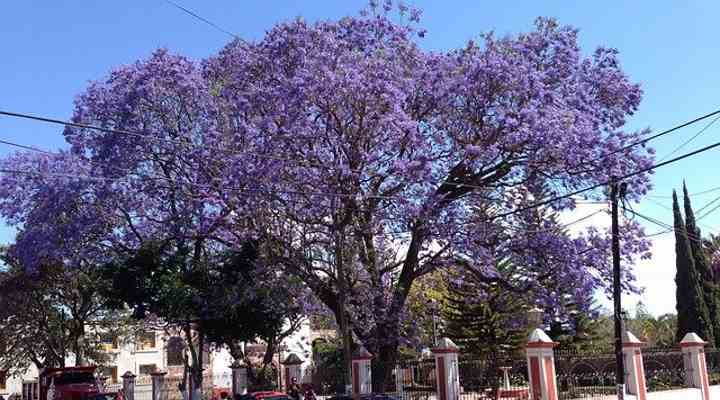
The jacaranda tree is an eye-catching ornamental tree known for its clusters of vibrant purple-blue flowers. These trumpet-shaped blossoms create a striking floral exhibition that covers the tree throughout the spring and early summer. The blue-violet flowers beautifully blanket the tree’s broad canopy, resembling an umbrella. As the flowers fade, the tree produces decorative flattened seed pods of a rich mahogany color.
The tree’s foliage consists of fern-like leaves, which display a vibrant shade of green, serving as a beautiful backdrop to the tree’s colorful flowers. Depending on the climate, jacaranda trees can be evergreen, semi-evergreen, or deciduous. These purple-flowering trees flourish in warm tropical climates and prefer well-draining soil.
Jacaranda trees are highly valued as ornamental shade trees, offering an exquisite visual presence. They can also be grown as focal points within garden landscapes. The tree’s delicate flowers and elegant structure make it a favored choice for gardens and parks.
Mature Size: 25 to 50 ft. (7.5 – 15 m) tall and 15 to 30 ft. (4.5 – 9 m) wide
USDA Hardiness Zones: 10 and 11
Sun: Full sun
Chaste Tree (Vitex agnus-castus)
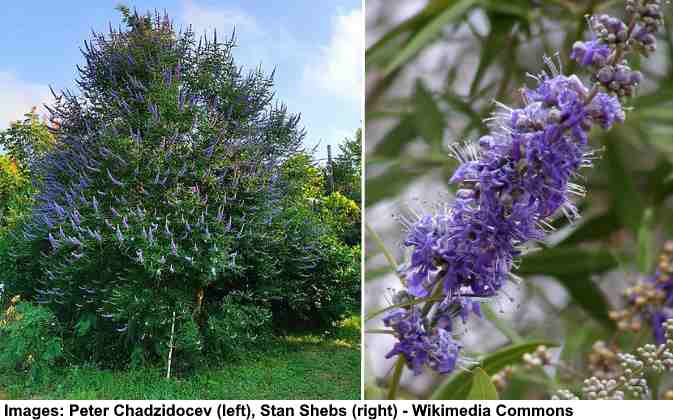
The chaste tree is a small tree or shrub highly valued for its beautiful, spiky clusters of fragrant purple flowers. These lilac or pale blue flowers grow on the tree’s vase-shaped canopy, providing an appealing display throughout the summer. Following the flowers, small round black fruits resembling peppercorns appear.
The tree is alternatively known as the monk’s pepper or the lilac chaste tree.
The chaste tree’s aromatic dark green leaves are palmate in shape, giving it a tropical appearance. Each leaf consists of five to seven leaflets, with silvery undersides that shimmer in the breeze. With its dense foliage and prolonged blooming period, this small ornamental tree holds significant appeal in any landscape.
Chaste trees are well-suited for various landscaping purposes, such as shrub borders, foundation plantings, or as standalone specimens. Once established, they are drought-tolerant and resistant to most pests and diseases. The fragrant purple flowers attract butterflies and other pollinators during the summer season.
Mature Size: 4 to 15 ft. (1.2 – 4.5 m) tall and wide
USDA Hardiness Zones: 6 to 9
Sun: Full sun
Texas Mountain Laurel Tree (Sophora secundiflora)
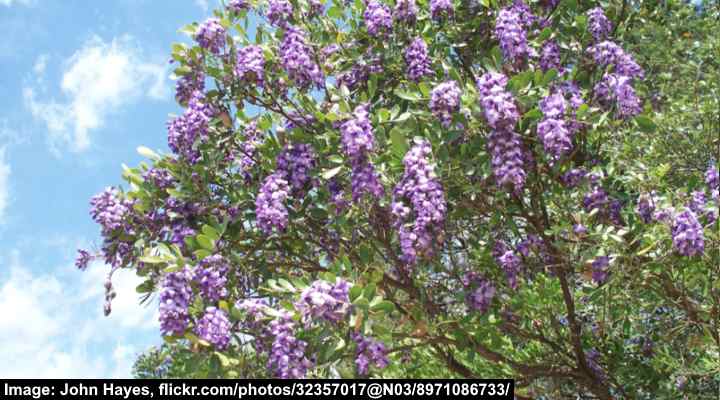
The Texas mountain laurel is a small evergreen tree renowned for its clusters of fragrant pale purple flowers. These grape hyacinth-like flowers bloom in late winter or early spring, showcasing their purple-lavender hues. Growing in drooping clusters measuring 3 to 7 inches (7.5 – 18 cm) long, they serve as a beautiful attraction for bees and butterflies.
As a native tree of North America, the Texas mountain laurel features leathery dark green leaves that form dense foliage, consisting of palmate leaves with oval leaflets. In addition, the tree is drought-tolerant and thrives in well-draining soil.
This small purple-flowering tree thrives as an ornamental addition to xeriscape gardens or as a captivating focal point in small landscapes. With its attractive flowers and evergreen foliage, the Texas mountain laurel tree brings a touch of beauty to any garden setting.
Mature Size: 10 to 15 ft. (3 – 4.5 m) tall and 8 to 15 ft. (2.5 – 4.5 m) wide
USDA Hardiness Zones: 7 to 11
Sun: Full sun to partial shade
Texas Redbud Tree (Cercis canadensis var. texensis)
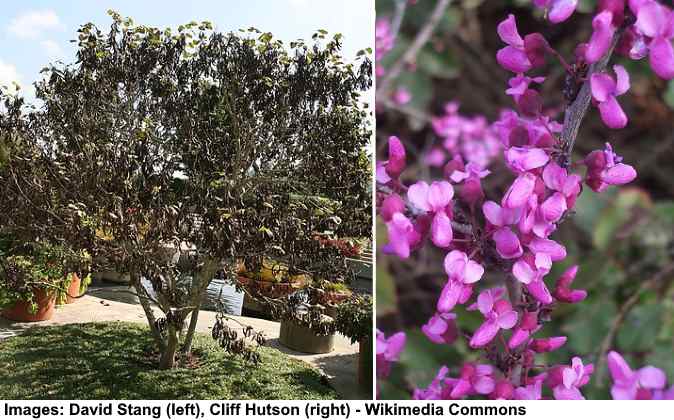
The purple flowering Texas redbud tree is an attractive small ornamental tree known for its clusters of magenta-purple flowers. In early spring, these pea-like flowers burst into vibrant color, covering the bare branches before the leaves emerge. The pink-purple flowers continue to bloom as the leaves develop, adding to the tree’s beauty.
The Texas redbud tree can be recognized by its heart-shaped leaves and abundant purple, pink, or deep reddish-purple flowers. The dark green foliage transforms into a lovely yellow hue in the fall. This versatile tree can thrive in various soil types, including clay, loam, and sandy soils.
Ideal for small to medium-sized landscapes, this Texas native tree brings charm as an ornamental tree, adding a vibrant touch to urban gardens or creating a delightful flowering border. Its stunning flowers provide a vivid display of color during the early spring season.
Mature Size: 12 to 18 ft. (3.6 – 5.5 m) tall and 10 to 15 ft. (3 – 4.5 m) wide
USDA Hardiness Zones: 6 to 9
Sun: Full sun or partial shade
Eastern Redbud ‘Forest Pansy’ (Cercis canadensis ‘Forest Pansy’)
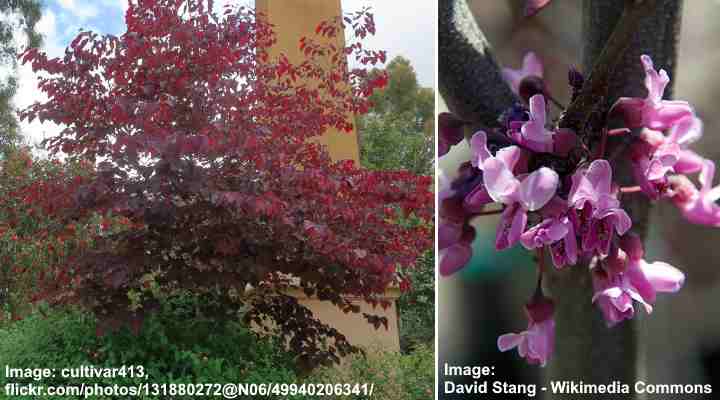
The eastern redbud cultivar known as ‘Forest Pansy’ is a charming deciduous tree with clusters of beautiful pinkish-purple flowers. Like all redbuds, this cultivar blooms abundantly in early spring, covering its bare branches with delightful pea-sized flowers. These cheerful purplish flowers attract butterflies, bees, and other pollinators, adding life to the garden.
The ‘Forest Pansy’ redbud has vibrant heart-shaped leaves that emerge in late spring. The leaves come in a captivating range of colors, including orange, red, red-purple, and bronze. The eastern redbud’s appeal lies in its lovely purple flowers, bright red foliage, and distinctive flat-topped vase-shaped canopy.
The ‘Forest Pansy’ variety of the eastern redbud is highly sought-after for its ability to bring color and year-round interest to landscapes. It can be planted as a specimen tree, providing a focal point, or used to create shade over a patio or decking area. Its compact size also makes it ideal for small gardens or urban environments, where it adds vibrant foliage and bursts of purple color in early spring.
Mature Size: 20 to 30 ft. (6 – 9 m) tall and 25 to 35 ft. (7.5 – 10.5 m) wide
USDA Hardiness Zones: 5 to 9
Sun: Full sun to partial shade
Purple Glory Tree (Tibouchina granulosa)
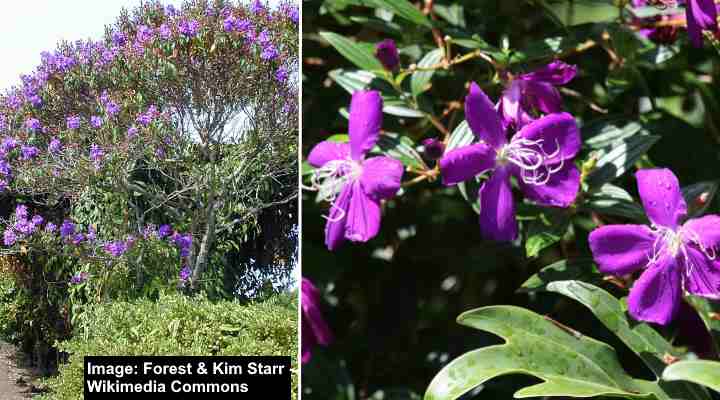
The purple glory tree is a tropical tree that adds beauty to any garden with its charming violet-purple flowers. These eye-catching flowers cover the tree’s canopy, creating a vibrant and colorful display throughout the year. The large flowers have a velvety texture and stand out against the glossy, dark green lanceolate leaves.
The purple glory tree thrives in warm, tropical climates and prefers moist, well-drained soil that is rich in organic matter. It is important to provide some shade from the intense afternoon sun in hotter regions.
This versatile tree can be grown as a specimen tree, trained against a wall as an espalier, or allowed to climb over a trellis or arbor like a vine. Its adaptability makes it a great choice for mixed shrub borders or container gardening.
Mature Size: 15 to 20 ft. (4.5 – 6 m) tall and wide
USDA Hardiness Zones: 10 and 11
Sun: Full sun to partial shade
Princess Flower Tree (Tibouchina urvilleana)
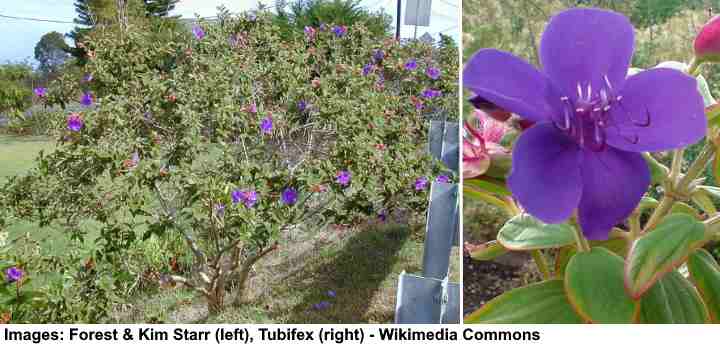
The princess flower is a tropical evergreen shrub or small tree that adds beauty to your garden with its captivating purple flowers. These large, velvety blooms display a vibrant shade of purple and consist of five petals. From late summer to early fall, the plant becomes a stunning spectacle of color as it becomes covered in these attractive flowers.
The princess flower features dark green leaves that are glossy and have longitudinal veins, as well as wiry stamens.
When grown as a small tree, the princess flower becomes a beautiful focal point near a patio or lawn, adding a burst of dynamic color. As a shrub, you can use princess flower trees to create borders, edging, container gardens, or foundation plantings, while also attracting butterflies to your garden.
Mature Size: 10 to 20 ft. (3 – 6 m) tall and 6 to 10 ft. (1.8 – 3 m) wide
USDA Hardiness Zones: 9 to 11
Sun: Full sun to partial shade
Purple Orchid Tree (Bauhinia purpurea)

The purple flowering orchid tree is a fast growing tropical tree that can be identified by its stunning purple orchid-like flowers. These vibrant flowers, with their bright purple or pink hues and five petals, bloom in large clusters. From September through November, the purple orchid tree fills fall landscapes in the deep South with its exquisite colors.
The tree’s glossy, green leaves cover the gracefully arching branches and have a unique shape resembling butterfly wings or hearts. Another appealing feature of this deciduous tree is its long, flattened seed pods that measure 12 inches (30 cm) long and persist through the winter.
Purple orchid trees are perfect for adding beauty to gardens and parks as ornamental shade trees. With their moderately compact growth, they also make wonderful patio trees in southern landscapes. The tree’s attractive flowers and distinctive leaves make it a popular choice for bringing a touch of tropical beauty to any landscape.
Mature Size: 30 to 35 ft. (9 – 10 m) tall and wide
USDA Hardiness Zones: 10 and 11
Sun: Full sun and well-drained soil
Susan Magnolia (Magnolia Susan)
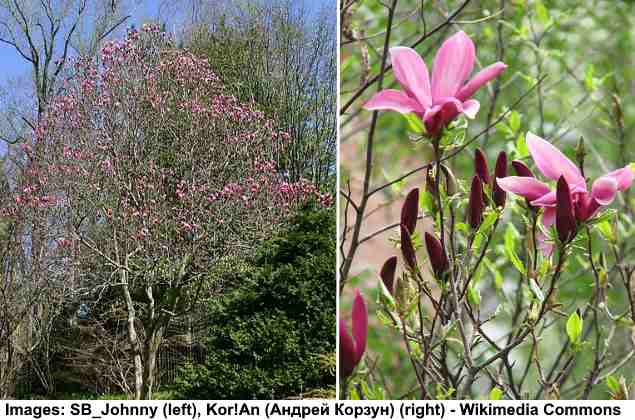
The Susan magnolia is a small tree with attractive purple-pinkish flowers that bloom in spring. These fragrant flowers, resembling tulips, may continue to bloom sporadically throughout the summer. Each flower has cup-shaped petals, with six twisted petals measuring 5 inches (13 cm) in length. The outer side of the petals is dark purple, while the inner side is paler in color.
The magnolia tree’s ovate, dark green leaves provide a beautiful backdrop to the vibrant flowers. In the fall, the leaves turn a shade of yellow before they drop. With its compact size, the Susan magnolia is well-suited for small gardens, city gardens, or as a focal point in a landscape.
This tree is low maintenance and can tolerate various soil types, though it prefers well-drained and organically rich soil. To ensure optimal growth, it is recommended to provide shelter from cold winds.
Mature Size: 8 to 12 ft. (2.4 – 3.6 m) tall and wide
USDA Hardiness Zones: 3 to 8
Sun: Full sun to partial shade
Purple Flowering Dogwood (Cornus florida ‘Purple Glory’)

The purple flowering dogwood is a small and visually striking tree highly valued for its vibrant purple flowers. These flowers, which resemble colorful petals, are actually reddish-purple bracts that emerge in spring. The ‘Purple Glory’ cultivar of the dogwood tree features dark purple leaves, adding to its impressive ornamental appeal. During the autumn season, the tree’s foliage transitions to a captivating black-purple color.
With its fast growth rate and compact size, the purple flowering dogwood forms a rounded canopy. Even when exposed to full sun, the tree retains its deep and dramatic colors until the leaves eventually drop in autumn. These qualities make the purple flowering dogwood a popular choice for small gardens, lawns, and patios. Additionally, it can serve as an eye-catching accent tree in larger landscapes.
The purple flowering dogwood is adaptable to different soil types, including clay, loam, and sandy soils. For optimal growth, the tree prefers well-drained soil and partial shade, although it can tolerate full sun if provided with sufficient moisture.
Mature Size: 15 to 20 ft. (4.5 – 6 m) tall and wide
USDA Hardiness Zones: 5 to 9
Sun: Partial shade
Common Lilac (Syringa vulgaris)
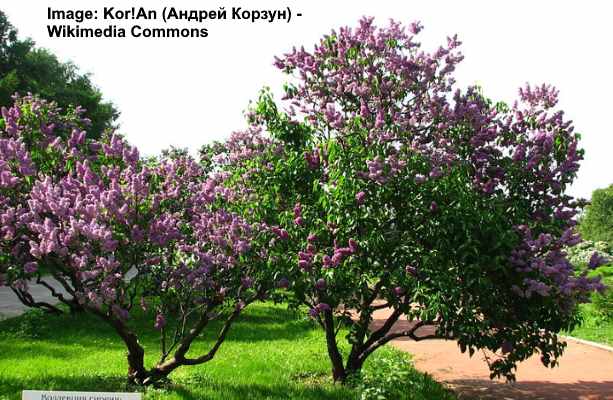
The common lilac is a shrub with purple flowers that can also be shaped into a small tree. It has a bushy growth habit and showcases fragrant, cone-shaped clusters of purple flowers on its gracefully arching branches. These delightful flowers bloom from late spring to early summer, enveloping the shrub in a captivating array of lilac hues and releasing a pleasant floral aroma. In addition to purple, lilac trees can produce flowers in charming shades of white, pink, and blue.
The leaves of the common lilac are heart-shaped and range in color from dark green to blue-green. With its dense and attractive foliage, this shrub-like tree is well-suited for use as a hedge, privacy screen, or specimen tree. Dwarf varieties of lilacs can even be grown in containers to add beauty to a deck, patio, or entrance. Common lilacs are resilient to cold weather and can withstand harsh winter conditions.
Highly favored for their low maintenance requirements, drought tolerance, and dependable spring blooms, common lilacs are a popular choice for ornamental planting. Furthermore, their fragrant flowers serve as a magnet for butterflies and bees, making them a beloved attraction for pollinators.
Mature Size: 8 to 10 ft. (2.4 – 3 m) tall and 5 to 6 ft. (1.5 – 1.8 m) wide
USDA Hardiness Zones: 3 to 8
Sun: Full sun for best flowering
Purple Flowering Hibiscus Tree (Hibiscus syriacus ‘Purple Satin’ and ‘Azurri Blue Satin’)
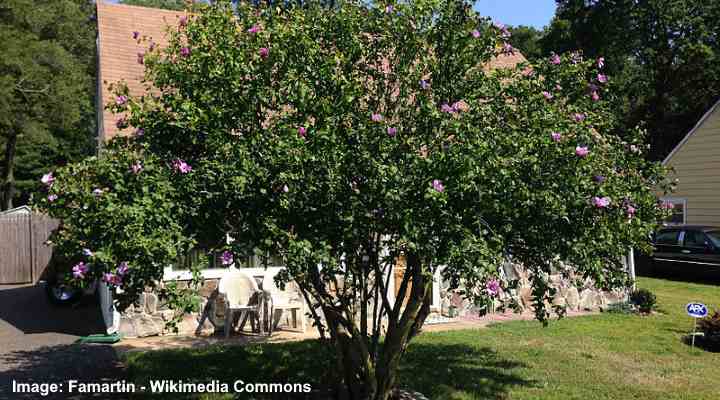
The rose of Sharon, scientifically known as Hibiscus syriacus, is a flowering shrub that can be cultivated as a dwarf ornamental tree. Various hibiscus species display striking and vibrant flowers. These magnificent blooms are generally trumpet-shaped, adorned with frilly petals and a prominent cone-like stamen.
Rose of Sharon specimens that have purple flowers usually reach heights of 8 to 10 ft. (2.4 – 3 m) and have a spread of up to 10 ft. (3 m).
Let’s now provide brief descriptions of three hibiscus trees featuring purple blossoms.
Hibiscus syriacus ‘Purple Satin’: This hibiscus variety showcases deep purple, single flowers that take on a funnel shape. These purple flowers bloom continuously from summer to fall, making them an excellent choice for planting near foundations, creating flowering hedges, or providing privacy screens.
Hibiscus syriacus ‘Azurri Blue Satin’: The purple flowers of the Rose of Sharon display large, funnel-shaped blooms with captivating pale purple petals that have a ruffled appearance. This particular flowering shrub or small tree is well-suited for planting at the back of borders, adding a touch of charm to the landscape.
Hibiscus syriacus ‘First Editions French Cabaret Purple’: With its attractive double purple flowers resembling carnations, this multi-stemmed shrub is perfect for lining foundations, grouping to form a hedge, or enhancing shrub borders.
Purple Robe Locust Tree (Robinia pseudoacacia ‘Purple Robe’)
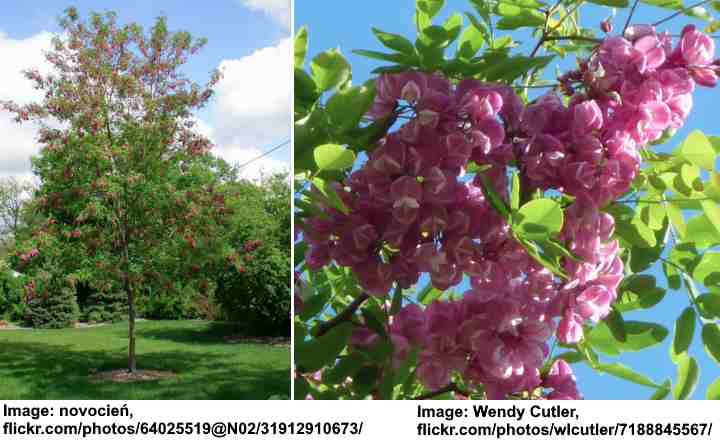
The ‘Purple Robe’ locust tree can be identified by its hanging clusters of fragrant, pea-like violet-purple flowers. These beautiful flowers cover the tree in late spring, showcasing a captivating range of purple shades. Resembling wisteria flowers, the fragrant blooms dangle from the upright branches. Following the flowers, long flattened seed pods resembling beans appear.
The locust tree’s fine, fern-like leaves emerge with a bronze-red hue, gradually transitioning to vibrant green. These pinnate leaves, with their lanceolate leaflets, create an appealing backdrop for the delicate pale purple flowers. As autumn arrives, the foliage takes on a subdued yellow color. Adding to its unique appeal, the tree features thorny stems and branches.
The ‘Purple Robe’ locust tree is a rapid-growing and resilient species that tolerates various soil conditions. It serves excellently as a shade tree or specimen tree in medium-sized garden landscapes. Moreover, the vibrant purple flowers attract bees and butterflies, enhancing the tree’s natural beauty.
Mature Height: 30 to 40 ft. (9 – 12 m) tall and 20 to 30 ft. (6 – 9 m) wide
USDA Hardiness Zones: 4 to 8
Sun: Full sun to light shade
‘Royal Purple’ Smoke Tree (Cotinus coggygria ‘Royal Purple’)
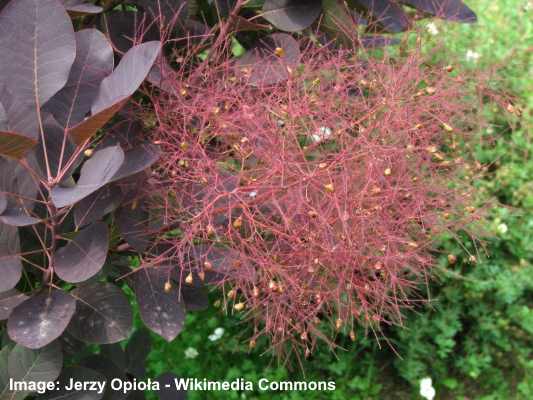
The ‘Royal Purple’ smoke tree is a sizable shrub or small multi-stemmed tree adorned with clusters of pinkish-purple plume-like flowers. Its most unique characteristic is the soft, fuzzy plumes that lend the tree its billowing and ‘smoky’ appearance. These delicate flowers resemble wisps of pink, purple, or white smoke and create a striking display when they bloom in late spring or early summer.
The smoke tree’s foliage is composed of oval-shaped leaves in a rich purple hue, which deepens to a wine purple during the summer months. As autumn arrives, the leaves turn into a vibrant red. The smoke tree’s dark foliage and beautiful puff-like flowers contribute to its visual appeal in the landscape.
Smoke trees are highly versatile and make excellent additions to any garden. Their unique flowers and foliage make them suitable as border plants, informal hedges, privacy screens, or foundation plantings.
Mature Size: 10 to 15 ft. (3 – 4.5 m) tall and 15 to 20 ft. (4.5 – 6 m) wide
USDA Hardiness Zones: 4 to 9
Sun: Full sun to partial shade
Burgundy Desert Willow (Chilopsis linearis ‘Burgundy’)
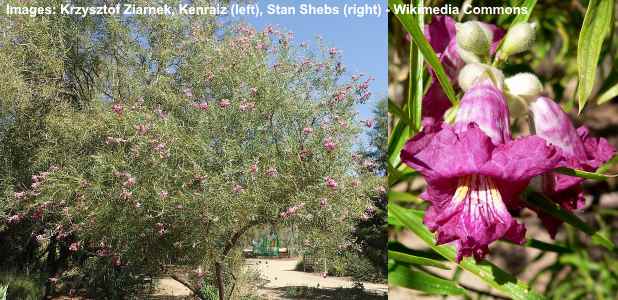
The burgundy desert willow is easily recognizable by its trumpet-shaped flowers which come in shades of burgundy-pink to purple. These vibrant funnel flowers adorn the tree during late spring and early summer, providing a stunning burst of color. In addition, the nectar-filled blossoms are a magnet for hummingbirds and butterflies, enhancing the tree’s appeal.
The burgundy desert willow has long and slender leaves resembling those of a willow, as well as airy foliage that beautifully complements its purplish-pink tubular flowers. This combination creates an eye-catching sight in sunny landscapes. The versatility of the purple-flowering tree allows for planting in xeriscape gardens, desert gardens, wildlife gardens as an accent tree, or for erosion control.
The burgundy desert willow tree stands out not only for its unique color but also for its resilience in the face of drought, heat, and full sun exposure. It also exhibits resistance to most pests and diseases, making it a low-maintenance choice for your garden.
Mature Size: 15 to 20 ft. (4.5 – 6 m) tall and wide
USDA Hardiness Zones: 7 to 9
Sun: Full sun
Purple Flowering Crape Myrtle (Lagerstroemia)

The purple flowering crape myrtle is a stunning small to medium-sized shrub-like tree that adds beauty to any landscape. Crape myrtle trees are admired for their abundant clusters of vibrant purple flowers with crinkled petals. These showy clusters bloom from summer through early fall, displaying shades of purple ranging from deep violet to lavender and pale blue.
Aside from their beautiful purple flowers, crape myrtle trees have other ornamental features. These include smooth bark that peels as well as thick oval leaves with a leathery texture. During the summer, the glossy, dark green foliage enhances the tree’s attractiveness, transitioning to vibrant hues of orange, red, or yellow in autumn, further enhancing its overall charm.
Crape myrtle trees are resilient, can withstand drought conditions, and adapt to various soil types.
Here are several crape myrtle varieties that have purple flowers:
Lagerstroemia ‘Purple Magic’: This stunning crape myrtle cultivar features vibrant purple flowers during the summer season. It is an excellent choice for creating a flowering hedge, foundation planting, or privacy screen. The mature size of this purple crape myrtle tree ranges from 6 to 10 ft. (1.8 – 3 m) in height and width.
Lagerstroemia ‘Early Bird’: This compact crape myrtle shrub can be grown as a small tree and produces clusters of bright purple flowers. As its name suggests, it is one of the earliest crape myrtle varieties to bloom in the season. It reaches a height of 5 to 6 ft. (1.5 – 1.8 m) with a width of 4 ft. (1.2 m).
Lagerstroemia ‘Infinitini Purple’: This compact crape myrtle cultivar showcases abundant clusters of deep purple flowers with crinkled petals, similar in texture to crepe paper. It is an ideal choice for smaller gardens, borders, or foundation planting. The mature size of this small shrub ranges from 3 to 5 ft. (1 – 1.5 m) in height and width.
Lagerstroemia ‘Infinitini Orchid’: This stunning shrub is perfect for landscaping in limited spaces or compact gardens. It features brilliant lavender or crinkled purple flowers that bloom from summer through fall, adding vibrant color to gardens, borders, or containers. It reaches a height and width of 2 to 4 ft. (0.6 – 1.2 m).
Catawba Crape Myrtle (Lagerstroemia indica ‘Catawba’): This beautiful tree or medium-large shrub showcases purple flowers and blooms in late summer. The purple flower clusters create a striking contrast against the glossy green, dense foliage. Mature Catawba crape myrtle trees typically grow between 10 and 15 ft. (3 – 4.5 m) in height and width.
Pride of India (Lagerstroemia speciosa)
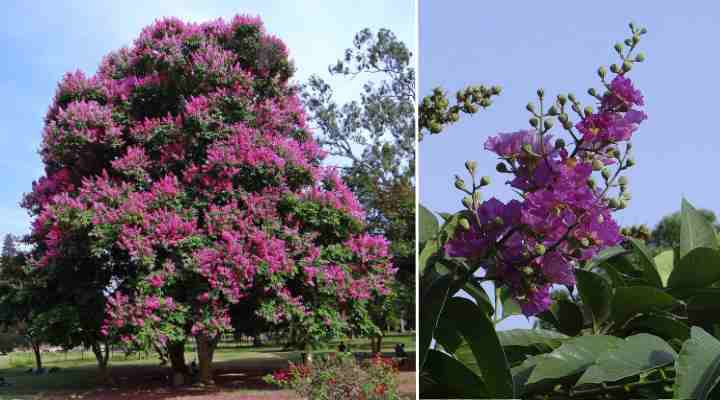
The pride of India is a medium-sized deciduous tree that showcases clusters of vibrant magenta-purple flowers with crinkled petals. It is also known as the giant crape myrtle or Queen’s crape myrtle. These stunning flowers bloom abundantly in late spring and early summer, enhancing the tree’s beauty. The smooth bark and attractive oval leaves further contribute to its ornamental value.
Pride of India trees are highly sought-after for ornamental purposes and are commonly found in parks, gardens, and along streets. With their medium-sized and wide-spreading canopy, they provide excellent shade. The tree’s vibrant, erect panicles (flower clusters) and appealing foliage make it a favored choice for adding color and enhancing the beauty of landscapes.
Mature Size: 40 to 50 ft. (12 – 15 m) tall and wide
USDA Hardiness Zones: 10 and 11
Sun: Full sun
Blue Chinese Wisteria Tree (Wisteria sinensis)

The blue Chinese wisteria tree is an eye-catching ornamental tree known for its draping clusters of fragrant, icy lavender-blue flowers. Blooming from dark purple buds in spring, these blossoms form long, hanging clusters that create a captivating spectacle. The tree’s branches gracefully arch, forming a splendid umbrella-like canopy.
During summer, the tree flaunts glossy, small, dark green leaves that provide a lush foliage backdrop. As autumn arrives, these leaves transform into a captivating golden-yellow hue. To ensure optimal blooming and foliage, it is recommended to cultivate blue Chinese wisteria in well-drained soil and full sun.
The blue Chinese wisteria t is a splendid choice for those seeking to create a striking focal point in a small to medium-sized yard.
Mature Size: 10 to 15 ft. (3 – 15 m) tall and wide
USDA Hardiness Zones: 5 to 9
Sun: Full sun or light shade
Empress Tree (Paulownia tomentosa)

The purple flowering empress tree is a rapid-growing deciduous tree recognized by its pale violet, tube-shaped flowers that emit a delightful vanilla scent. These light purple or lavender flowers bloom in attractive clusters throughout the spring season. Before the large heart-shaped leaves emerge, the funnel-shaped flowers adorn the tree’s bare branches, covering them in a captivating display.
The velvety leaves of the empress tree exhibit a fuzzy texture on both sides. These heart-shaped leaves can reach a diameter of up to 12 inches (30 cm). With its dense and expansive canopy, the tree provides shade during the summer months. As autumn arrives, the leaves transition to a vibrant yellow hue before eventually falling. During this time, long woody seed capsules become visible on the tree.
The empress tree holds significant ornamental value due to its fast growth rate, lush foliage, and fragrant flowers. It can be planted as a standalone specimen tree, arranged in groupings, or utilized as a shrub-like hedge. It thrives in various soil types, requiring consistent moisture and proper drainage.
It’s important to be aware that this non-native tree can potentially become invasive in certain regions of North America.
Mature Size: 40 to 60 ft. (12 – 18 m) tall and wide
USDA Hardiness Zones: 5 to 9
Sun: Full sun
Purple Flowering Crabapple Trees (Malus spp.)
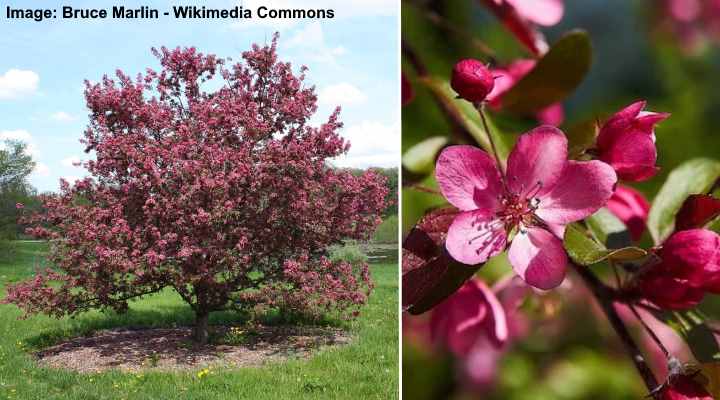
Purple flowering crabapple trees belong to a group of small to medium-sized fruiting trees, some of which display captivating purple flowers. These trees bloom in early spring and cover their branches with abundant flowers that release delightful fragrances. Certain varieties of purple-flowering crabapple trees have striking dark purple leaves and produce small apple-like fruits.
Purple-flowering crabapple trees offer versatility and can be employed in various landscaping arrangements. Whether as standalone focal points, group plantings, or forming rows for hedging purposes, these trees adapt well. They demonstrate resilience, withstanding diverse soil conditions. Additionally, they contribute to the beauty of autumn landscapes by showcasing hues of red, purple, and yellow.
Let’s explore two varieties of small crabapple trees featuring purple flowers:
Malus ‘Kelsey’: This robust crabapple variety blooms in spring, presenting an abundance of semi-double or double purple-red flowers. Its foliage emerges as red in spring, transitions to bronze-green, and transforms into orange and yellow during the fall. With its upright growth and rounded canopy, this small crabapple reaches a height and width of 15 to 18 ft. (4.5 – 5.4 m).
Malus ‘Purple Prince’: This deciduous fruit tree is of small to medium size, featuring a rounded or slightly spreading crown and a dense, compact habit. The tree stands out with its deep purple-to-pink flowers and purple foliage. Thriving in full sun and well-drained soil, the purple prince crabapple reaches a height and width of 18 to 20 ft. (5.4 – 6 m).
Judas Tree (Cercis siliquastrum)
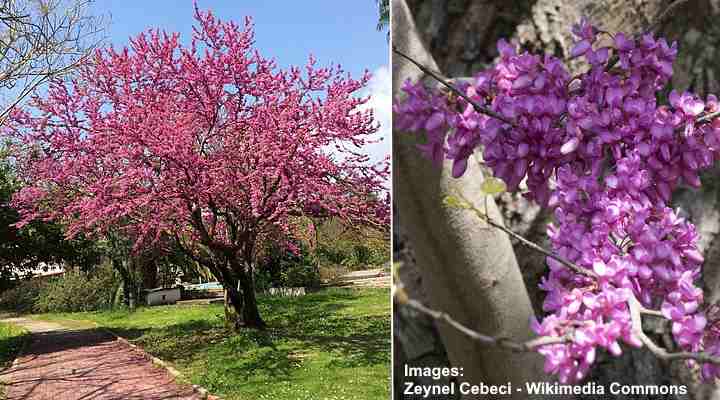
The Judas tree, a member of the redbud family, is known for its clusters of vibrant purplish-rose flowers. These pea-like flowers bloom in the early spring, enveloping the spreading and rounded crown of the tree. As the seasons progress, heart-shaped leaves emerge in a captivating bronze-red hue and transition to a vibrant yellow during the fall. The reddish-purple seed pods delicately hang from branches and persist throughout the winter months.
The Judas tree’s appealing shape, foliage, and eye-catching flowers have established its popularity as an ornamental planting choice. These trees thrive in well-drained soil and display adaptability to various soil types when situated in sunny landscapes.
When considering landscape design, the Judas tree serves well as a specimen tree, a border tree adorned with blossoms, or a shade tree providing cover for patios. Native to the Mediterranean region, this tree has abundant aesthetic charm due to its bright purple flowers and distinctive seed pods.
Mature Size: 15 to 25 ft. (4.5 – 7.5 m) tall and wide
USDA Hardiness Zones: 6 to 9
Sun: Full sun or partial shade
Discover the most beautiful purple flowering trees.
Types of Red Flowering Trees (With Pictures)
Red Buckeye (Aesculus pavia)
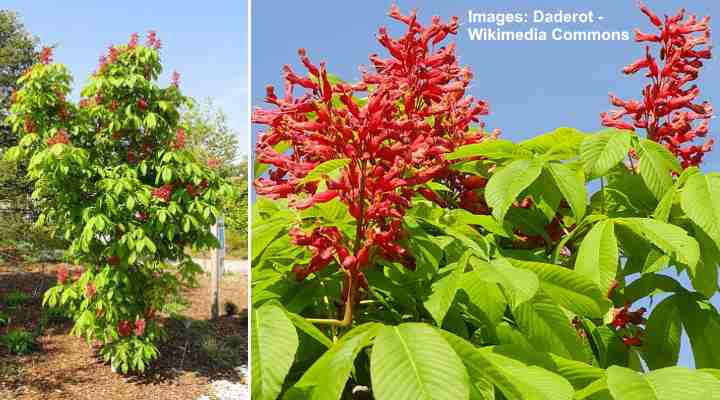
The red buckeye tree is a small ornamental tree known for its eye-catching red flowers. In spring, clusters of tube-shaped blooms appear at the tips of the tree’s stems. These vibrant red flowers are attractive to hummingbirds and butterflies. Following the flowers, the tree produces shiny, dark brown seeds, which are toxic if consumed.
With palmate leaves consisting of five drooping lance-shaped leaflets, the red buckeye provides a beautiful backdrop for the beautiful flowers. During the fall, the tree’s foliage transitions to a yellow color, blending into the autumn landscape. It is well-suited for woodland gardens, native gardens, or as a standout specimen tree in smaller landscapes.
Being native to North America, red buckeyes thrive in well-drained and moist soil, tolerating various soil types. They prefer partial shade in hot summer climates but can handle full sun with sufficient moisture.
Mature Size: 12 to 15 ft. (3.6 – 4.5 m) tall and wide
USDA Hardiness Zones: 5 to 9
Sun: Partial shade to full sun
Crimson Bottlebrush Tree (Melaleuca citrina)
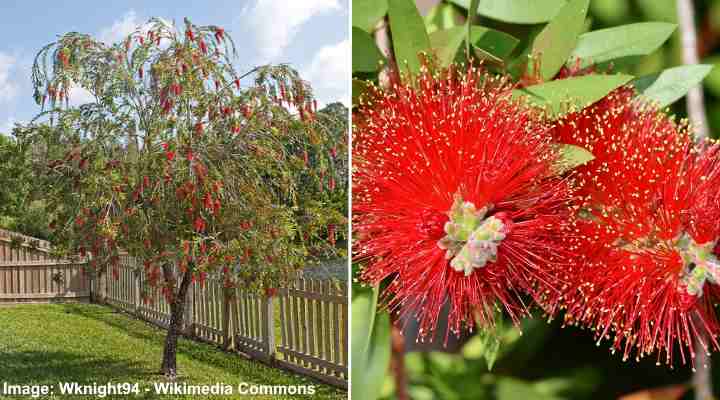
The red bottlebrush tree is a small evergreen tree with bushy growth known for its unique bottlebrush-like flowers. These elongated, fuzzy, conical flowers are vibrant red and resemble a brush used for cleaning bottles. It is also known as the lemon bottle brush tree, as its leaves emit a citrusy scent when crushed.
The bottlebrush tree bears narrow, lance-shaped leaves that are glossy and dark green. In the autumn, the lanceolate foliage transitions to a coppery-brown hue. Following the flowering period, woody, cup-shaped seed capsules develop and persist on the tree throughout the winter. The glossy green leaves beautifully contrast with the bright red flowers.
The red bottlebrush tree thrives in full sun and prefers well-drained soil. It can be used as an ornamental shrub, flowering hedge, or planted for foundation purposes in landscaping. Its ability to withstand salty air makes it particularly suitable for coastal gardens.
Mature Size: 8 to 15 ft. (2.4 – 4.5 m) tall and wide
USDA Hardiness Zones: 8 to 11
Sun: Full sun, six hours of direct sunlight or more
Tree Rhododendron (Rhododendron arboreum)
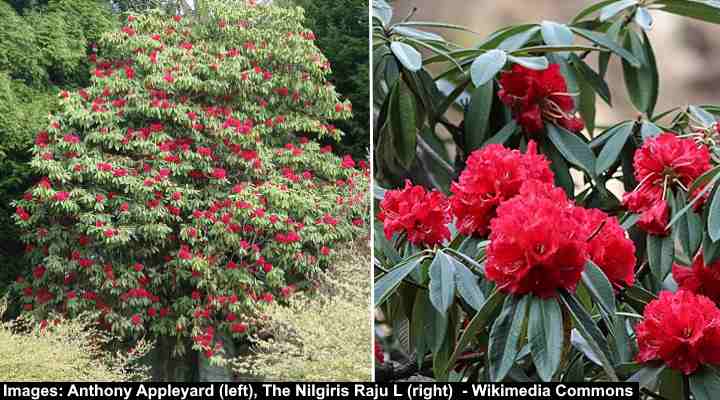
The tree rhododendron is a sizable evergreen shrub that can be pruned into a small red-flowering tree. It is known for its abundant clusters of vibrant summer-blooming flowers, ranging from bright red to scarlet red. The trumpet-shaped flowers have wave-shaped petals that emit a pleasant scent.
The lanceolate leaves of the tree rhododendron are dark green and have a leathery texture. During the autumn season, these leaves may transition to hues of bronze or reddish-purple before eventually falling.
This magnificent rhododendron variety is most suitable for larger landscapes, serving as a standout specimen tree or a provider of shade. It thrives in well-drained, acidic soil and prefers partial shade. In addition, the tree rhododendron is also resilient to colder climates.
Mature Size: 20 to 40 ft. (6 – 12 m) tall and wide
USDA Hardiness Zones: 7 to 9
Sun: Full sun to partial shade
Red Frangipani Tree (Plumeria Rubra)
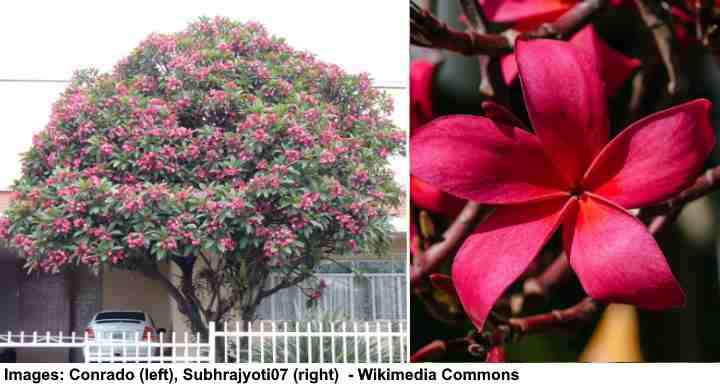
The red frangipani is a tropical tree that can be identified by its large star shaped red flowers. These large blooms showcase a vibrant magenta-red hue and emit a delightful fragrance. The tree’s abundant foliage, along with its deep pink or red flowers and elongated seed pods, contribute to its popularity in tropical gardens and landscapes.
With its year-round blossoming, the red frangipani brings continuous beauty to outdoor spaces. The striking red flowers create a splendid contrast against the thick, dark green leaves. As a small to medium-sized tree, the red frangipani is well-suited for gardens of many sizes.
Originating from tropical regions, the red frangipani thrives in hot and humid climates. This heat-tolerant tree flourishes in flower beds and borders, serving as a patio tree or a container plant. The tree prefers moderately moist, well-drained soils.
Mature Size: 15 to 25 ft. (4.5 – 7.5 m) tall and wide
USDA Hardiness Zones: 10 to 12
Sun: Full sun
Chinese Hibiscus Tree With Red Flowers (Hibiscus rosa-sinensis)
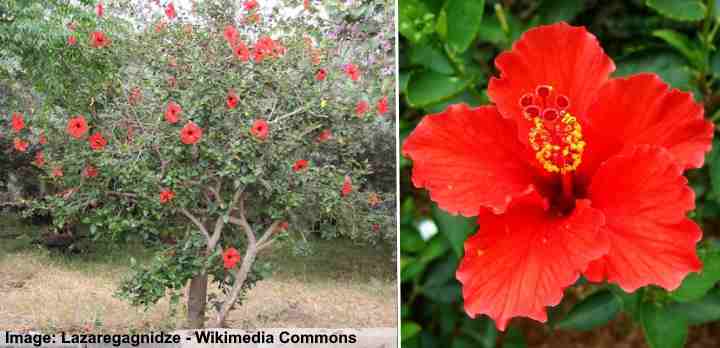
The Chinese hibiscus is a tropical evergreen tree renowned for its beautiful red trumpet-like flowers. These flowers are not only visually captivating but also emit a delightful floral fragrance. Their papery petals and prominent stamen add to their charm, creating funnel-like blooms that can reach up to 4 inches (10 cm) in diameter.
The vibrant red hibiscus flowers are highly sought-after for tropical gardens, drawing attention with their captivating beauty. Alongside these red, showy flowers, the Chinese hibiscus boasts glossy, lance-shaped leaves that are rich, dark green in color. While it retains its evergreen foliage in tropical climates, it may shed leaves in colder regions.
For optimal growth, Chinese hibiscus plants prefer well-drained soil and thrive in areas with full sun to partial shade. In tropical regions, regular watering, especially during dry periods, is necessary. These ornamental trees serve various purposes in gardens, such as being grown as shrubs for their decorative appeal, utilized as privacy hedges or screens, or attracting pollinators. In cooler climates, they can be cultivated in containers and brought indoors for overwintering.
Mature Size: 8 to 16 ft. (2.5 – 4.9 m) tall and 5 to 10 ft. (1.5 – 3 m) wide
USDA Hardiness Zones: 10 to 12
Sun: Full sun to partial shade
Royal Poinciana Tree (Delonix regia)
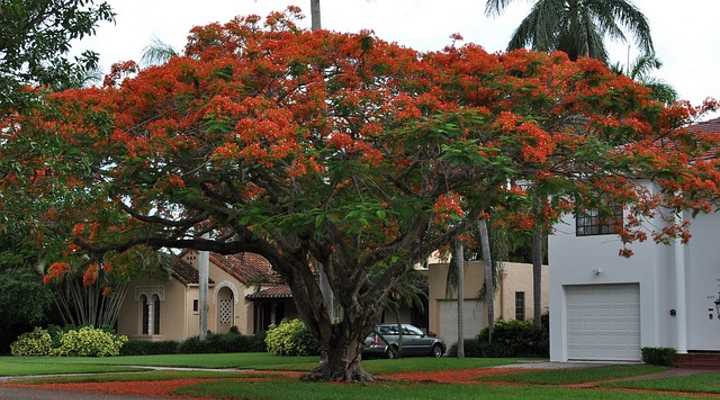
The flamboyant tree, also known as the royal poinciana, is known for its striking scarlet-orange flowers that adorn its umbrella-shaped canopy. These vibrant flowers, reaching up to 4 inches (10 cm) in diameter, create a mesmerizing floral exhibition that leaves onlookers in awe. Following the blossoming period, the tree’s radiant blooms give way to distinctive, bean-resembling seed pods.
In addition to its attractive flowers, the royal poinciana has fern-like foliage with a delicate, feathery appearance, enhancing its visual allure. With its evergreen leaves, long-lasting red flowers, and decorative seed pods, this tropical tree offers a year-round visual spectacle.
The royal poinciana tree is widely favored for landscaping purposes thanks to its magnificent flowers and attractive foliage. It serves excellently as a shade tree, adding charm to lawns or filling the streets with its presence. This tree is relatively easy to care for and can adapt to various soil types, although it thrives best in well-drained soil.
Mature Size: 30 to 40 ft. (9 – 12 m) tall and 40 to 70 ft. (12 – 21 m) wide
USDA Hardiness Zones: 10 to 12
Sun: Full sun
Red Flowering Dogwood Tree (Cornus florida ‘Cherokee Chief’)

With its vibrant red flowers, the red-flowering dogwood tree is an attractive addition to any garden, especially in smaller spaces. During the spring season, the tree’s bare branches burst into clusters of flowers with five red petal-like bracts around a cluster of tiny green blossoms. During the fall, these red flowers transform into glossy berry clusters that persist throughout the season.
The red-flowering dogwood has a rounded canopy covered with ovate green leaves. As autumn arrives, the foliage turns into shades of scarlet and purple. Additionally, the tree has alligator-skin-like bark, which becomes visible during late fall and winter, providing year-round visual interest.
The red-flowering dogwood is a great choice for small gardens, offering both shade near a lawn or patio and the potential to serve as a border or screen tree. It thrives in well-drained, moist soil with an acidic to neutral pH level.
Mature Size: 20 to 25 ft. (4.5 – 9 m) tall and 12 to 18 (3.6 – 5.4 m) wide
USDA Hardiness Zones: 5 to 9
Sun: Full sun to partial shade
Crabapple (Malus prairifire)
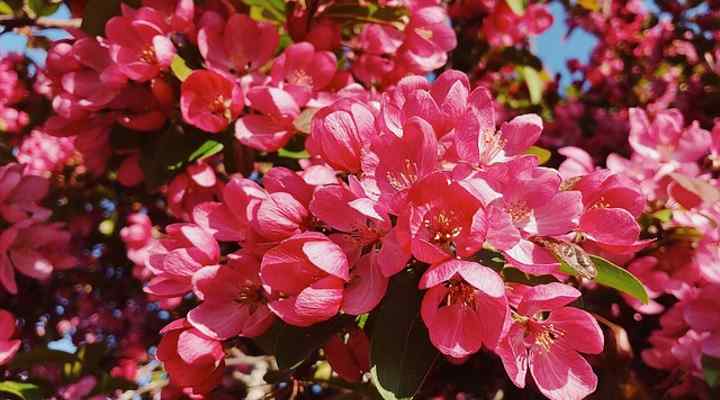
The ‘Prairifire’ crabapple is a small fruiting tree known for its charming dark pink to red flowers. These flowers bloom in dense clusters, covering the upright, rounded canopy in mid to late spring. The tree’s vibrant red shades add beauty to any landscape. In addition, small, cherry-like apples appear after the flowering period.
‘Prairifire’ crabapple trees have dark green leaves with distinct purplish-red veins. In the fall, the dense foliage turns into a spectacular golden-bronze, adding color to autumn landscapes. The tree’s shiny, deep red bark with unique lenticels adds to its overall appeal.
Prairifire crabapple trees are popular in small gardens due to their ornamental value. They thrive in moderately fertile soil with good drainage. The attractive flowers and fruit of these trees attract pollinators, birds, and other wildlife, making them a great addition to wildlife gardens.
Mature Size: 15 to 20 ft. (4.5 – 6 m) tall and wide
USDA Hardiness Zones: 4 to 8
Sun: Full sun
Red Silk Cotton Tree (Bombax ceiba)
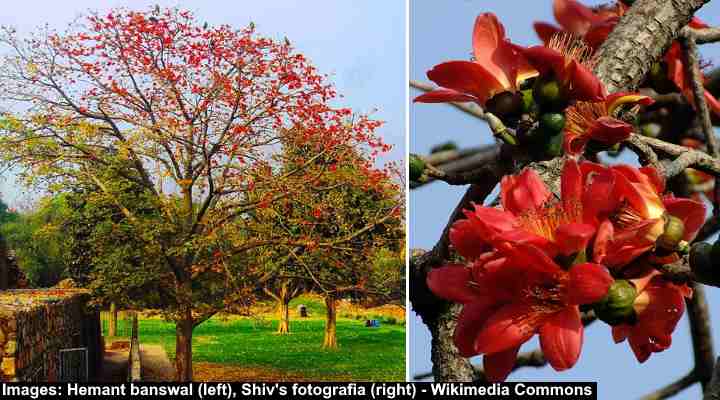
The red silk cotton tree is a tropical tree that thrives in warm climates and is known for its beautiful red flowers. With its smooth gray bark, palmate green leaves, and seeds wrapped in silky hairs, this heat-loving tree adds a touch of tropical charm to landscapes. It is often seen in warm climates such as Florida and other southern states, providing shade and beauty in large open spaces and parks.
Mature Size: 60 to 70 ft. (18 – 21 m) tall and 40 to 60 ft. (12 – 18 m) wide
USDA Hardiness Zones: 10 to 12
Sun: Full sun
African Tuliptree (Spathodea campanulata)
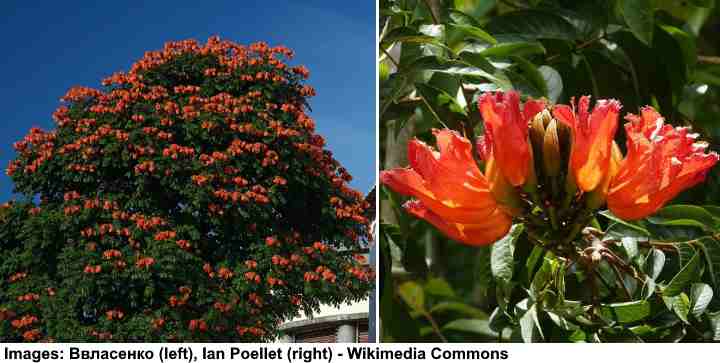
The African tuliptree is known for its vibrant reddish-orange cup-shaped flowers. These flowers resemble tulip blooms and grow in clusters at the branch tips throughout spring and summer. In addition, these flowers attract hummingbirds and butterflies, which contributes to the tree’s ecological value.
The African tuliptree has large glossy green leaves that create lush foliage in tropical gardens. These leaves are arranged alternately along the branches. Complementing its attractive flowers and glossy foliage, the African tuliptree also has a distinctive trunk adorned with smooth, gray-brown bark.
This tropical tree flourishes in moderately fertile, well-drained soil. It commonly serves as a shade tree in city parks, adding beauty to flowering landscapes.
Mature Size: 25 to 40 ft. (7.6 – 12 m) tall and 15 to 20 ft. (4.5 – 6 m) wide
USDA Hardiness Zones: 10 to 11
Sun: Full sun
Powderpuff Tree (Calliandra haematocephala)
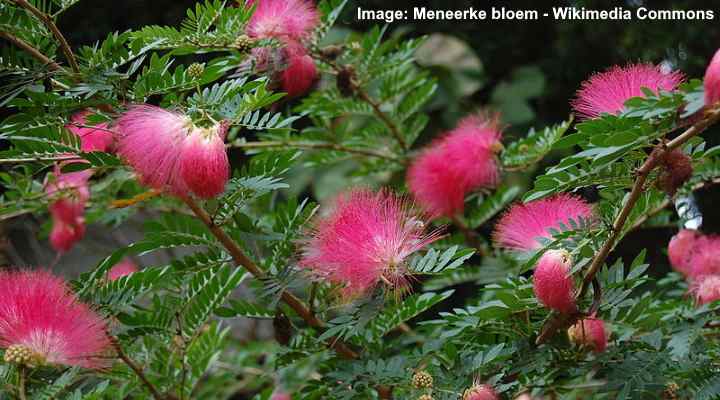
The red flowering powderpuff tree is a dwarf tree that can be identified by its distinct red powderpuff flowerheads. These vibrant scarlet flowers create a striking contrast against the delicate fern-like leaves. The tree’s attractive foliage starts out with a copper-pink hue and matures into a rich dark green. In tropical landscapes, bright red flowers bloom during fall and winter, with sporadic blooms throughout the year.
Powderpuff trees thrive in well-drained soil that is rich in organic matter. Once established, they have excellent heat and drought tolerance and require minimal pruning. With its eye-catching scarlet flowers and feathery foliage, the powderpuff tree adds an attractive touch to any landscape.
Mature Size: 3 to 6 ft. (1 – 1.8 m) tall and wide
USDA Hardiness Zones: 9 to 11
Sun: Full sun
Red Bird of Paradise (Caesalpinia pulcherrima)
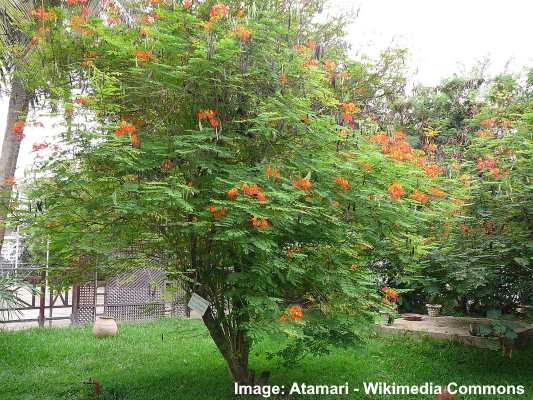
The red bird of paradise, also referred to as the peacock flower, is a tropical shrub or small tree known for its striking red and orange flowers. These vibrant blooms take the form of bowl-shaped, five-petaled flowers that cover prickly stems from spring to fall. Resembling the flowers of the royal Poinciana (Delonix regia) tree, the red bird of paradise is also known as the dwarf poinciana.
This ornamental tree has fern-like compound leaves and branches with thorns. Thriving in hot and arid climates, the red bird of paradise is well-suited for desert gardens or xeriscape landscapes. It serves as an excellent choice for a garden’s focal point or as an attractive border plant.
Embrace the opportunity to introduce vibrant colors and tropical charm to your compact outdoor space with this tree.
Mature Size: 10 to 20 ft. (3 – 6 m) tall and 6 to 12 ft. (1.8 – 3.6 m) wide
USDA Hardiness Zones: 9 to 11
Sun: Full sun
Red Flowering Gum Tree (Corymbia ficifolia)
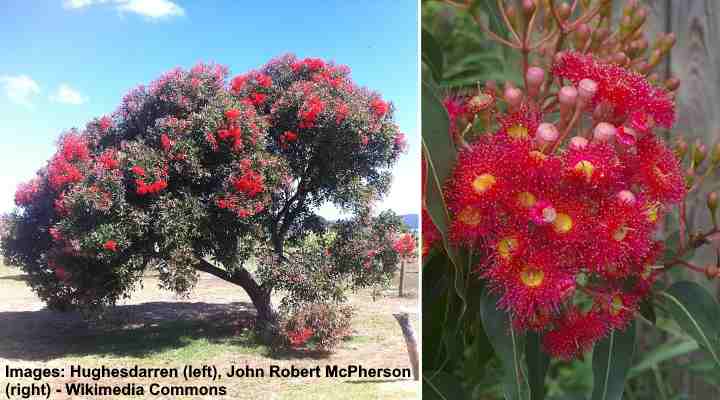
The red-flowering gum tree is recognized by its vibrant clusters of large, eye-catching red flowers. This fast-growing evergreen tree showcases an array of shades, ranging from bright red to pink or orange. Its delightful blooms attract nectar-feeding birds and bees, making it a favored choice for wildlife gardens.
With its glossy, dark green leaves featuring a prominent yellow midrib, the red-flowering gum tree offers a striking appearance. Once the flowers fade, urn-shaped fruits emerge from the tree. In addition, this tree thrives in hot and dry landscapes and is drought-tolerant. It serves well as a specimen or shade tree, and its resilience to salty air makes it an excellent addition to coastal gardens.
Mature Size: 20 to 40 ft. (6 – 12 m) tall and 15 to 60 ft. (4.54 – 18 m) wide
USDA Hardiness Zones: 9 to 11
Sun: Full sun to partial shade
Pomegranate Tree (Punica granatum)
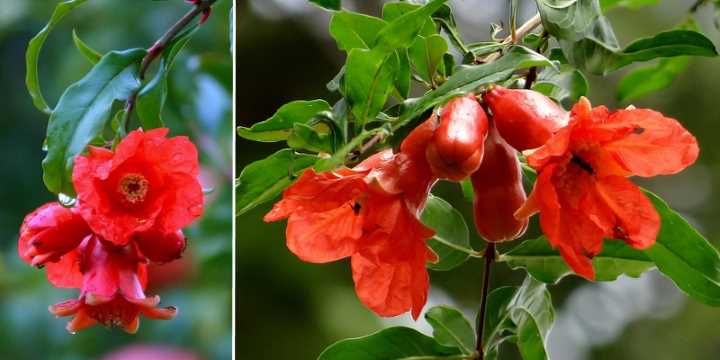
The pomegranate tree is a small deciduous tree known for its vivid red flowers and sweet fruit. Its scarlet flowers are cup-shaped with crinkled petals and a cluster of yellow-tipped stamens at the center. These attractive blooms are followed by round, juicy pomegranate fruits filled with delightful sweet-tart arils.
Pomegranate trees can be recognized by their multi-stemmed growth habit, evergreen oblong leaves, and blooms that last throughout the summer. As autumn arrives, their leaves transition to a vibrant yellow hue, enhancing the tree’s seasonal appeal. These trees are ideal for Mediterranean-style gardens and can also thrive when cultivated in containers on patios or balconies.
Mature Size: 6 to 20 ft. (1.8 – 6 m) tall and 4 to 5 ft. (1.2 – 4.5 m) wide
USDA Hardiness Zones: 8 to 11
Sun: Full sun
Red Silky Oak Tree (Alloxylon flammeum)

The red silky oak tree is an eye-catching medium-sized tree with beautiful red flowers, perfect for tropical landscapes. Its vibrant tubular flowers grow in clusters, pointing upward and creating a striking floral display in spring. These flowers beautifully contrast with the slender, lance-shaped leaves. As fall arrives, woody seed pods appear and ripen, ready for the next spring.
The red silky oak tree thrives as a specimen tree in spacious gardens, parks, and open landscapes. Its broad canopy and dense foliage make it an excellent choice for providing shade near patios or decking areas.
Mature Size: 30 to 50 ft. (9 – 15 m) tall and 20 to 30 ft. (6 – 9 m) wide
USDA Hardiness Zones: 9 to 11
Sun: Full sun to partial shade
Indian Coral Tree (Erythrina variegata)
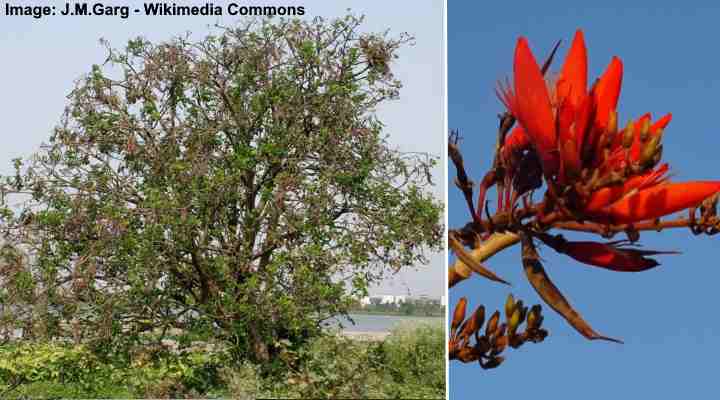
The Indian coral tree is an attractive deciduous tree renowned for its striking crimson or scarlet flowers. These bright red blossoms form clusters resembling coral, which gives the tree its name. The vibrant flowers attract birds, pollinators, and butterflies, making it a popular option for wildlife gardens in tropical and subtropical regions.
The Indian coral tree has lush foliage with large leaves made up of three smaller leaflets, each measuring 2 to 4 inches (5 – 10 cm). The leaves typically display a pleasing shade of green, although certain varieties may have variegated or mottled patterns. This green foliage serves as a beautiful contrast to the red, orange, and occasional pink flowers.
The Indian coral tree thrives in warm climates and prefers well-drained soil. In addition, this tree proves valuable as a shade provider in sizable gardens, parks, or open areas. The vivid flowers grant it an appealing quality for adding a vibrant touch to the landscape, while its spreading canopy offers relief from the sun.
Mature Size: 20 to 40 ft. (6 – 12 m) tall and wide
USDA Hardiness Zones: 10 and 11
Sun: Full sun
‘Hardy Red’ Oleander (Nerium oleander ‘Hardy Red’)
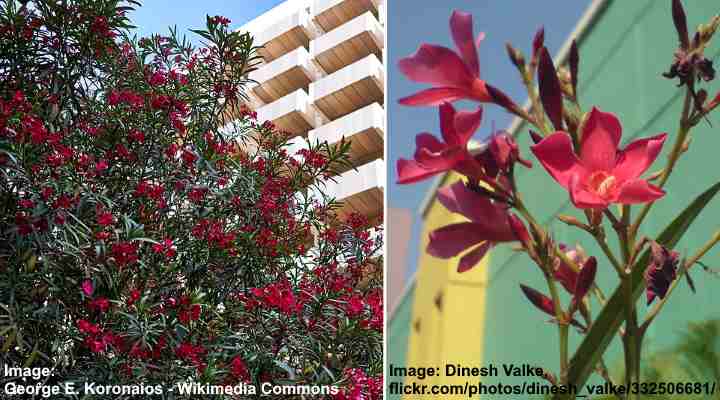
The ‘Hardy Red’ oleander is a striking shrub or small tree known for its deep red flowers. These colorful funnel-shaped flowers bring a burst of vibrant color to summer landscapes. The clusters of five-petaled, deep red flowers cover the plant from spring through fall. Notably, the ‘Hardy Red’ cultivar demonstrates greater resilience to colder temperatures compared to other oleander varieties.
The ‘Hardy Red’ oleander has a vase-shaped canopy with long, dark green lanceolate leaves. This multi-stemmed shrub or small tree thrives when used as a red-flowering hedge, an evergreen privacy screen, or a captivating specimen plant. Additionally, the plant is drought tolerant and requires minimal maintenance, making it an appealing choice for gardens in hot and arid regions.
It is important to bear in mind that all parts of the oleander plant are toxic if ingested, so exercise caution when planting it in areas where there might be children and pets.
Mature Size: 6 to 15 ft. (1.8 – 3.6 m) tall and up to 10 ft. (3 m) wide
USDA Hardiness Zones: 7 to 12
Sun: Full sun
Flame of the Forest Tree (Butea monosperma)
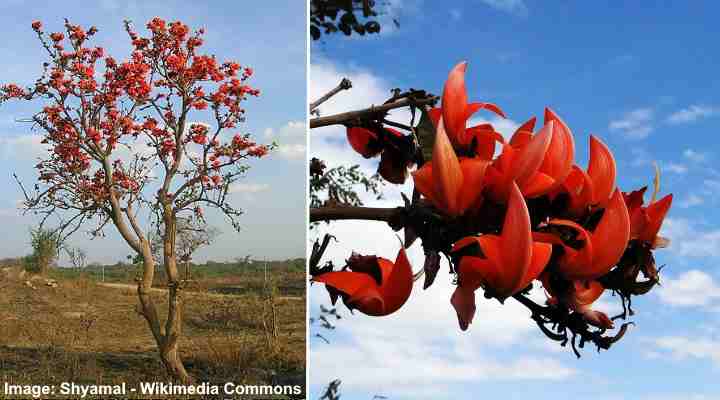
The flame of the forest tree is renowned for its floral exhibition of vibrant orange-red flowers. This small to medium-sized tree has a wide, expansive canopy with brilliant red blossoms during the late winter and early spring seasons. After the flowers wither, flat bronze-brown pods appear, each containing a single seed. The tree’s appealing form, abundant foliage, and radiant flowers contribute to its visual allure.
Flame of the forest trees are highly sought-after as shade trees in parks and gardens. They are adaptable to a variety of soil types, although they prefer organically enriched, well-drained, and fertile soils. In addition, they are tolerant to both drought and flooding conditions.
Mature Size: 30 to 40 ft. (9 – 12 m) tall and wide
USDA Hardiness Zones: 10 to 12
Sun: Full sun to partial shade
Red Angel’s Trumpet Tree (Brugmansia sanguinea)
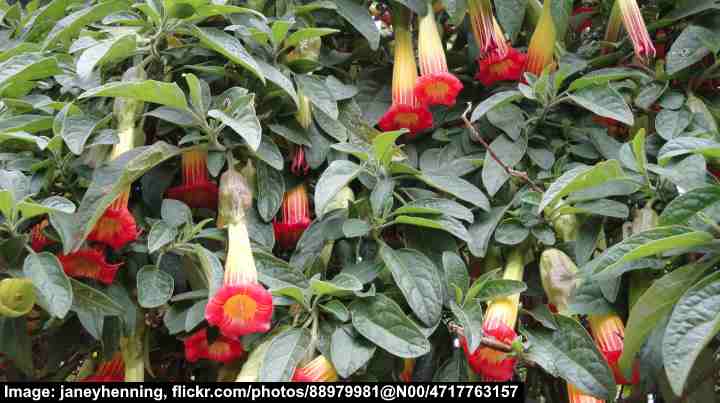
The red angel’s trumpet tree stands out as one of the most exquisite trees with its captivating, bright red flowers. This small tropical tree can be easily recognized by its large, hanging funnel-shaped flowers. The flowers display a blend of green and yellow hues, accentuated by vibrant red mouths. The fragrance of these exotic flowers attracts the delightful presence of hummingbirds and butterflies.
With its fast growth and captivating features, the red angel’s trumpet tree provides year-round visual interest. Its bushy form, tropical flowers, and lush green foliage add to its charm.
Given its tropical nature, the red angel’s trumpet tree thrives best in warmer climates. It can be grown in gardens, used as a border shrub, or planted in containers for patios and decks.
However, it’s important to note that all parts of the tree are toxic if ingested, making it less suitable for planting in backyard areas where children and pets may play.
Mature Size: 8 to 12 ft. (2.4 – 3.6 m) tall and 6 to 8 ft. (1.8 – 2.4 m) wide
USDA Hardiness Zones: 9 to 11
Sun: Full sun to partial shade
Red Flowering Grevillea Trees
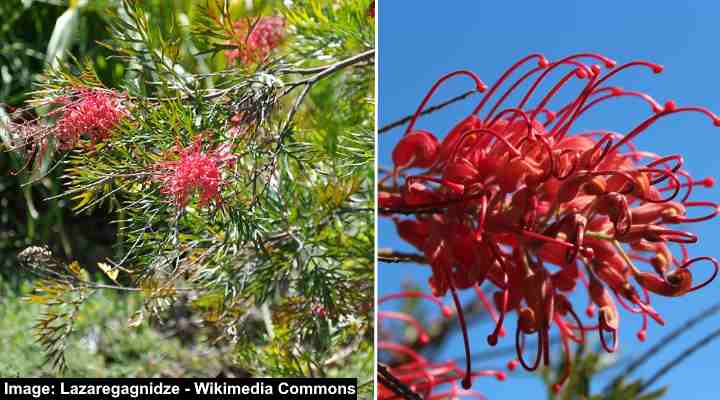
The red-flowering grevillea tree is known for its vibrant red flowers that bloom throughout the year. This dwarf tree has large clusters of cylindrical clusters of red flowers, each with unique curled petals and beautiful arching stamens. These red flowers are particularly attractive to birds and bees, making them a valuable addition to any garden or landscape.
Grevillea trees have slender leaves that resemble ferns, usually appearing in shades of dark green or silver-gray. These trees are well-suited for xeriscape gardens, coastal landscapes, and dry conditions, thanks to their drought-tolerant nature. Grevillea trees can be used as hedges, screens, specimen plants, or windbreaks, offering versatility in various gardening applications.
Mature Size: 4 to 8 ft. (1.2 – 2.4 m) tall, depending on the species
USDA Hardiness Zones: 9 to 11
Sun: Full sun to partial shade
Waratah (Telopea)
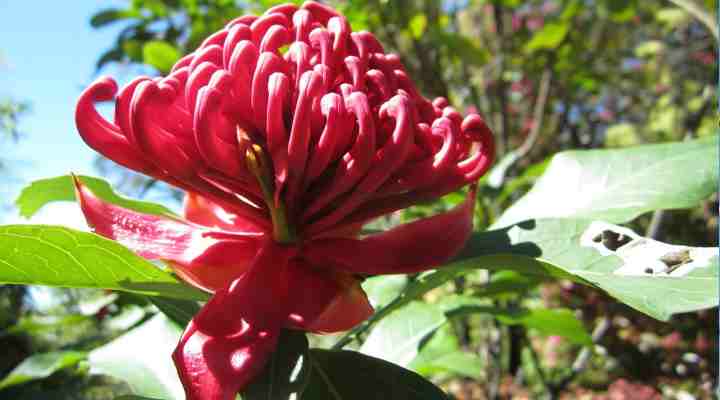
The waratah tree is renowned for its vibrant, rounded flower clusters that come in attractive shades of red or pink. These flowers are bold and showy, resembling traditional waratah blooms, and are held at the ends of long stalks. Each flower head consists of a cluster of florets surrounded by colorful bracts in shades of red, maroon, or pink.
Waratah trees have dark green, leathery leaves with serrated edges. These slow-growing trees have a dense and compact growth habit, making them ideal focal points in gardens or standalone specimen trees. Their unique and captivating blooms also make them popular choices for cut flower arrangements.
Waratahs thrive in well-drained soil and prefer full sun to partial shade. They are tolerant of various soil types and can withstand periods of drought once they have been established. However, it is advisable to provide some protection from strong winds.
Mature Size: 3 to 10 ft. (1 – 3 m) tall and wide
USDA Hardiness Zones: 8 to 10
Sun: Full sun to partial shade
Common Flowering Quince (Chaenomeles speciosa)
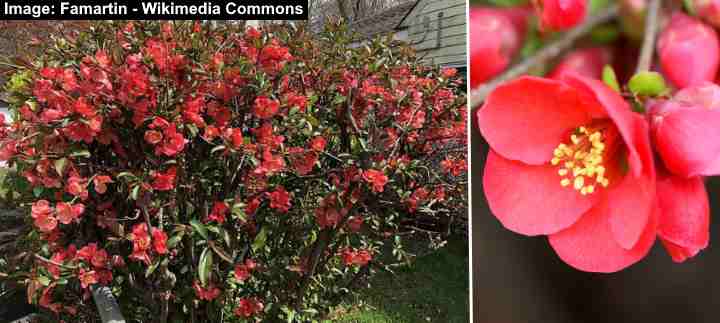
The flowering quince is a thorny deciduous shrub or small tree that grows stunning scarlet-red flowers during late winter and early spring. These small flowers have five petals and appear before the leaves unfurl. Their vibrant red color brings a delightful burst of brightness to the landscape and attracts beneficial pollinators such as bees and butterflies.
The flowering quince has glossy dark green foliage with oval-shaped leaves. In the fall, the leaves turn into shades of red or burgundy, enhancing the tree’s aesthetic appeal. This dense, thorny shrub-like tree is an excellent choice for creating hedges or privacy screens. Alternatively, it can be grown as a stand-alone specimen plant or pruned into a small tree.
Flowering quince adapts well to different soil types, including sandy, rocky, clay, and loamy soils. Once established, these trees are drought-tolerant.
Aside from its ornamental attributes, the red-flowering quince produces apple-shaped pomes that are edible. These small, sour fruits are yellow with tiny dots and are commonly used in the preparation of quince jelly.
Mature Size: 6 to 10 ft. (1.8 – 3 m) tall and wide
USDA Hardiness Zones: 4 to 9
Sun: Full sun to partial shade
Red Maple (Acer rubrum)
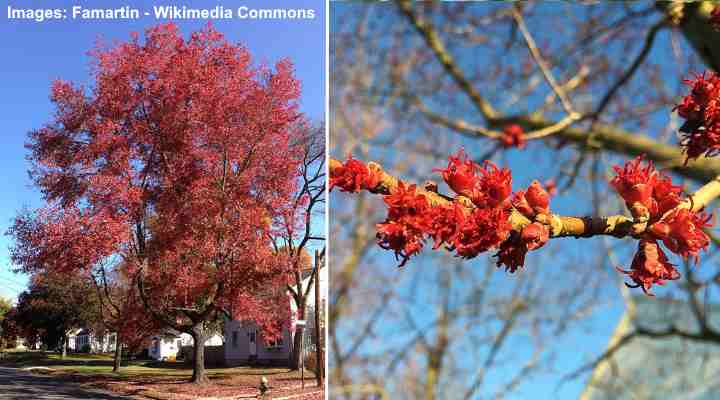
The red maple is an attractive deciduous tree known for its vibrant red flowers and colorful yellow and red autumn foliage. Clusters of tiny red flowers cover the bare branches, adding a pop of color. In late spring, the leaves emerge as red, gradually turning green during summer.
One notable characteristic of the red maple is its reddish-pink winged samaras (seed capsules). Additionally, as the tree matures, its smooth gray bark develops appealing furrows, enhancing its visual appeal.
Red maples are versatile trees suitable for various landscape purposes, including shade trees, street trees, or as focal points in gardens. With their red flowers, vibrant foliage, and unique seed pods, red maples offer year-round interest, making them popular choices for ornamental planting in temperate environments.
Mature Size: 40 to 70 ft. (12 – 21 m) tall and 30 to 50 ft. (9 – 15) wide
USDA Hardiness Zones: 3 to 9
Sun: Full sun to partial shade
Firewheel Tree (Stenocarpus sinuatus)
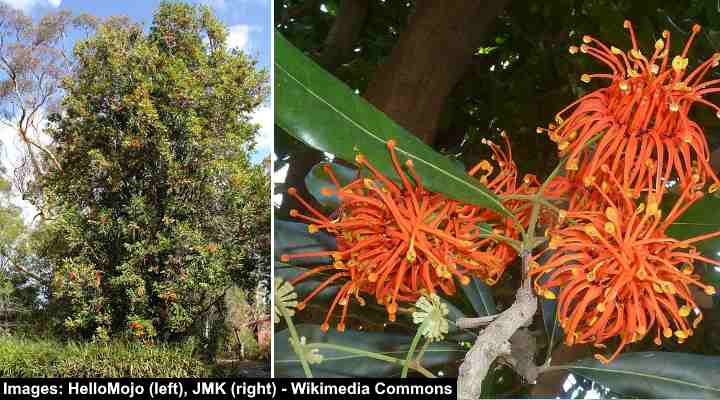
The firewheel tree, native to Australia, is an eye-catching red-flowering tree that captivates with its large bell-shaped flowers resembling a fiery wheel. The individual florets of the flower form a round shape, creating a stunning display ranging from deep scarlet to bright crimson in color.
The firewheel tree also has glossy, dark green fern-like leaves that serve as an attractive backdrop to the bright red flowers. The evergreen leaves have wavy edges, enhancing the tree’s visual appeal year-round alongside its unique bright orange-red flowers.
The tree is low in maintenance and adaptable to various soil types. In addition, it thrives in full sun and well-drained soil. It’s an excellent choice for introducing vibrant red hues to mixed plantings in tropical gardens.
Mature Size: 30 to 50 ft. (6 – 9 m) tall and 20 to 25 ft. (6 – 10 m) wide
USDA Hardiness Zones: 9 to 11
Sun: Full sun to partial shade
Flame Tree (Brachychiton acerifolius)
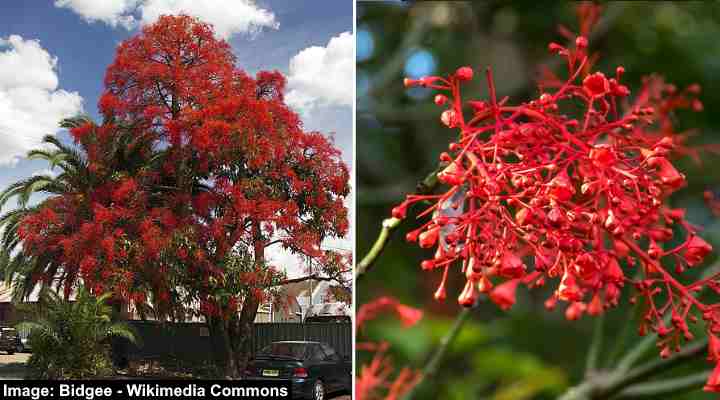
The flame tree is a stunning tree that produces abundant clusters of vibrant red or scarlet flowers. During spring and summer, its pyramidal canopy bursts into fiery red hues, creating a captivating display. The bell-shaped flowers have a star-like form and emit a fragrant aroma, attracting birds and pollinators to the tree.
The flame tree is easily recognizable by its large, wide-spreading canopy and maple-like deciduous leaves. The glossy green leaves, attached to the branches by long petioles, have up to five pointed lobes, adding to the tree’s decorative appeal. This lush foliage provides a beautiful green backdrop to the striking flowers. In the fall, the leaves turn yellow before gracefully falling, revealing the tree’s unique branching structure.
Flame trees are highly sought-after for their beauty and dense foliage, making them popular choices for gardens and parks. Whether used as shade trees or as focal points in a landscape, these trees add a touch of elegance and beauty to any outdoor space.
Mature Size: 30 to 50 ft. (9 – 15 m) tall and 25 to 40 ft. (7 – 12 m) wide
USDA Hardiness Zones: 9 to 11
Sun: Full sun to partial shade
Red Flowering Camellia (Camellia japonica)
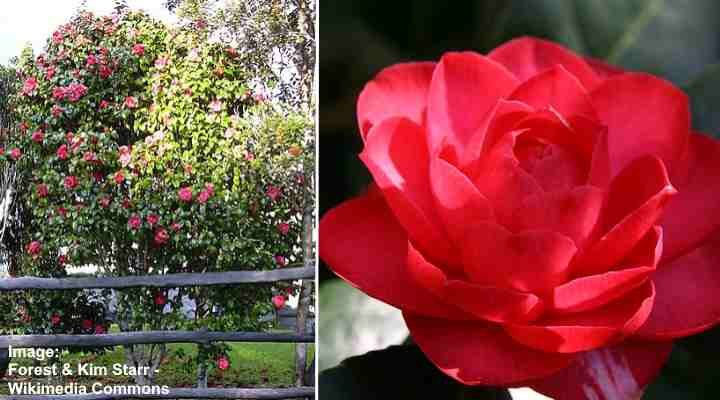
The red-flowering camellia is an exquisite evergreen tree known for its bright, vibrant red flowers. The camellia’s blossoms have a symmetrical and captivating form, resembling roses or peonies. These magnificent red flowers appear on the tree during late winter or early spring, infusing color when most other plants lie dormant.
Beyond its stunning red peony-like flowers, the evergreen camellia showcases lush, glossy green leaves that create an appealing backdrop for the blooms. Red-flowering camellias are versatile as trees or shrubs, offering tremendous visual appeal.
Here are a few varieties of red-flowering camellia that thrive in various light conditions, from full sun to deep shade:
Camellia japonica ‘Kramer’s Supreme’: This tree showcases profuse blooms of stunning red peony-type flowers that appear on the tree from late winter through spring.
Camellia japonica ‘Australis’: With rose-red flowers composed of wavy, ruffled petals, this camellia delights for several months, starting in late winter.
Camellia japonica ‘Bob Hope’: Featuring deep red semi-double blossoms with eye-catching yellow stamens, this variety bursts into vibrant color during spring.
Camellia japonica ‘Lady Campbell’: These bright red, rose-form flowers provide a nice contrast against the glossy dark green leaves, adding a vibrant burst of color to any garden or landscape.
Mature Size: 6 to 12 ft. (1.8 – 3.6 m) tall and 6 to 10 ft. (1.8 to 3 m) wide
USDA Hardiness Zones: 7 to 9
Sun: Partial shade to deep shade
Discover beautiful red flowering trees.
Types of Orange Flowering Trees (With Pictures): Identification Guide
Elder Tree (Tecoma Stans ‘Orange Jubilee’)

The flowering ‘Orange Jubilee’ elder tree is well-known for its vibrant, trumpet-shaped flowers in a stunning shade of orange. These large and eye-catching funnel flowers stay in full bloom for a long time, attracting pollinators and hummingbirds with their pleasant fragrance.
The elder tree features glossy, dark green, lance-shaped leaves with serrated edges. It’s an evergreen tree that grows quickly and has a spreading shape. It works great in larger landscapes, providing shade as a tree or serving as a privacy screen, hedge, or foundation planting.
This type of elder tree, ‘Orange Jubilee,’ is particularly suitable for hot and dry climates, as it is drought-tolerant and thrives when exposed to sunshine throughout the day.
Mature Size: 10 to 20 ft. (2.4 – 3.6 m) tall and 8 to 12 ft. (2.4 – 3.6 m) wide
USDA Hardiness Zones: 9 to 11
Sun: Full sun
Orange Bells (Tecoma alata)
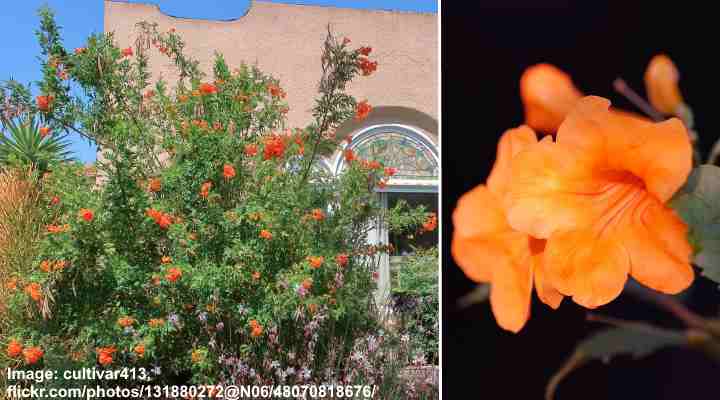
Orange bells is a delightful shrub that can be trained to grow as a small tree. Its charm lies in the vibrant tubular orange flowers with a trumpet shape, which bloom in late spring and continue through summer. These fragrant orange flowers, with their flaring petals, have a special appeal to hummingbirds and butterflies, making the tree a favorite in wildlife gardens.
The orange bells tree has lush foliage of glossy, dark green leaves with a slightly fuzzy texture. Its pleasing mix of orange and green colors makes it an excellent choice as a specimen plant, an evergreen flowering hedge, or a beautiful addition to mixed borders. In addition, it adapts well to large containers on patios or in small gardens.
This petite evergreen shrubby tree is versatile when it comes to soil types but prefers well-drained soil. It’s a low-maintenance plant that can handle drought, heat, and salty air, making it a perfect fit for semi-tropical coastal landscapes and arid conditions.
Mature Size: 8 to 12 ft. (2.4 – 3.6 m) tall and wide
USDA Hardiness Zones: 8 to 11
Sun: Full sun to partial shade
Jamaican Rain Tree (Brya ebenus)

The Jamaican rain tree is a compact to mid-sized plant with small, aromatic, bright orange flowers. These eye-catching bell-like flowers, in shades of orange or deep yellow, hang in clusters during the summer. The tree is easily recognizable by its gracefully arched branches, green, waxy leaves with an obovate shape, and charming bell-shaped orange or yellow flowers.
The Jamaican rain tree grows rapidly and is a good choice for a shade tree with its wide-spreading canopy and dense foliage. Aside from its stunning flowers, the tree also produces small, dark brown seeds encased in papery coverings.
This adaptable tree thrives in various well-drained soils. It is an excellent choice for warm, tropical climates and coastal landscapes. Whether used as a privacy screen, windbreak, or simply as a sun-loving shade tree, the Jamaican rain tree will flourish and add beauty to your garden.
Mature Size: 20 to 30 ft. (6 – 9 m) tall and 15 to 20 ft. (4.5 – 6 m) wide
USDA Hardiness Zones: 10 to 12
Sun: Full sun to partial shade
Orange Champaca Tree (Magnolia champaca)

The orange champaca tree, also known as champak, is a magnolia tree with beautiful orange flowers. This tropical evergreen tree blooms with stunning, fragrant, cup-shaped flowers in a delightful yellowish-orange hue. The petals of these flowers are oval and spread wide, creating a star-like shape. You can enjoy the blossoms of the orange champak tree from mid-summer until early fall.
The tree’s glossy, dark green leaves are wedge-shaped and have a pointed tip. Alongside its showy, cup-shaped orange flowers, the magnolia tree grows clusters of oval fruits containing orange or red seeds.
Native to Southeast Asia, this tropical tree is a popular choice for ornamental purposes in warm climates. It can be an excellent addition to gardens, parks, and various outdoor spaces, providing shade, vibrant flowers, and lush foliage.
To keep the orange champak tree happy, make sure it grows in well-drained soil and receives full sun. Don’t forget to water it regularly during the summer months.
Mature Size: Typically up to 50 ft. (15 m) in cultivation
USDA Hardiness Zones: 10 to 12
Sun: Six to eight hours of direct sunlight daily
Scarlet Wisteria (Sesbania punicea)

The scarlet wisteria is a beautiful small tree or shrub with clusters of bright orange to red flowers. The name comes from the plant’s resemblance to the cascading blooms of wisteria plants. These flowers bloom in late spring to early summer and attract hummingbirds and butterflies.
Another name for the scarlet wisteria is rattlebox or Spanish gold. It has compound leaves with small green or grayish-green leaflets. The plant is bushy, multi-stemmed, and has a spreading growth habit. The plant can be shaped into a small tree or left to grow as a shrub.
Scarlet wisterias are versatile plants that can handle drought and thrive in different landscapes. They make great shade trees in backyards and gardens for ornamental purposes. The eye-catching orange flowers also create stunning informal hedges or screens. If you prefer container gardening, these small trees do well on patios.
Keep in mind that all parts of the plant are toxic, so caution is necessary.
Mature Size: 10 to 15 ft. (3 – 4.5 m) tall and wide
USDA Hardiness Zones: 8 to 11
Sun: Full sun to light shade
Fragrant Orange Tea Olive (Osmanthus fragrans f. aurantiacus)

The delightful orange tea olive is a small and hardy evergreen tree famous for its highly fragrant tangerine-colored flowers. These tiny, tubular orange flowers cluster together, emitting a sweet scent reminiscent of apricots. The soft orange hue of the flowers stands out nicely against the shiny, dark green leaves.
The fragrant olive tree has dense foliage thanks to its dark green, oval, pointed, and leathery leaves, making it a great choice for year-round greenery. You can use these trees in landscaping for evergreen hedges and privacy screens, as well as for foundation planting or as a standalone focal point. Additionally, they are perfect for planting in containers to add beauty to patios or entryways.
Mature Size: 10 to 15 ft. (3 – 4.5 m) tall and 6 to 8 ft. (1.8 – 2.4) wide
USDA Hardiness Zones: 7 to 10
Sun: Full sun to partial shade
Flame Azalea (Rhododendron calendulaceum)
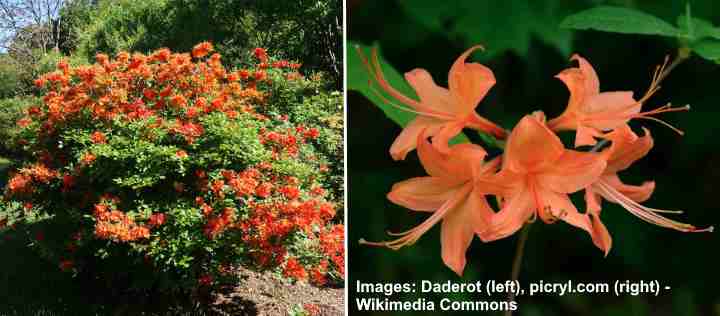
The flame azalea is an attractive, deciduous shrub with beautiful orange flowers that can be trained to grow as a tree. Its eye-catching flowerheads resemble fiery candle flames, and these bright orange flowers bloom for about two weeks in late spring and summer. When in full bloom, the rounded canopy is covered with stunning orange-red flowers.
The foliage of the flame azalea consists of green leaves with a fuzzy texture which turn yellow and pale orange in the fall, creating a beautiful display of autumn colors. This compact tree is perfect for foundation planting, mixed borders, or privacy screens.
To keep the flame azalea happy, make sure to plant it in acidic, well-drained soil and provide partial shade. To encourage more blooms, simply remove the dead flowers, and the decorative shrub or tree will bloom again in late summer.
Mature Size: 4 to 8 ft. (1.2 – 2.4 m) tall and wide
USDA Hardiness Zones: 5 to 8
Sun: Partial shade or full sun
Orange Hibiscus Tree (Hibiscus rosa-Sinensis)

The orange hibiscus tree is known for producing some of the most striking orange flowers among ornamental trees. These large, showy flowers have five papery petals and a prominent central stigma. Their year-round bloom adds a delightful burst of color to any landscape, making the orange hibiscus tree a popular choice for tropical gardens. It can be planted as a focal point or in groups to create a dramatic effect.
Take a look at these beautiful examples of hibiscus trees with tropical orange flowers:
Hibiscus rosa-Sinensis ‘Apricot Brandy’: This tropical ornamental tree produces double blooms with ruffled peach-orange petals that resemble peony flowers. It grows to a height and width of 8 to 10 ft. (2.4 – 3 m) in USDA zones 9 and 10.
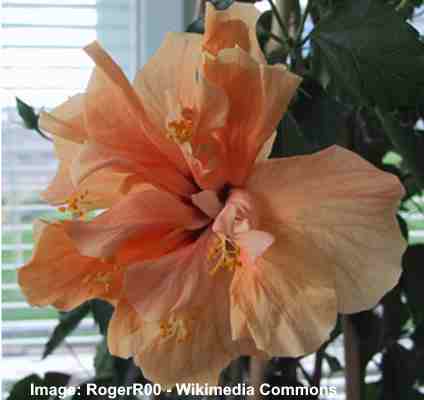
Hibiscus rosa-Sinensis ‘Apricot Brandy’
Hibiscus rosa-Sinensis ‘Cheri’: This decorative tree showcases large neon orange showy flowers with a rosy-pink throat. It reaches a height of 7 ft. (2.1 m) in USDA zones 10 and 11.
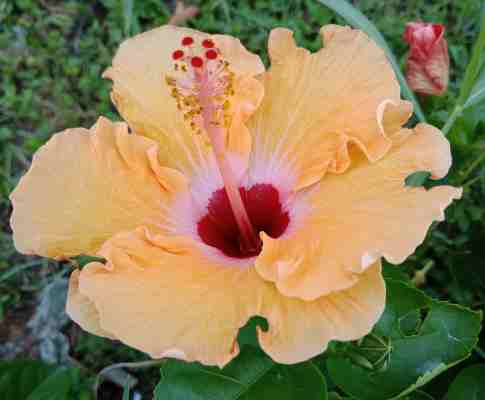
Hibiscus rosa-Sinensis ‘Cheri’
Hibiscus rosa-Sinensis ‘Electric Orange’: A brilliant tropical hibiscus hybrid with the brightest orange flowers you’ll find on any hibiscus tree. The striking orange flowers create a lovely contrast against the smooth, shiny green foliage. This ornamental tree can grow up to 8 ft. (2.4 m) tall in USDA zones 9 through 11.
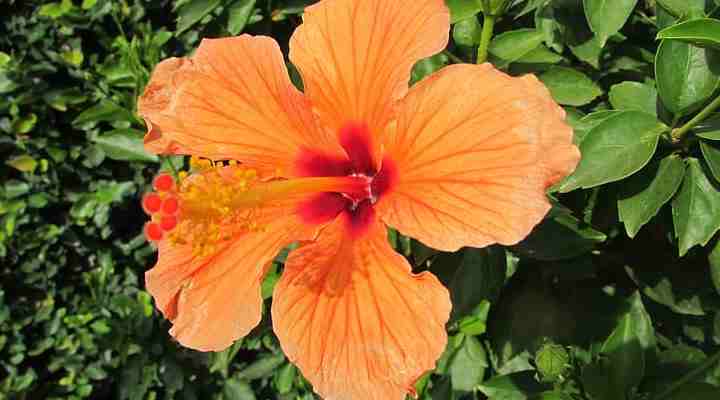
Hibiscus rosa-Sinensis ‘Electric Orange’
Hibiscus rosa-Sinensis ‘High Definition’: This hibiscus variety has showy double-petaled flowers measuring 6 inches (15 cm) in diameter. Their bright orange color, combined with yellow splotches and speckles, creates a vibrant display. The small shrub or dwarf ornamental tree reaches a height of 5 ft. (1.5 m) in USDA zones 9 to 11.
Southern Silky Oak Tree (Grevillea robusta)
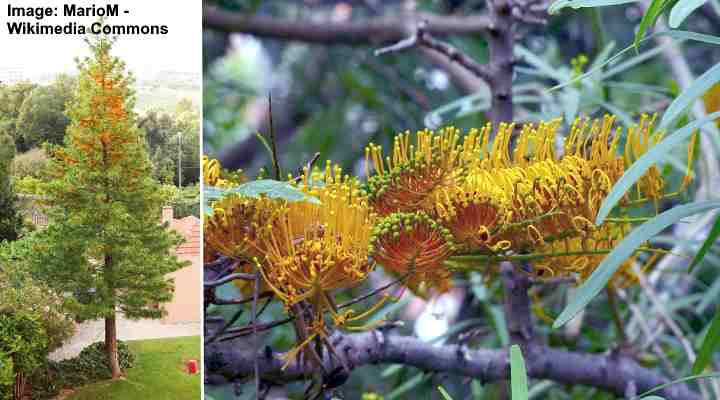
The southern silky oak tree is a large evergreen tree that displays stunning yellowish-red or yellowish-orange flowers. One distinctive feature of these orange blooms is their prominent, yellow-tipped, orange stamens. These showy flowers form colorful clusters on the fast-growing tropical tree, beautifully contrasting with the dark green, fern-like foliage.
Apart from its pretty flowers, the southern silky oak tree has a tall and upright growth pattern. This impressive tree is an excellent addition to large landscapes, providing ample shade and serving as a habitat for birds and other wildlife.
For optimal growth, the southern silky oak tree prefers well-drained, sandy soil and requires full sun exposure. It’s a hardy tree, capable of withstanding drought conditions, and thrives well in the heat of Southern California, Texas, and Florida.
Mature Size: 40 to 70 ft. (18 – 21 m) tall
USDA Hardiness Zones: 9 to 11
Sun: Full sun
Angel’s Trumpet (Brugmansia)

The orange flowering angel’s trumpet is a semi-tropical tree that loves the sun and can be identified by its stunning trumpet-shaped flowers in pale orange to yellow hues. When it’s in bloom, these large tropical flowers hang down from the arching branches, creating a breathtaking floral display. The sweet scent of the flowers is strong and attracts pollinating moths.
What makes the angel’s trumpet tree easy to recognize is its large funnel flowers, which can reach up to 12 inches (30 cm) in length. With its dense foliage and umbrella-like domed canopy, it becomes a striking focal point in any garden.
This tree grows rapidly and blooms from spring through summer until fall. However, it does require some maintenance. Regular pruning is needed to keep its shape, and it benefits from regular feeding during the spring and summer to encourage new flowers and growth.
The angel’s trumpet tree is versatile in landscaping, serving as an accent plant, a specimen tree, or even a lawn tree. If you live in cooler climates, you can grow this decorative orange-flowering tree in containers to overwinter indoors in cooler climates.
One crucial point to remember is that all parts of the angel’s trumpet tree, including its flowers, leaves, and bark, are highly toxic. So, handle it with care.
Mature Size: 6 to 35 ft. (1.8 – 10 m) tall and wide
USDA Hardiness Zones: 8 to 11
Sun: Partial shade
Geiger Tree (Cordia sebestena)
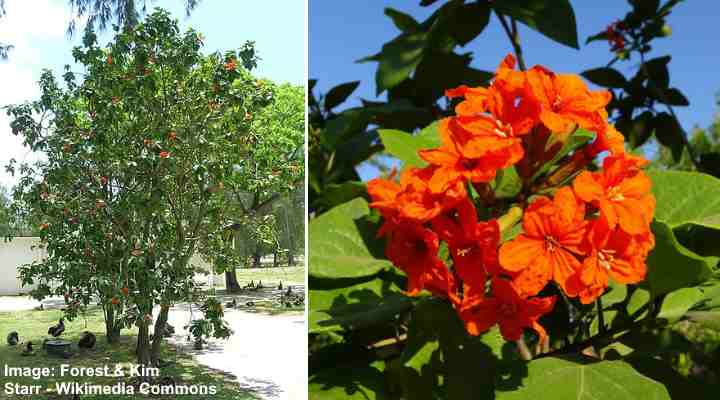
The Geiger tree is a small and delightful tree known for its vibrant orange-red flowers and heart-shaped leaves. During the summer and fall, the trumpet-shaped flowers cover the tree’s rounded canopy with bright orange hues. The geiger tree has some unique features, such as its irregular branching pattern, continuous blooming all year round, and the presence of white, egg-shaped fruits.
Native to Florida, this small orange flowering tree is commonly found in tropical landscapes. Its compact size and relatively low height make it a perfect choice for small gardens or as an accent alongside larger trees.
Coastal regions can benefit from the geiger tree as a part of their landscaping. It can tolerate salt and brackish water, making it a valuable addition to beach or seaside gardens. The best part is that it requires minimal maintenance and can thrive in various soil types, including sandy or clay soils.
Mature Size: 10 to 30 ft. (4.5 – 7.6 m) tall and up to 15 ft. (4.5 m) wide
USDA Hardiness Zones: 10 and 11
Sun: Full sun, light shade, or dappled sunlight
Ozark Witch Hazel (Hamamelis vernalis)

The Ozark witch hazel is a small tree that sheds its leaves in winter. During late winter and early spring, it produces clusters of dull orange or reddish-orange flowers, which are wonderfully fragrant. The tree is admired for its unique, spidery flowers that bloom before the leaves emerge. These witch hazel flowers have four slender, strap-shaped petals with dark red centers.
In the spring, the Ozark witch hazel tree’s foliage starts as green with a touch of bronze. Come fall, the dark green leaves change to a lovely golden yellow color, often remaining on the tree throughout the winter.
This versatile shrub-like tree can be used in various landscaping styles. It can function as a shrub border, a specimen plant, a flowering screen, or even a hedge. To maintain a tree-like appearance, it’s essential to remove suckers when they appear in spring.
Mature Size: 6 to 10 ft. (1.8 – 3 m) tall and 8 to 15 ft. (2.4 – 4.5 m) wide
USDA Hardiness Zones: 4 to 8
Sun: Full sun to partial shade
Flowering Maple ‘Victor Reiter’ (Abutilon ‘Victor Reiter’)
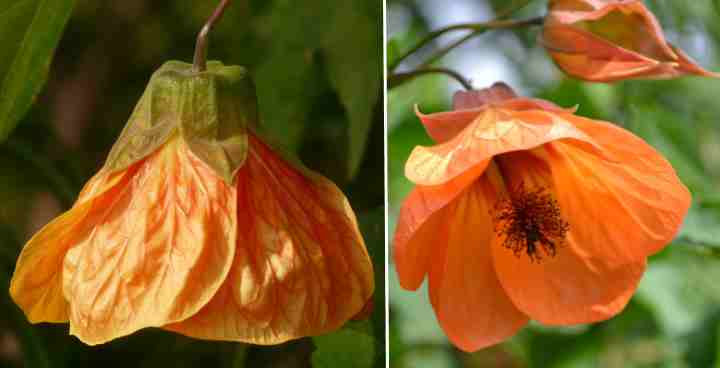
The flowering maple ‘Victor Reiter’ is a charming small tree known for its stunning bell-shaped orange flowers. These outward-facing flowers display a vibrant orange color with greenish-yellow throats. They hang gracefully from the branches, resembling dangling hibiscus flowers or colorful bells. The ‘Victor Reiter’ cultivar is especially valued for its abundant and long-lasting blooming.
This sun-loving tree has dark green leaves that resemble those of a maple. The lush foliage beautifully complements the attractive orange flowers, which bloom consistently from spring to fall. With their pretty orange blossoms, flowering maples are an excellent choice for adding a pop of color to small gardens, container gardens, or as a focal point in any landscape.
To thrive, flowering maples prefer well-drained and evenly moist soil enriched with organic matter. Their continuous blooming and attractive foliage make them popular choices for enhancing the beauty of any garden.
Mature Size: 6 to 8 ft. (1.8 – 2.4 m) tall and 4 ft. (1.2 m) wide
USDA Hardiness Zones: 9 to 11
Sun: Full sun to partial shade
Japanese Flowering Quince (Chaenomeles Japonica)
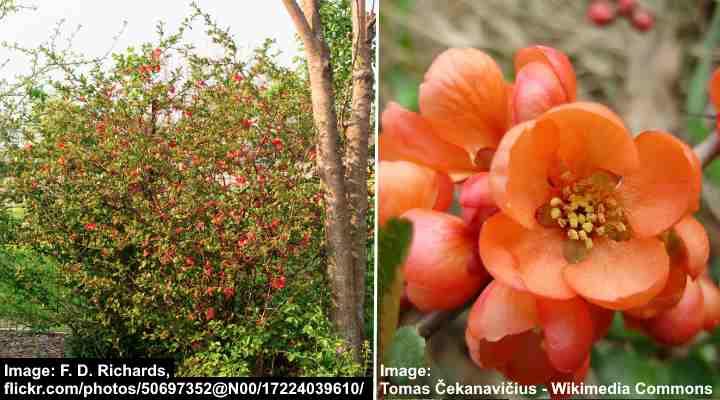
The Japanese flowering quince is a small, deciduous shrub known for its lovely orange-scarlet flowers. This compact shrub can even be grown as a dwarf ornamental tree. During early spring, the orange cup-shaped flowers appear in clusters before the leaves emerge on its thorny branches. As the orange blossoms fade, small, yellowish fruits with a tart taste take their place.
This versatile plant is perfect for landscaping. You can use it as a low-flowering hedge, a shrub border plant, or even grow it in a container. The shrub’s spiny branches, adorned with sharp thorns, make it an ideal choice for foundation plantings or as a security screen around a backyard.
Mature Size: 2 to 3 ft. (0.6 – 1 m) tall and 3 to 6 ft. (1 – 1.8 m) wide
USDA Hardiness Zones: 5 to 9
Sun: Full sun to partial sun
Chilean Orange Ball Tree (Buddleja globosa)

The orange ball tree is a striking, bushy plant known for its bright orange, tubular flowers arranged in globular clusters. These fragrant flowers bloom all through the summer, attracting butterflies, bees, and other pollinators. With its bright yellow to orange spherical flowerheads, it adds a vibrant splash of color to any sunny garden.
Also known as the orange flowering butterfly bush, this tree has lance-shaped foliage with gray-green leaves. Its rounded canopy and compact growth make it a great choice for brightening up small gardens and tight spaces. The dwarf tree is easy to prune, allowing you to maintain its size and shape effortlessly.
The Chilean orange ball tree is drought-tolerant and thrives in loamy soil with proper drainage. Additionally, it is resistant to deer, which can be helpful if you live in a rural area.
Mature Size: 10 to 15 ft. (3 – 4.5 m) tall and wide
USDA Hardiness Zones: 7 to 10
Sun: Full sun
Orange Bottlebrush Tree (Callistemon ‘Tangerine Dream’)

The orange bottlebrush tree is a shrub that can be shaped into a small ornamental tree. The ‘Tangerine Dream’ variety has bright orange flowers that resemble bottle brushes, which make it stand out. These unique flowers bloom in spring and continue sporadically throughout the year, attracting hummingbirds and butterflies.
This tree is a favorite for adding vibrant colors to gardens and landscapes. Its shrubby growth makes it perfect for creating an informal hedge or a screen of evergreen plants. Moreover, the bushy shrub thrives when grown in containers, making it an excellent choice to add brightness to patios or decks.
Mature Size: 5 to 6.5 ft. (1.5 – 2 m) tall and 3 to 5 ft. (1 – 1.5 m) wide
USDA Hardiness Zones: 10 to 12
Sun: Full sun
Coast Coral Tree (Erythrina caffra)

The coast coral tree is a captivating medium-to-large tree with striking orange flowers. Its name comes from the clusters of vibrant tubular orange flowers resembling deep orange or warm red coral. Each flower consists of one large petal surrounded by four smaller ones.
These orange flowers bloom from late winter to late spring, attracting birds and butterflies along with other pollinators. The tree’s decorative features include a large, glossy, dark green trunk with a smooth, pale brown texture, and a rounded, spreading canopy.
All species belonging to the coral tree family are recognized as the official tree of Los Angeles, California.
Keep in mind that the tree has a thorny trunk, so it might not be suitable for planting near play areas or walkways.
Mature Size: 30 to 40 ft. (9 – 12 m) tall and 23 to 36 ft. (7 – 11 m) wide
USDA Hardiness Zones: 9 to 11
Sun: Full sun
Australian Christmas Tree (Nuytsia floribunda)
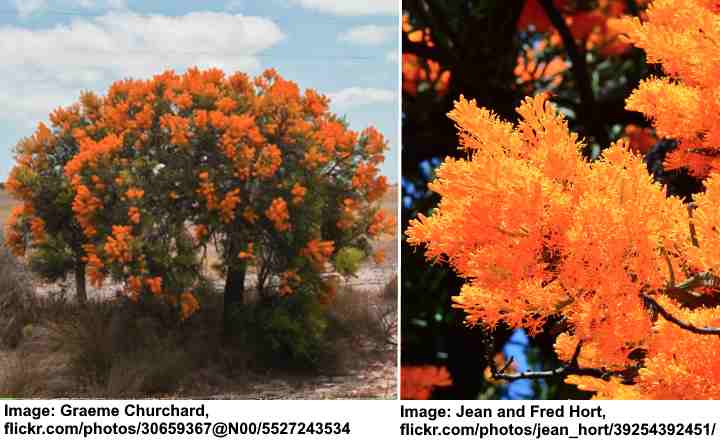
The Australian Christmas tree is renowned in the Southern Hemisphere for its stunning displays of vivid orange blooms during December. These striking orange flowers are small, tubular blooms clustered on spongy branches. In addition, the tree produces small, papery seed cases in shades of gray-green to bluish-green, and yellowish.
This hardy tree can withstand different soil types, including sandy, gravelly, and drought-prone soils. Its unique and eye-catching flowers, along with its compact growth, make the Australian Christmas tree a popular choice for gardens and landscapes.
Mature Size: Up to 33 ft. (10 m) tall
USDA Hardiness Zones: 9 to 11
Sun: Full sun to partial shade
Ashoka Tree (Saraca asoca)

The Ashoka tree is a small to medium-sized tree cherished for its lovely clusters of rich orange flowers and captivating foliage. These large bunches of flowers start out bright yellow-orange and gradually turn deep red as the season progresses. Each flower has four-petaled, star-shaped blooms with long, wiry stamens.
Besides its beautiful flowers, the Ashoka tree produces attractive evergreen foliage. The dark green leaves have a glossy texture, adding to the tree’s overall charm. They grow in dense clusters, creating a lush appearance.
The Ashoka tree is relatively easy to care for and can thrive in various soil types. It prefers well-drained soil and becomes drought-tolerant once established. Common landscaping uses for the Ashoka tree include garden borders, ornamental trees, and butterfly gardens.
Mature Size: Up to 30 ft. (9 m) tall and wide
USDA Hardiness Zones: 10 to 12
Sun: Full sun
Scarlet Sterculia (Sterculia colorata)

The scarlet sterculia is a tropical tree celebrated for its vibrant orange-reddish flowers. The tree bears large clusters of flowers that hang gracefully from its branches, creating an impressive sight in any landscape. However, it’s essential to note that despite their stunning appearance, the scarlet sterculia flowers emit an unpleasant odor.
During early spring, the sterculia tree displays a spectacular appearance as the colorful flowers bloom. Each large orange flowerhead measures about 1.2 inches (3 cm), with tubular flowers about 0.5 inches (1.3 cm) long. Approximately 30 tube-like orange flowers make up a single flowerhead.
These trees serve various purposes in a tropical landscape. With their wide-spreading canopy, they provide excellent shade, making them ideal shade trees. Their dense foliage also makes them suitable for urban gardens or for creating informal screens or hedges.
Mature Size: 30 to 50 ft. (9 – 15 m) tall and 20 to 30 ft. (6 – 9 m) wide
USDA Hardiness Zones: 6 to 9
Sun: Full sun to partial shade
Scarlet Gum Tree (Eucalyptus phoenicea)

The scarlet gum tree stands out for its vibrant and bright orange flowers that bloom in umbrella-like clusters. These striking orange flowers have ray-like clusters of yellow-tipped stamens, creating a beautiful contrast with the tree’s attractive silver-gray bark and narrow, lance-shaped gray-green leaves.
Native to Australia, the scarlet gum tree thrives in hot, dry climates. Besides its long, pointed leaves and clusters of attractive orange flowers, the tree also boasts stunning peeling orange-brown or pinkish-gray bark and a large, spreading crown.
These fast-growing trees serve multiple purposes, including providing shade and acting as windbreaks in open areas. With its dense foliage, the tree ensures privacy and creates a peaceful ambiance in the garden. Its aromatic leaves, showy flowers, and interesting bark make it visually appealing throughout all four seasons.
Mature Size: 13 to 40 ft. (4 – 12 m) tall with a widely spreading canopy
USDA Hardiness Zones: 8 to 10
Sun: Full sun
Cudjoe Wood Tree (Bonellia macrocarpa)

The cudjoe wood tree is a distinct orange-flowering tree with fascinating star-shaped orange blossoms. Originally introduced to Florida, this small, heat-tolerant tree loves the sun and grows nectar-rich flowers. It has a spreading canopy with dense, evergreen foliage, featuring lance-shaped leaves measuring 1.5 to 2.8 inches (4 – 7 cm) in length.
This tree is resilient to drought and can handle salty conditions, making it an excellent choice for coastal gardens. It thrives in well-drained soil and full sun but can also tolerate partial shade. In the spring and early summer, it blooms, attracting pollinators like bees and butterflies.
Mature Size: 6 to 15 ft. (1.8 – 4.5 m) tall
USDA Hardiness Zones: 10 and 11
Sun: Full sun
Orange Frangipani Tree (Apricot Plumeria)

The apricot frangipani tree is a tropical tree well-known for its vibrant and colorful flowers, which include stunning apricot-orange and pink blooms. These frangipani trees bear clusters of fragrant and waxy flowers with five petals that overlap to form a star shape. The orange and pink flowers emit a delightful fragrance and beautifully contrast with the tree’s glossy, dark green leaves.
Popular in tropical gardens, the frangipani tree adds a burst of color to the landscape and serves as an excellent shade tree. With their waxy leaves and striking orange flowers, these tropical trees make great focal points or specimen trees. Moreover, you can cultivate orange frangipani trees in containers, even in colder climates, and bring them indoors during the winter.
Mature Size: Up to 26 ft. (8 m) tall and 13 ft. (4 m) wide
USDA Hardiness Zones: 10 to 12
Sun: Full sun
Types of Yellow Flowering Trees (With Pictures)
Magnolia Butterfly tree (Magnolia ‘Butterflies’)
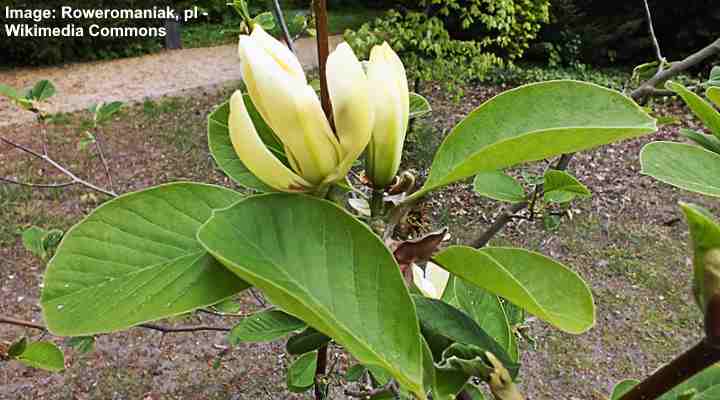
The magnolia butterfly tree is a beautiful tree with bright yellow flowers that can enhance the charm of any garden. This small deciduous tree produces large, fragrant, golden-yellow flowers in early spring. The lemon-scented blooms appear on the bare branches before the dark green leaves come out.
Magnolia butterfly trees have an upright, pyramid shape and shiny leaves. The relatively small size of this tree makes it a great option for smaller gardens, where it can be used as a specimen plant, border plant, or flowering hedge. The magnolia butterfly tree is an excellent choice to bring a splash of color and beauty to your garden.
Mature Size: 25 to 30 ft. (7.5 – 9 m) tall and 10 to 15 ft. (3 – 4.5 m) wide
USDA Hardiness Zones: 5 to 9
Sun: Full sun to partial shade
Cucumber Tree’ Yellow Bird’ (Magnolia acuminata ‘Yellow Bird’)

In late spring, the ‘Yellow Bird’ magnolia variety displays fragrant, bright yellow flowers with a tulip-like appearance. These eye-catching golden blooms beautifully stand out against the tree’s lush foliage. A distinctive trait of the cucumber tree lies in its long, cucumber-shaped fruits that transition from green to reddish-brown during autumn, which accounts for its name.
Originating from eastern North America, cucumber trees are most suitable for medium-sized to larger landscapes. With its pyramidal crown, striking yellow blossoms, and elongated cylindrical fruits, this tree serves as a splendid ornamental shade tree. Cucumber trees thrive in well-drained, organically rich, and moist soil. The tree’s appealing flowers and unique fruits make it an exceptional addition to any garden.
Mature Size: 40 to 70 ft. (12 – 21 m) tall and 20 to 30 ft. (6 – 9 m) wide
USDA Hardiness Zones: 4 to 8
Sun: Full sun to partial shade
Magnolia Tree ‘Elizabeth’ (Magnolia ‘Elizabeth’)
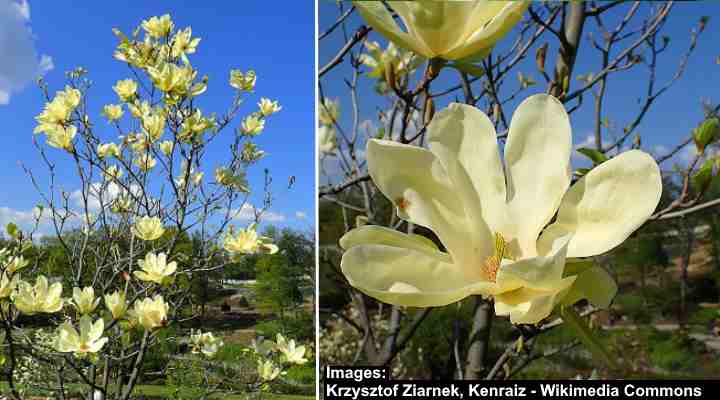
The ‘Elizabeth’ magnolia tree is a beautiful addition to any garden, renowned for its pale yellow, fragrant flowers that bloom in early spring. Its pyramidal shape and captivating yellow cup-shaped flowers with a hint of green, along with its lush, eye-catching leaves and cone-like red fruits, make it a delightful sight. The yellow flowers appear as the green leaves start to unfurl.
With its compact size, the ‘Elizabeth’ magnolia is a perfect choice for creating a focal point in small to medium-sized landscapes. You can also cultivate this yellow-flowering tree as a shade tree or standalone specimen. Grow this plant in slightly acidic, organically rich soil that is well-draining.
Mature Size: 20 to 35 ft. (6 – 10.6 m) tall and 12 to 20 ft. (3.6 – 6 m) wide
USDA Hardiness Zones: 5 to 8
Sun: Full sun to partial shade
Golden Shower Tree (Cassia fistula)
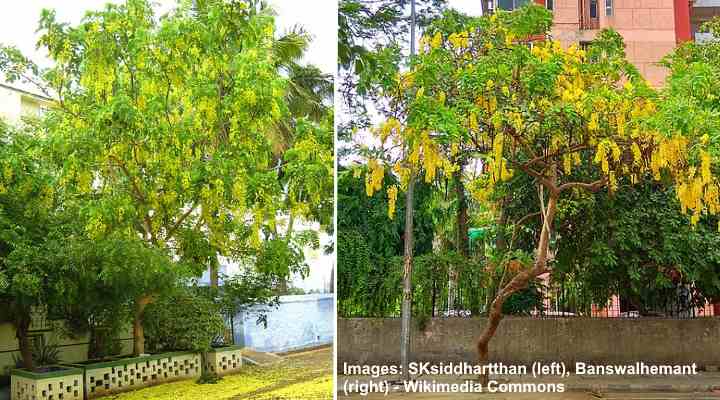
Cassia fistula
The yellow flowering golden shower tree is a captivating shade tree that can be identified by its cascading clusters of beautiful yellow flowers. Abundant golden-yellow blooms adorn the tree from late spring through summer, creating a spectacle of a bright yellow shower of blossoms. Even after flowering, woody seed pods linger on the tree until the following spring.
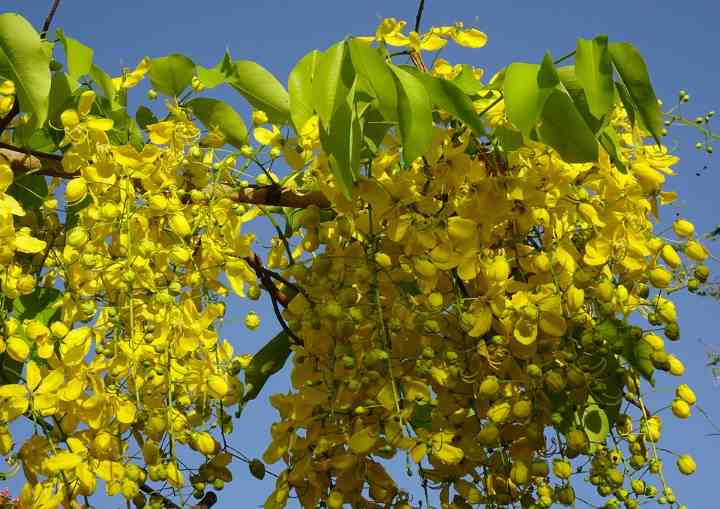
Cassia fistula
This tree is native to tropical and subtropical regions, flourishing in well-drained soil. Its rapid growth rate and decorative charm make it an excellent choice for medium- to large-sized landscapes. The vibrant yellow flowers serve as a magnet for pollinators like butterflies and bees, enhancing the beauty of your garden even further.
Mature Size: 30 to 50 ft. (9 – 15 m) tall and wide
USDA Hardiness Zones: 10 to 12
Sun: Full sun
Golden Trumpet Tree (Tabebuia chrysotricha or Handroanthus chrysotrichus)
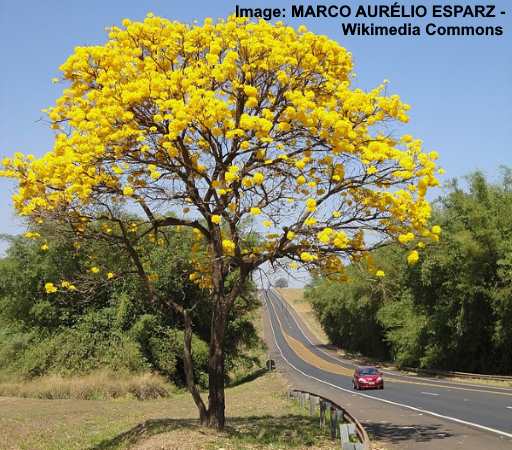
Tabebuia chrysotricha (Golden Trumpet Tree)
The golden trumpet tree is an attractive small to medium-sized tree with dazzling yellow funnel-shaped flowers. This spectacular ornamental tree comes into bloom during spring, adorning the branches with beautiful clusters of yellow flowers. Additional distinctive features include its long, dangling seed pods and silvery leaves with fuzzy undersides.
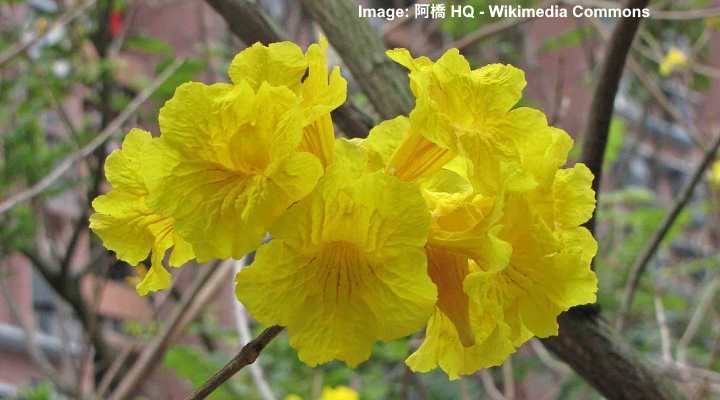
Tabebuia chrysotricha flowers
Originating from South America, the golden trumpet tree thrives in tropical and subtropical climates. It adapts well to various soil types, as long as the soil is well-draining. This yellow-flowering tree is a popular choice in Florida as a shade tree, specimen plant, or lawn tree. Moreover, it serves as an excellent attraction for native pollinators like bees and butterflies.
Mature Size: 25 to 35 ft. (7.6 – 10.6 m) tall and wide
USDA Hardiness Zones: 10 to 11
Sun: Full sun
Yellow Poui (Tabebuia ochracea)

The yellow poui is a beautiful tree that adds a bright splash of color to your garden. Its vibrant yellow, trumpet-like blooms cover the branches in early spring, creating a striking contrast with the lush green foliage. This tree is a great choice for coastal gardens because it can withstand salt spray.
To grow yellow poui trees successfully, ensure they are planted in well-drained soil and receive full sunlight. Once they are established, they are quite resilient to drought and can thrive in different types of soil. Transform your garden with a golden touch by introducing a yellow poui tree to your southern landscape.
Mature Size: Up to 35 ft. (10.6 m) tall and 30 ft. (10 m) wide
USDA Hardiness Zones: 10 to 11
Sun: Full sun
Pau D’Arco (Handroanthus serratifolius)
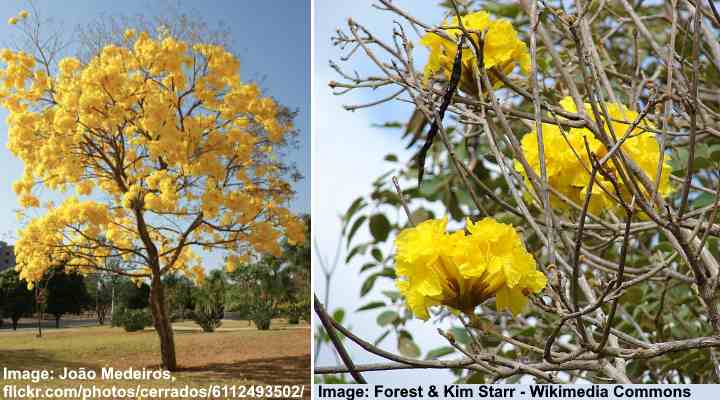
Yellow Trumpet Tree (Handroanthus serratifolius)
The Pau d’arco, also known as the yellow lapacho tree, is a beautiful addition to sunny landscapes with its bright yellow flowers. These trumpet-shaped flowers are large and bloom in clusters, creating a lively burst of color that stands out against the glossy green leaves.
One of the great features of Pau d’arco trees is their ability to tolerate drought, making them quite low-maintenance. They can thrive in various soil types, including clay, loam, and sandy soils.
Beyond their visual appeal, Pau d’arco trees serve multiple purposes. Their stunning appearance makes them perfect as shade trees, creating a lovely habitat for wildlife. Additionally, their dense foliage makes them an ideal choice for windbreaks or privacy screens.
Mature Size: 25 to 40 ft. (7.6 – 12 m) tall
USDA Hardiness Zones: 9 to 11
Sun: Full sun
Candelabra Tree (Senna didymobotrya)
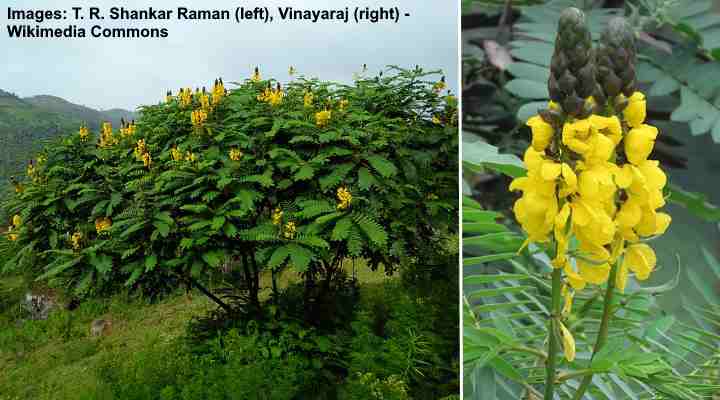
The candelabra tree is a small ornamental tree that is known for its vibrant yellow flowers. It goes by various names, like popcorn tree or peanut butter cassia. The tree’s unique features include cone-like clusters of bright yellow flowers, large oval leaves, and long bean-like seed pods. Interestingly, its golden flowers emit scents reminiscent of burnt popcorn, peanut butter, or even a wet dog.
The yellow-flowering candelabra trees prefer warm, humid climates and thrive best in well-drained, fertile soil. The small yellow flowering trees also love basking in the sun. You can use this tree as an attractive addition to your landscape, either as an ornamental tree or as an accent piece. The beautiful yellow flower clusters not only add a delightful burst of color but also invite pollinators such as butterflies and bees to your garden.
Mature Size: Up to 16 ft. (5 m) tall
USDA Hardiness Zones: 9 to 11
Sun: Full sun
Golden Wonder Tree (Senna spectabilis)

Senna spectabilis
The golden wonder tree is a delightful small ornamental tree known for its abundant, bright yellow flower clusters. These clusters can grow up to 20 inches (50 cm) long and cover the tree during the summer, presenting a stunning floral display. The tree’s fern-like foliage features pinnately compound leaves that can reach up to 3 inches (7.5 cm) in size.
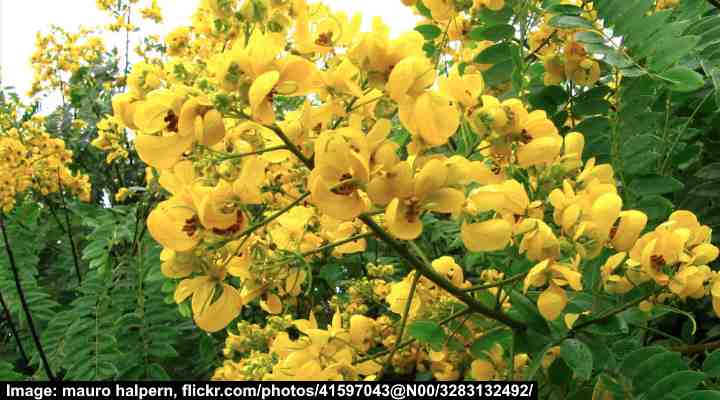
Senna spectabilis flowers
This tree’s enchanting golden yellow flowers make it a favored ornamental choice, ideal for front yards or as a shade provider in southern backyards. This appealing tree exhibits rapid growth, can withstand drought and heat, and flourishes in various soil types. If you have a tropical garden, the golden wonder tree can be an ideal addition as a yellow-flowering tree.
Mature Size: 15 to 20 ft. (4.5 – 6 m) tall and wide
USDA Hardiness Zones: 9 to 11
Sun: Full sun
Yellow Flamboyant Tree (Peltophorum pterocarpum)
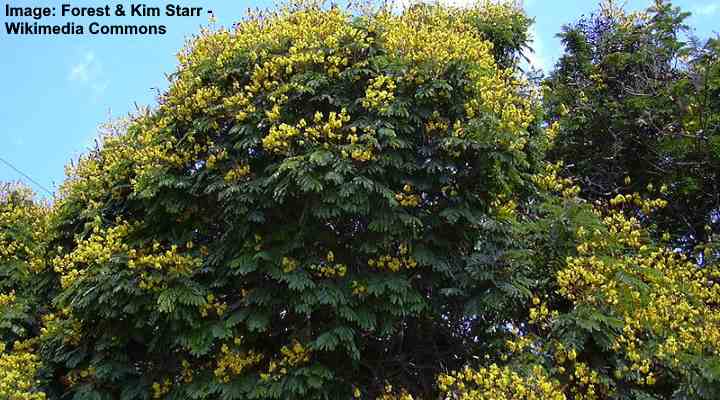
Yellow Poinciana (Peltophorum pterocarpum)
The yellow flamboyant tree is a captivating ornamental plant that displays bright yellow flowers on long stalks when it blooms in spring and summer. These vibrant yellow flower clusters cover the tree, making it truly eye-catching. The tree’s fern-like, feathery foliage adds a touch of tropical charm to sunny landscapes. Additionally, the tree produces long red seed pods, each measuring up to 4 inches (10 cm) in length.
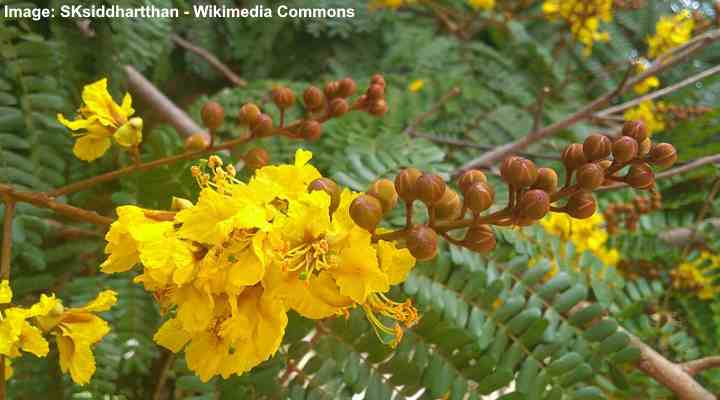
Yellow Poinciana (Peltophorum pterocarpum)
This tree goes by several names, such as the yellow poinciana, yellow flametree, or copperpod. It is a highly favored choice for ornamental trees in warm climates. Being low-maintenance, it can serve as a perfect specimen plant or create an attractive focal point in large garden landscapes.
Mature Size: 50 to 82 ft. (15 – 25 m) tall and wide
USDA Hardiness Zones: 10 to 12
Sun: Full sun
Cornelian Cherry (Cornus mas)
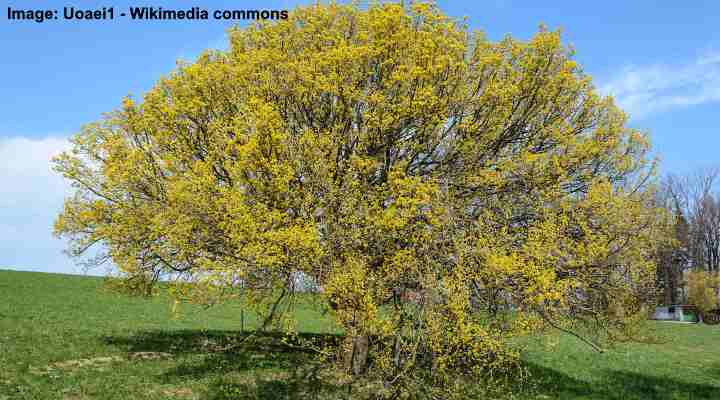
Cornelian Cherry Dogwood (Cornus mas)
The Cornelian cherry is a charming, small, bush-like tree known for its decorative qualities and its bright yellow flowers. These flowers emerge before the leaves, creating a striking display of golden-yellow blooms against the bare branches. These delightful flowers bloom in early spring, usually from late February to early March, depending on the climate and location.
As the season progresses, dark green foliage with oval leaves emerges, and by midsummer, the tree produces bright red berries.
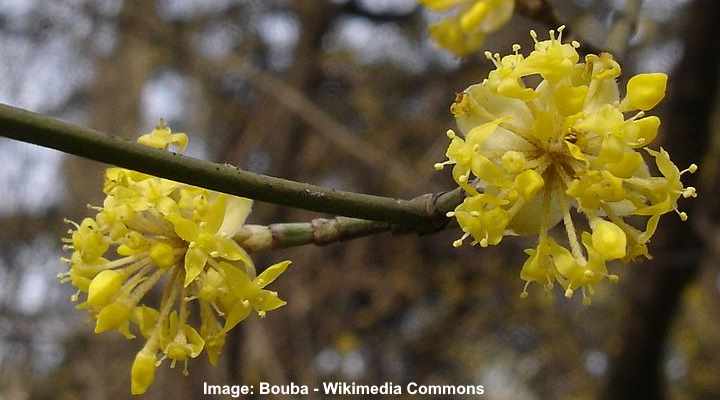
Cornus mas flowers
Cornelian cherry trees are highly adaptable and can thrive in various soil conditions. This makes them versatile enough to be used as ornamental trees, hedges, privacy screens, or specimen plants. With its appealing yellow flowers and edible red fruits, this tree is a popular choice for enhancing the visual appeal of landscapes.
Mature Size: 15 to 25 ft. (4.5 – 7.6 m) tall and 21 to 20 ft. (3.6 – 6 m) wide
USDA Hardiness Zones: 5 to 8
Sun: Full sun to partial shade
Golden Chain Tree (Laburnum anagyroides)
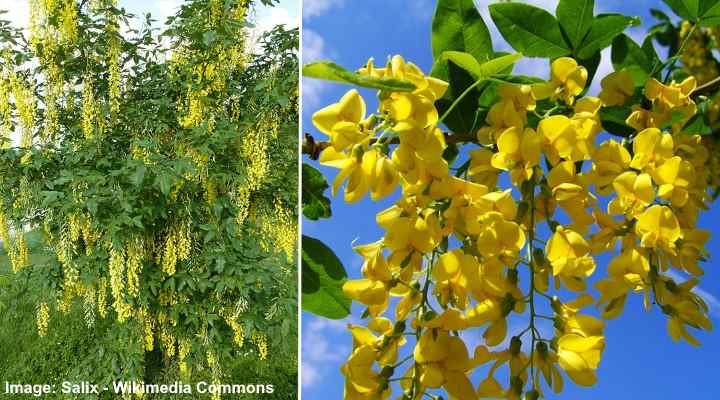
The golden chain tree is a small deciduous tree highly valued for its beautiful cascading clusters of bright yellow flowers. These lovely flowers hang down like pendulous chains from the branches, creating a stunning spectacle of color. The tree’s trifoliate leaves are a vibrant shade of green, and it produces long, flattened seed pods.
This tree is an excellent choice for temperate climates when you want to add a touch of yellow floral beauty to your landscape. Its main attraction lies in the breathtaking display of dangling yellow flower clusters. In addition, it can serve as an accent plant in urban landscapes, attracting pollinators to your garden.
However, it’s essential to be cautious since the golden chain tree is poisonous. Be mindful of planting it near areas where children or pets may play.
Mature Size: 15 to 25 ft. (4.5 – 7.6 m) tall and wide
USDA Hardiness Zones: 5 to 7
Sun: Full sun to partial shade
Weeping Scotch Laburnum (Laburnum alpinum ‘Pendulum’)
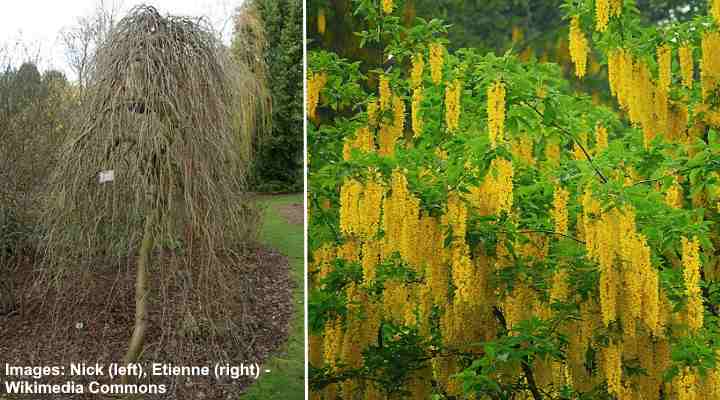
If you’re seeking a beautiful weeping tree with yellow flowers, the weeping Scotch laburnum is an excellent choice. This stunning tree features branches that cascade gracefully and are adorned with small, fragrant flowers. Its weeping habit, along with the light green foliage and long-lasting yellow flowers, make it a spectacular addition to temperate climates as an ornamental tree.
This hardy weeping tree is quite adaptable and can thrive in various well-drained soil types. Its pendulous branches and compact size make it a perfect fit for smaller gardens. You can use it as a specimen tree in small yards, tight spaces, or to enhance the curb appeal of your front yard.
Mature Size: 6.5 to 8 ft. (2 – 2.5 m) tall and up to 6.5 ft. (2 m) wide
USDA Hardiness Zones: 5 to 7
Sun: Full sun or partial shade
Yellow Flowering Camellia Tree (Camellia)
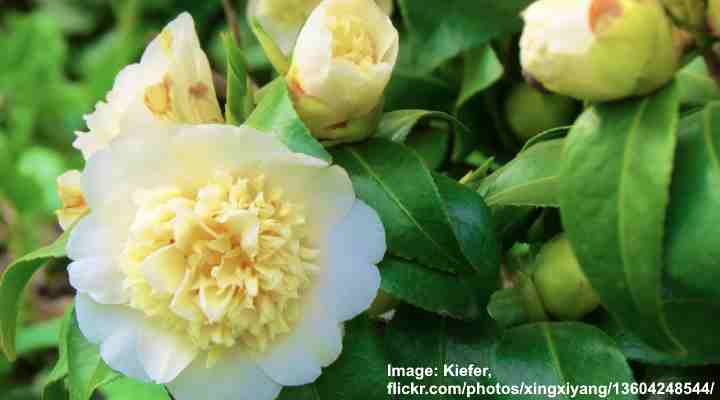
The yellow-flowering camellia trees are adorned with eye-catching yellow flowers that beautifully contrast with their dark, glossy green foliage. These evergreen camellia trees are especially renowned for their striking, large flowers, some of which have ruffled double blooms. In early spring, the trees produce an abundance of pale yellow flowers, adding a vibrant touch of color when many other plants lie dormant.
To ensure the best growth, yellow camellia trees prefer acidic and well-drained soil, while partial shade to full sun suits them well. They are versatile plants that can be used as a focal point in gardens or as a hedge to create privacy. Thanks to their stunning flowers and glossy evergreen leaves, camellia trees infuse elegance and charm into any outdoor space.
Mature Size: 10 to 13 ft. (3 – 4 m) tall and 5 to 10 ft. (1.5 – 3 m) wide
USDA Hardiness Zones: 7 to 10
Sun: Partial shade
Yellow Oleander (Cascabela thevetia)
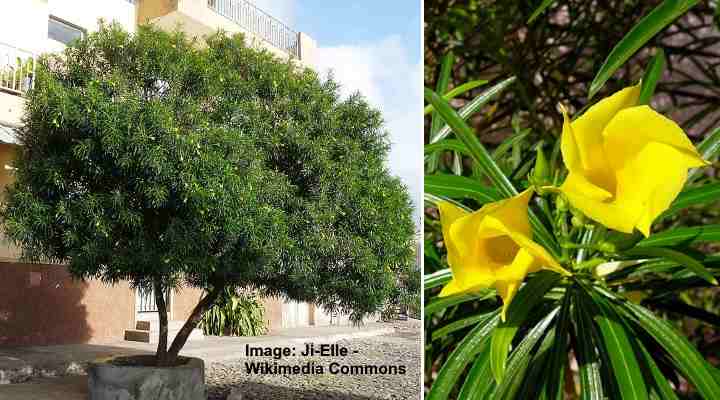
The yellow oleander is a charming, small evergreen tree celebrated for its lovely yellow trumpet-shaped flowers. This tree thrives best in warm climates, and its showy yellow blooms continue to grace the landscape from summer through fall. The tropical tree has willow-like linear leaves, and during late summer and fall, it gains additional beauty with its dark red-black seed pods.
While the yellow oleander holds great ornamental appeal, it’s crucial to be aware that all parts of this tree are toxic if ingested. Therefore, it should be planted with care, especially in areas where children or pets might be present. Despite this, it remains a popular choice for parks and gardens as a small, low-maintenance ornamental tree.
Mature Size: Up to 8 ft. (2.4 m) tall and 4 ft. (1.2 m) wide
USDA Hardiness Zones: 8 to 10
Sun: Full sun to partial shade
Lilac ‘Primrose’ (Syringa vulgaris ‘Primrose’)
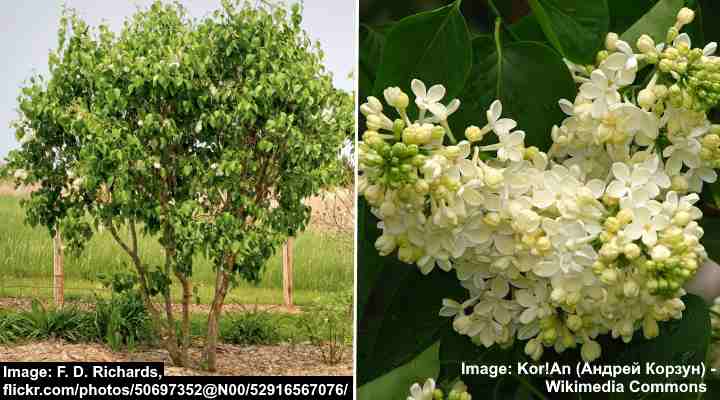
The lilac variety known as ‘Primrose’ is a stunning shrub with beautiful pale yellow flowers that can be trained to grow like a tree. During late spring, this upright deciduous shrub displays remarkable conical clusters of fragrant, pale creamy-yellow flowers. These captivating blooms last for about four weeks, attracting butterflies and bees while also adding to the overall charm of any garden.
The lilac tree ‘Primrose’ features green, heart-shaped leaves that turn yellow in the fall, contributing a delightful splash of autumn colors to your garden. This shrub is low-maintenance and thrives easily in well-drained soil.
Thanks to its striking spring blooms, you can use the yellow-flowering lilac ‘Primrose’ as a flowering hedge, for foundation planting, or as part of a perennial border to enhance the beauty of your landscape.
Mature Size: 10 to 12 ft. (3 – 3.6 m) tall and wide
USDA Hardiness Zones: 4 to 7
Sun: Full sun to partial shade
Yellow Bells (Tecoma stans)

One of the most striking yellow-flowering trees you can grow is the yellow bells, also known as the yellow trumpet flower. This lovely tree has a shrub-like appearance and produces clusters of brightly colored, funnel-shaped tubular flowers. Its vibrant yellow blooms adorn the tree continuously from spring all the way to the first frost, creating a breathtaking display that lasts throughout the season.
The yellow bells tree is native to Texas, Florida, and New Mexico. It’s a hardy tree, capable of withstanding both heat and drought, making it an excellent choice for brightening up xeriscape gardens in dry, desert conditions. Additionally, this tree is relatively low-maintenance and can be easily pruned to retain its desired shape and size.
Mature Size: 10 to 25 ft. (3 – 7.5 m) tall and wide
USDA Hardiness Zones: 9 to 11
Sun: Full sun or partial shade
Tulip Tree (Liriodendron tulipifera)
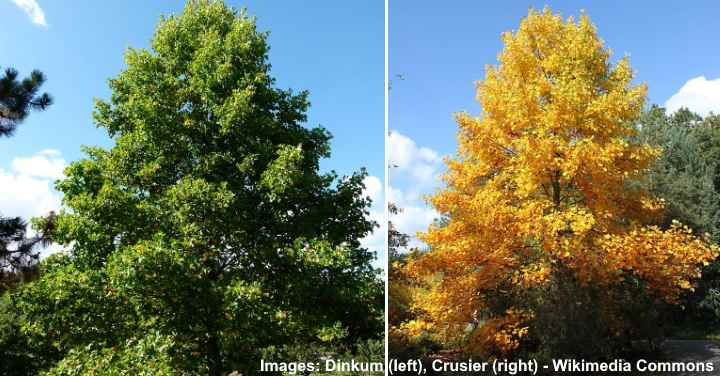
Tulip poplar trees – summer and autumn foliage
The tulip tree is a sizable deciduous tree known for its distinctive, tulip-shaped, yellowish-green flowers. These cup-like flowers face upward and display hues of yellow, orange, and green, blooming from late spring to early summer. The tree’s foliage is equally stunning, featuring four-lobed leaves and cone-like fruit. As autumn arrives, the tulip tree’s foliage turns into a beautiful shade of yellow.

American tulip tree flower
With their rapid growth, tulip trees can reach impressive heights, making them excellent choices for shade trees. These ornamental trees feature an oval, rounded crown that offers year-round interest due to their eye-catching flowers, glossy foliage, and brown, conical fruits.
Mature Size: 60 to 80 ft. (18 – 24 m) tall and 30 to 40 ft. (9 – 12 m) wide
USDA Hardiness Zones: 4 to 9
Sun: Full sun
Yellow African Tulip Tree (Spathodea campanulata ‘Aurea’)
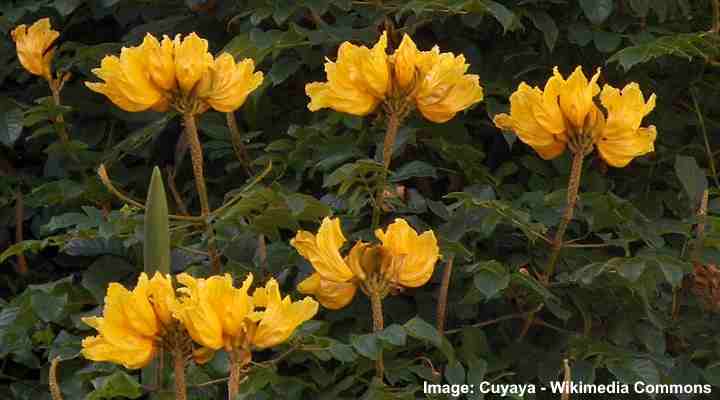
The yellow African tulip tree is a fast-growing tree that features large, cup-shaped yellow flowers. When these flowers bloom in clusters, they create a captivating and vivid display of yellow against the tree’s dark green foliage. This tropical evergreen has an upright, rounded canopy, which provides much-needed shade in hot and humid climates.
With moderate to high salt tolerance and moderate water requirements, the yellow African tulip tree can adapt well to different conditions.
Mature Size: 52 – 75 ft. (16 – 22 m) tall and 15 to 25 ft. (4.5 – 7.6 m) wide
USDA Hardiness Zones: 10 to 12
Sun: Full sun
Kousa Dogwood (Cornus kousa)

The kousa dogwood is a charming, small tree known for its striking star-shaped golden-yellow flowers. These lovely blooms appear in spring and consist of yellowish-white bracts surrounding a cluster of green flowers. When autumn arrives, the tree’s ovate leaves display eye-catching shades of purple, lavender, or burgundy.
Adding to its appeal, the kousa dogwood produces small edible red drupes that attract birds and wildlife during late summer and early fall. In winter, the tree’s exfoliating bark reveals an attractive patchwork of gray, tan, and brown, creating visual interest in the landscape.
Kousa dogwoods are adaptable and can thrive in well-drained, acidic soils, making them versatile for various conditions. Landscape uses for kousa dogwoods include as specimen plants or planted in groups to create a beautiful display of colors in the landscape. With its stunning flowers, appealing bark, and vibrant fall foliage, the kousa dogwood offers year-round interest for any garden.
Mature Size: 20 to 30 ft. (6 – 10 m) tall and wide
USDA Hardiness Zones: 5 to 8
Sun: Full sun to partial shade
Palo Brea (Parkinsonia praecox)

The yellow-flowering palo brea is easily recognized by its chartreuse-green bark, twisted branches, and broad umbrella-like canopy. As a small ornamental tree, it graces the landscape with bright yellow flowers during mid- to late-spring. Against the backdrop of its green bark and small, feathery blue-green leaves, the yellow blooms create a vibrant and eye-catching floral display.
Palo brea trees are well-equipped to handle drought and extreme heat, making them resilient in arid conditions. These sun-loving trees are particularly suitable for xeriscape landscapes or as specimen trees in desert gardens. Their distinctive green bark and cheerful yellow flowers have made them a popular choice for adding both color and visual interest to desert landscapes.
Mature Size: 20 to 25 ft. (6 – 7.6 m) tall and wide
USDA Hardiness Zones: 9 to 11
Sun: Full sun
Blue Palo Verde (Parkinsonia florida)
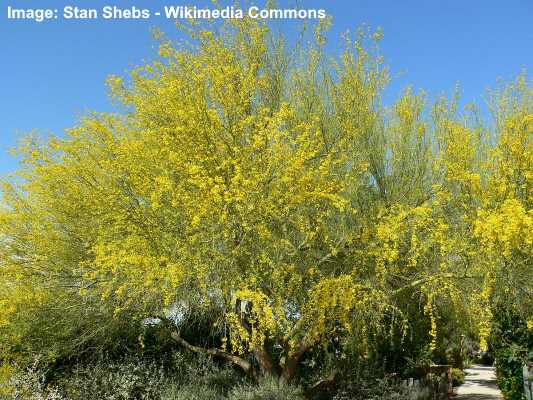
Blue palo verde (Parkinsonia florida) tree in bloom
The blue palo verde is a unique small to medium-sized tree, recognized by its distinct blue-green bark and stunning clusters of bright yellow flowers. This tree stands out with its blue-green bark, small compound leaves, and papery yellow flowers adorned with red stamens. During spring, the tree is adorned with a golden yellow hue, creating a vibrant sight in arid landscapes.
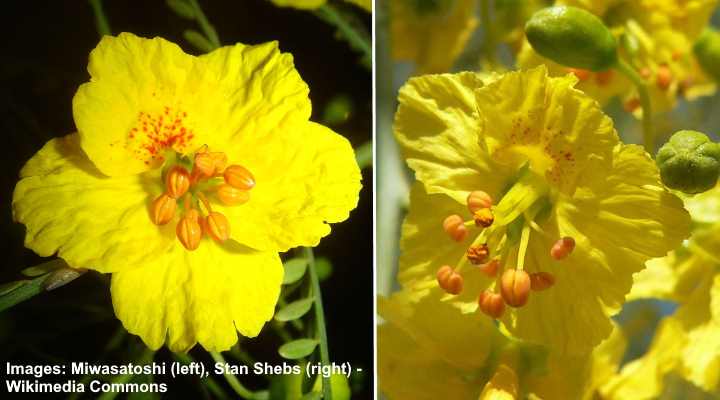
Parkinsonia florida flower
Native to California, Nevada, and Arizona, the blue palo verde is a yellow-flowering tree that thrives in arid climates and can withstand drought and poor soil conditions. Its resilient growth makes it a perfect choice for xeriscape landscapes, desert gardens, and erosion control in challenging soils.
In fact, the blue palo verde holds the distinction of being the state tree of Arizona.
Mature Size: 20 to 25 ft. (3 – 7.5 m) tall and up to 20 ft. (6 m) wide
USDA Hardiness Zones: 8 to 11
Sun: Full sun
Palo Verde (Parkinsonia aculeata)
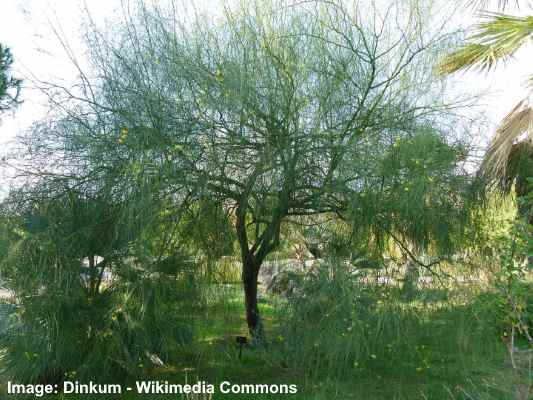
The palo verde is a small deciduous tree that displays clusters of fragrant, orange-yellow flowers. This tree is easily recognizable by its distinctive bright-green bark and compound, bipinnate leaves. It also features thorny branches and slender, bean-like seed pods.

Originating from the southwestern United States, the palo verde thrives in arid and semi-arid environments. Once established, it is resilient to drought, salt, and heat. For best results, plant it in well-drained soil. Whether you want to use it as a focal point or a shade tree, the palo verde will be a valuable and attractive addition to your landscape.
Mature Size: 15 to 20 ft. (4 to 6 m)
USDA Hardiness Zones: 8-11
Sun: Full sun
Yellow Bell Orchid Tree (Bauhinia tomentosa)
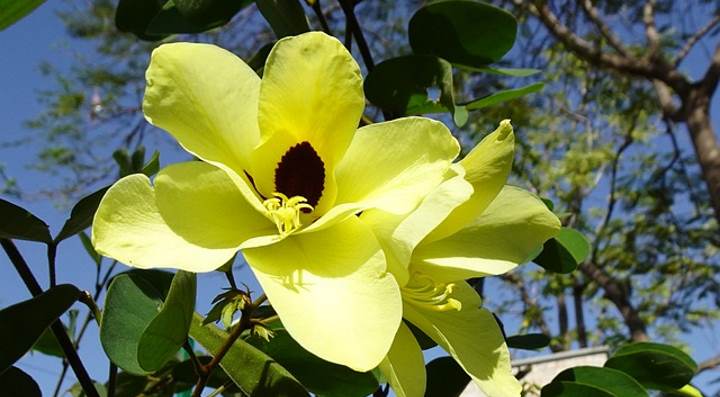
The yellow bell orchid tree is celebrated for its vibrant yellow bell-shaped flowers, resembling orchids. These distinctive flowers showcase large, pale greenish-yellow petals with a dark maroon base, creating a striking display. Another appealing feature of this ornamental tree is its unique leaves, which have two oval lobes resembling wings, along with long, flattened brown seed pods.
Amidst the dark green foliage, the exotic yellow flowers truly stand out, adding a touch of beauty to the landscape.
Yellow orchid trees are native to tropical and subtropical regions and thrive best in well-drained soil. Once established, they are drought-tolerant and require six to eight hours of sunlight daily. In addition, their delightful, nectar-rich, fragrant flowers attract butterflies and bees throughout the summer, making them a charming addition to any garden.
Mature Size: Up to 24 ft. (7 m) tall and wide
USDA Hardiness Zones: 9 to 11
Sun: Full sun
Yellow Buckeye (Aesculus flava)
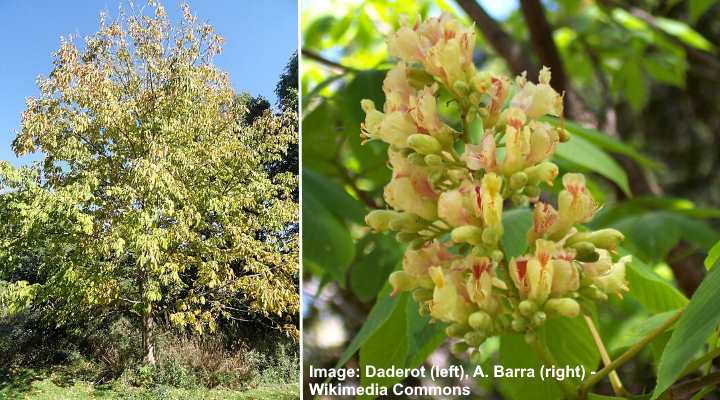
Yellow Buckeye (Aesculus flava)
The yellow buckeye tree is an impressive deciduous tree known for its conical clusters of yellow flowers that bloom during spring and summer. These creamy-yellow tubular flowers form upward-facing cone-like spikes, creating a delightful contrast with the tree’s large, palmate leaves. When autumn arrives, the tree’s foliage transforms into stunning shades of orange and golden yellow.
The yellow buckeye trees are easily identifiable by their large, round seed capsules. These smooth, leathery capsules contain one to three shiny brown nuts and drop in the fall, providing a valuable food source for wildlife.
Due to their tall stature, yellow buckeye trees make excellent shade trees for large gardens or parks. Their adaptability is evident, as they can thrive in both drought-prone areas and marshy ground near ponds and streams. The yellow flowers and overall beauty of this shade tree make it a wonderful addition to any landscape.
Mature Size: 40 to 60 ft. (12 – 18 m) tall and 30 to 40 ft. (10 – 11 m) wide
USDA Hardiness Zones: 3 to 8
Sun: Full sun to partial shade
Cootamunda Wattle (Acacia baileyana)
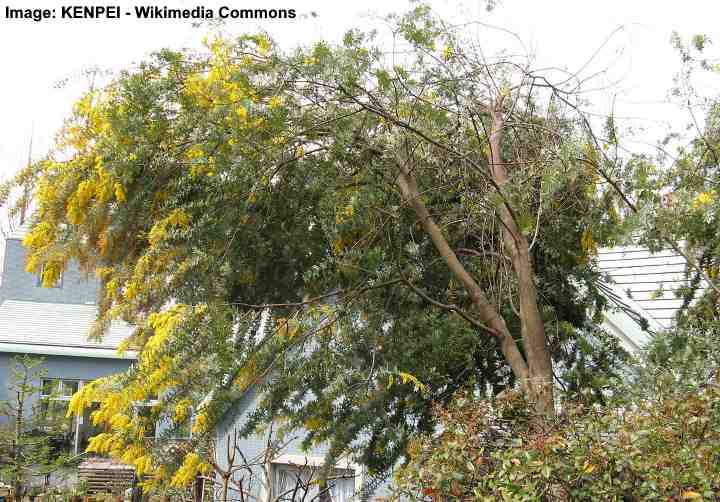
The cootamunda wattle is a stunning evergreen thorny tree, known for its clusters of fluffy, ball-shaped yellow flowers. This wattle tree stands out with its silvery-gray fern-like leaves cascading from weeping branches and forming a wide-spreading canopy. Its unique evergreen foliage and abundant yellow spring flowers make it a delightful ornamental addition to any landscape, offering year-round appeal.
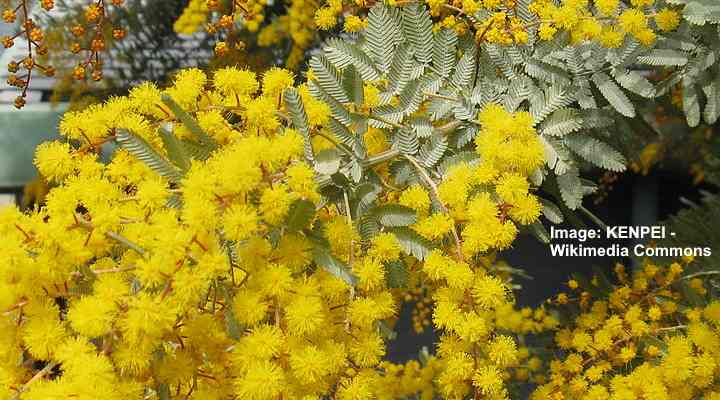
Cootamunda wattle trees are resilient to drought and can thrive in various soil types, such as sandy, loamy, and clay soils. As a versatile tree, you can plant it as a specimen tree, border plant, or lawn tree, even in smaller gardens, to enjoy its beauty and charm.
Mature Size: 20 to 30 ft. (6 – 9 m) tall and wide
USDA Hardiness Zones: 9 to 11
Sun: Full sun
Long Leaf Wattle (Acacia longifolia)

Also known as the golden wattle, the long-leaf wattle is a yellow-flowering evergreen tree native to Australia. It showcases clusters of fragrant, greenish-yellow cylindrical flower spikes, reaching up to 2 inches (5 cm) in length. Following the blooming period, twisted and leathery seed pods emerge, measuring up to 6 inches (15 cm) long. The tree features long and narrow leaves, lending it an elegant appearance throughout the year.
Long-leaf wattle trees are rapid growers and serve various landscaping purposes. In arid regions, you can use them as flowering hedges, privacy screens, or shade trees alongside patios in smaller gardens. These trees are also suitable for coastal gardens due to their ability to withstand salt spray.
Mature Size: 20 to 30 ft. (6 – 9 m) tall and wide
USDA Hardiness Zones: 9 to 11
Sun: Full sun
Silver Wattle (Acacia dealbata)
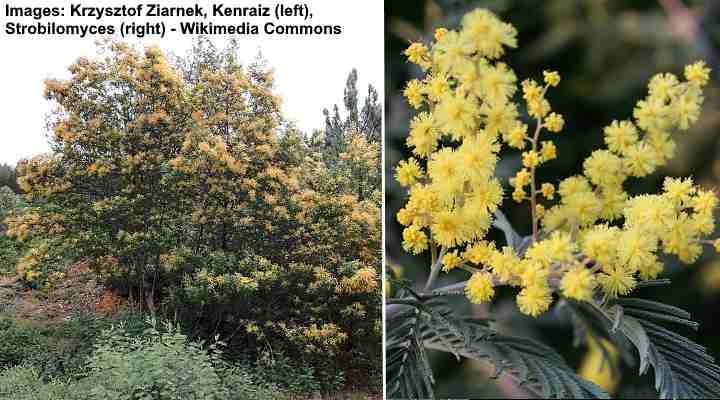
The silver wattle, also known as the mimosa tree, is a fast-growing evergreen tree that captivates with its stunning clusters of fluffy, yellow, and fragrant flowers. The bright yellow ball-shaped flowers beautifully contrast against the tree’s feathery, silvery-blue evergreen foliage. This delightful display takes place in late winter or early spring.
With its flowers attracting bees and butterflies, the silver wattle becomes even more alluring. This versatile tree can be utilized as a lawn tree or a specimen plant in various landscape settings. For optimal growth, ensure it is planted in well-drained soil and receives full sun exposure. The silver wattle adds charm and intrigue to any garden with its distinctive foliage and vibrant flowers.
Mature Size: 40 to 50 ft. (12 – 15 m) tall and wide
USDA Hardiness Zones: 9 to 11
Sun: Full sun
Golden Wattle (Acacia pycnantha)
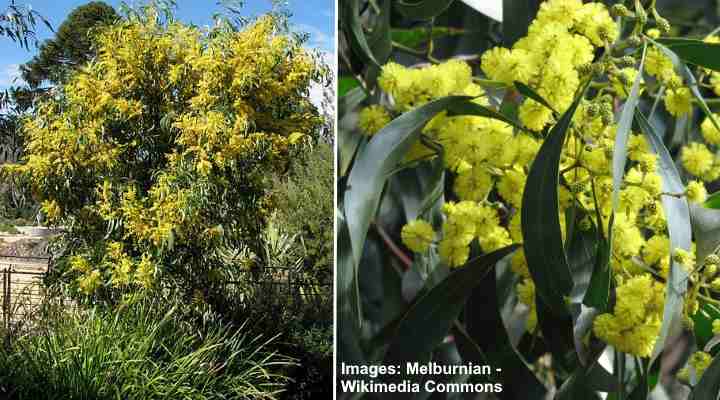
The golden wattle is a medium-sized tree known for its clusters of bright yellow, ball-shaped flowers that grow in late winter and early spring. These fragrant flowers are a magnet for bees and butterflies, enriching your garden’s ecosystem. As a native Australian tree, it features long, thin, vibrant green leaves measuring 6 inches (15 cm).
Being the national floral emblem of Australia, the golden wattle is both significant and beautiful. Its ability to tolerate drought makes it a resilient addition to gardens and landscapes, providing a burst of color from late winter through summer. With its evergreen foliage, the golden wattle is an ideal choice for creating screens, windbreaks, or hedges in your outdoor space.
Mature Size: 20 to 30 ft. (6 – 9 m) tall and wide
USDA Hardiness Zones: 9 to 11
Sun: Full sun to partial shade
Sweet Acacia (Vachellia farnesiana)
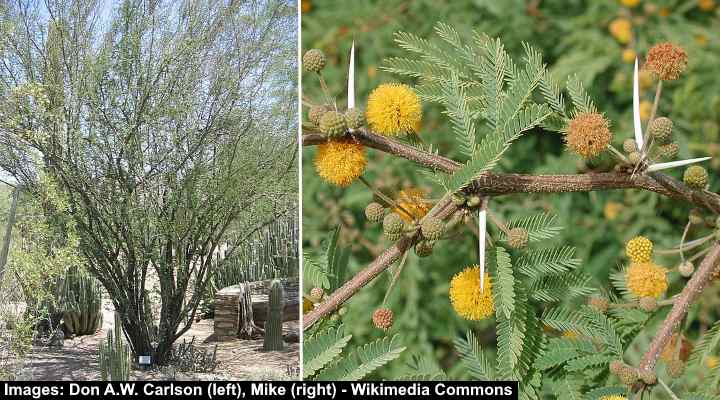
Texas Huisache (Sweet Acacia) (Vachellia farnesiana)
The sweet acacia tree is a dwarf tree known for its dazzling clusters of puffball-like, yellow-golden flowers. Its charming blossoms emit a sweet fragrance, drawing the attention of bees, butterflies, and other pollinators during late winter and spring. Adding to its appeal are the feathery, fern-like leaves that give the tree an ornamental touch.
These trees flourish in loose, dry to medium, well-drained soils. Once established, they are tolerant of both drought and salt, making them suitable for coastal gardens and foundation plantings. In addition, the sweet acacia’s thorny branches and evergreen foliage create an excellent security screen.
Mature Size: 15 to 20 ft. (4.5 – 6 m) tall and wide
USDA Hardiness Zones: 9 to 11
Sun: Full sun to partial shade
Golden Wreath Wattle (Acacia saligna)
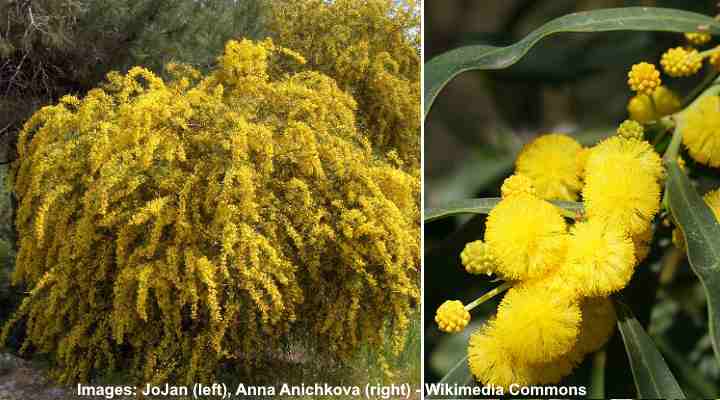
The yellow flowering golden wreath wattle is a versatile plant that can be used as either a small tree or a large shrub. It is renowned for its stunning bright yellow spherical flowers that emerge during spring. These flowers create a stunning contrast against the tree’s long, lanceolate, blue-gray leaves, which can reach lengths of up to 10 inches (25 cm). As the season progresses, clusters of long, flattened seed pods develop, containing round, black seeds.
This ornamental tree is popular in parks and gardens. The tree is fast-growing, drought-tolerant, and resilient to high temperatures and desert-like conditions. While it adapts to various soil types, it thrives best in well-draining soils with sandy or loamy textures. With its vibrant flowers and attractive foliage, the golden wreath wattle is a delightful addition to any landscape.
Mature Size: 10 to 26 ft. (3 to 8 m)
USDA Hardiness Zones: 9-11
Sun: Full sun
Goldenball Leadtree (Leucaena retusa)
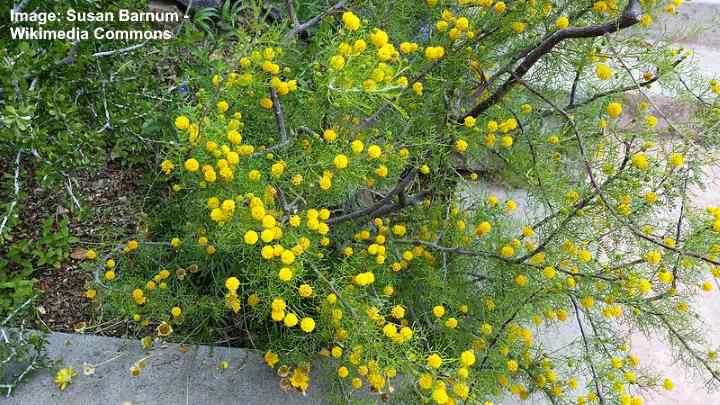
Goldenball Leadtree (Leucaena retusa)
The goldenball leadtree is a delightful, small tree known for its clusters of golden-yellow powder-puff flowers. Throughout spring and fall, the tree blooms with fluffy yellow flowers, showcasing its pinnately compound leaves and long brown seed pods, which measure about 6 inches (15 cm). After periods of rainfall, the leadtree bursts into brilliant golden-yellow colors.
Native to the southwestern United States and northern Mexico, these ornamental yellow-flowering trees feature arching, drooping stems, making them a lovely accent tree in backyard gardens. Well-suited for southern gardens, they have a high tolerance to drought, heat, and salt, ensuring their resilience in various conditions.
Mature Size: 20 to 25 ft. (6 – 7.6 m) tall and wide
USDA Hardiness Zones: 7 to 9
Sun: Full sun
Yellow Silk Cotton Tree (Cochlospermum religiosum)

The yellow silk cotton tree is a charming tropical tree that is known for its stunning buttercup yellow flowers. These large, showy flowers create a beautiful display, making the tree a true delight during spring and summer. Furthermore, the tree produces seeds enveloped in a fluffy, cotton-like substance.
Often referred to as the buttercup tree, the yellow silk cotton tree serves well as an accent plant or ornamental tree in xeriscapes. Its wide, spreading canopy also makes it an excellent shade tree, adding a touch of exotic beauty to gardens in tropical and subtropical regions.
Mature Size: Up to 25 ft. (7.5 m) tall and wide
USDA Hardiness Zones: 9 to 11
Sun: Full sun
Mexican Bird of Paradise (Caesalpinia mexicana)

The Mexican bird of paradise is a charming small tree that blooms during summer and fall, showcasing extravagant clusters of bright yellow flowers. These attractive flowers elegantly dangle in showy racemes, measuring about 6 inches (15 cm) long. Following the blooming season, large, curled seed pods become visible. In regions without frost, this ornamental tree retains its evergreen bipinnate leaves.
Mexican bird of paradise trees are highly sought-after for their appealing fern-like foliage and showy yellow flowers. With its rapid growth and shrub-like appearance, it serves perfectly as an accent plant or flowering tree, bringing beauty and allure to any landscape.
Mature Size: 10 to 15 ft. (3 – 4.5 m) tall and wide
USDA Hardiness Zones: 9 to 11
Sun: Full sun
Pineapple Broom Tree (Cytisus battandieri)
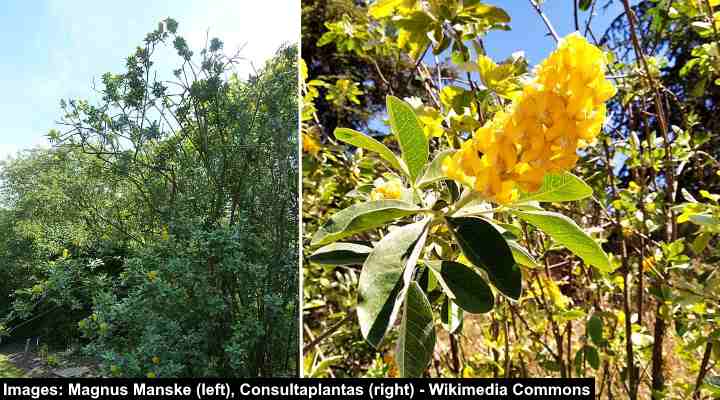
The pineapple broom tree is celebrated for its dense clusters of yellow flowers, reminiscent of peas. These attractive flowers bloom on upright cylindrical spikes, releasing a delightful pineapple-like fragrance. During late spring and throughout summer, this stunning ornamental tree transforms backyards with its vibrant green and yellow colors.
Also known as the Moroccan broom tree, it features gray-green, needle-like leaves that introduce an intriguing texture to the landscape. Pineapple broom trees are highly adaptable to drought conditions and can thrive even in poor soil. You can incorporate this yellow-flowering tree into your garden as an accent plant, a beautiful flowering specimen tree, or a strategic choice to attract pollinators and wildlife.
Mature Size: Up to 13 ft. (4 m) tall and wide
USDA Hardiness Zones: 7 to 10
Sun: Full sun
Willow Pittosporum (Pittosporum phillyreoides)
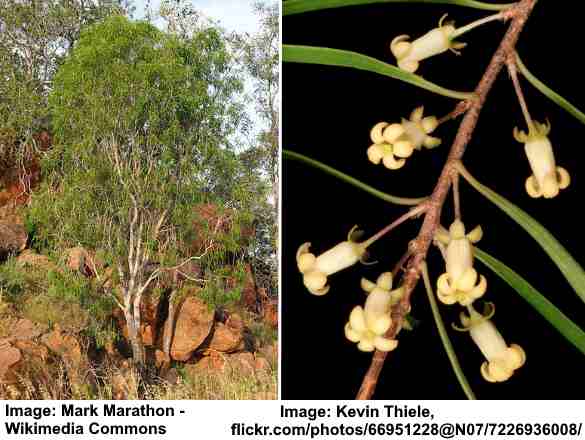
The willow pittosporum is a charming small tree with multiple trunks that produces clusters of dainty yellow flowers. This ornamental pittosporum tree has a graceful weeping habit, adding to its overall appeal. Its glossy green, slender leaves and orange, ball-shaped fruits further enhance its beauty.
Willow pittosporum trees offer versatility, making them suitable as lawn trees or attractive specimen plants in xeric landscapes. The upright, weeping growth pattern allows them to fit perfectly in gardens with limited space or tight corners. In addition, the delightful fragrance of its yellow flowers makes it a magnet for bees and butterflies.
Mature Size: 20 to 30 ft. (3 – 9 m) tall and wide
USDA Hardiness Zones: 7 to 11
Sun: Full sun
Silver Linden (Tilia tomentosa)

The silver linden tree is famous for its gleaming leaves and clusters of fragrant creamy-white to pale-yellow flowers. This sizeable deciduous tree has a pyramid shape and showcases hanging flower clusters in spring. Its notable feature is its heart-shaped leaves with dark green tops and fuzzy silver-gray undersides.
Silver linden trees are low-maintenance and perfect for providing shade or serving as lawn trees in spacious gardens. The tree’s additional attractions are its yellow foliage during autumn, silvery-gray bark, and appealing winter outline. Moreover, being a substantial ornamental tree, it also offers a habitat for birds and other wildlife.
Mature Size: 50 to 70 ft. (15 – 21 m) tall and 30 to 50 ft. (9 – 15 m) wide
USDA Hardiness Zones: 4 to 7
Sun: Full sun to partial shade
Large-Leaved Linden (Tilia platyphyllos)
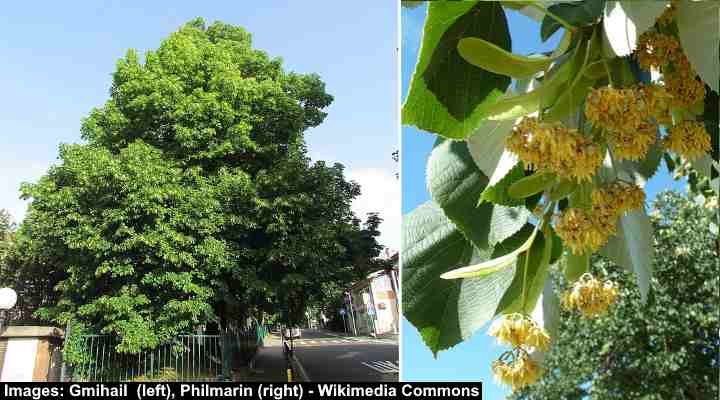
The large-leaved linden is an impressive deciduous tree with eye-catching creamy-yellow flower clusters, rounded leaves, and a broad, pyramidal crown. This beautiful shade tree can reach heights of up to 80 ft. (24 m) and spreads up to 50 ft. (15 m) wide. Like other flowering linden trees, it serves as a magnet for bees during the summer.
This spreading deciduous tree thrives best in well-drained, moist soil. It’s a perfect choice for various landscaping purposes, such as a lawn, shade, or street tree. Moreover, you can even train the large-leaved linden to grow into a tall and attractive privacy hedge.
Mature Size: 60 to 80 ft. (18 – 24 m) tall and 30 to 50 ft. (9 – 15 m) wide
USDA Hardiness Zones: 3 to 7
Sun: Full sun to partial shade
Verawood (Bulnesia arborea)
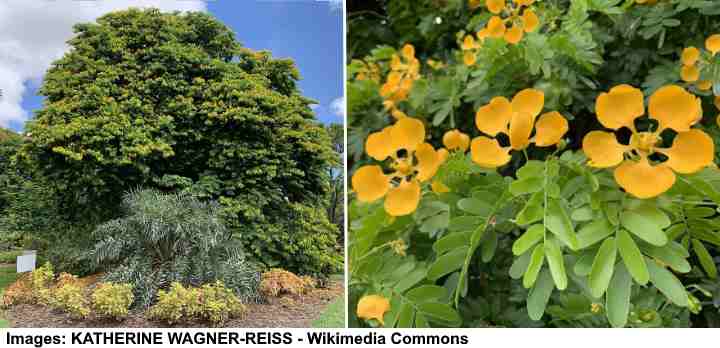
The verawood tree is an evergreen tree that is highly valued for its stunning yellow ornamental flowers. It grows slowly and features bright orange-yellow flowers that have five round or spoon-shaped petals, resembling an open star. These charming flowers appear in small clusters, standing out against the fern-like foliage. As the tree matures, it forms a graceful, drooping, umbrella-like canopy, enhancing its decorative appeal.
The verawood tree is an excellent choice for small to medium-sized landscapes, backyards, or as a shade tree near a patio. This hardy and resilient tree blooms for an impressive two to three months and can tolerate poor soil conditions. However, proper pruning is essential during its early growth stages to ensure a beautiful and attractive upper canopy.
Mature Size: 20 to 30 ft. (6 – 10 m) tall and wide
USDA Hardiness Zones: 10 to 12
Sun: Full sun
Chinese Flame Tree (Koelreuteria bipinnata)
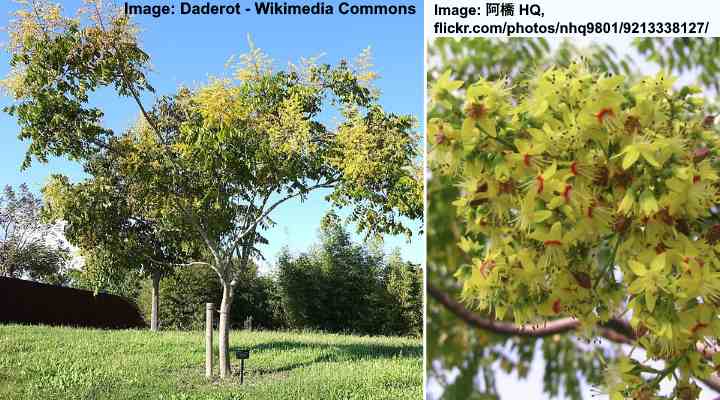
Chinese Flame Tree (Koelreuteria bipinnata)
The Chinese flame tree is a captivating deciduous tree known for its beautiful yellow flowers. This native Asian tree stands out with its vase-shaped, flat-topped canopy, long pinnately compound leaves, and clusters of delicate rosy-pink lantern-like seed capsules. However, it is the abundance of striking yellow flowers that truly makes the Chinese flame tree a beloved choice in garden landscapes.
The Chinese flame tree has year-round appeal, with stunning fall colors, an abundance of attractive flowers, intriguing papery seed pods, and smooth, light-brown bark. It is favored for various landscaping purposes, such as planting as a specimen tree or for providing shade.
Mature Size: 20 to 40 ft. (6 – 12 m) tall and wide
USDA Hardiness Zones: 7 to 9
Sun: Full sun
Tipu Tree (Tipuana tipu)
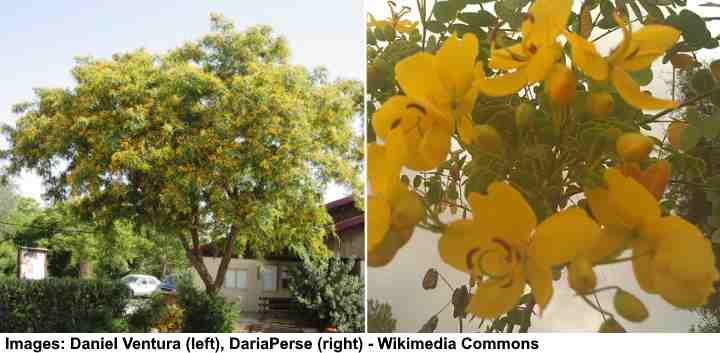
The tipu tree is an appealing shade tree adorned with clusters of bright yellow flowers resembling small trumpets. These funnel-shaped yellow flowers bloom from spring through fall, creating a lovely contrast with their large, pinnately compound leaves that measure 10 inches (25 cm) in length. During the fall season, the tipu tree sheds its leaves and releases an abundance of winged seed pods known as samaras.
Also known as the pride of Bolivia or rosewood, this ornamental tree adds year-round beauty to your yard, making it an excellent focal point in front yards to enhance curb appeal. Additionally, tipu trees are perfect as shade trees in backyards, especially when planted beside a patio.
With their drought-tolerant nature and ability to withstand hot and dry conditions, tipu trees thrive well in desert landscapes or xeric gardens.
Mature Size: Up to 98 ft. (30 m) tall and 66 ft. (20 m) wide
USDA Hardiness Zones: 9 to 11
Sun: Full sun
Scholar Tree (Sophora japonica)
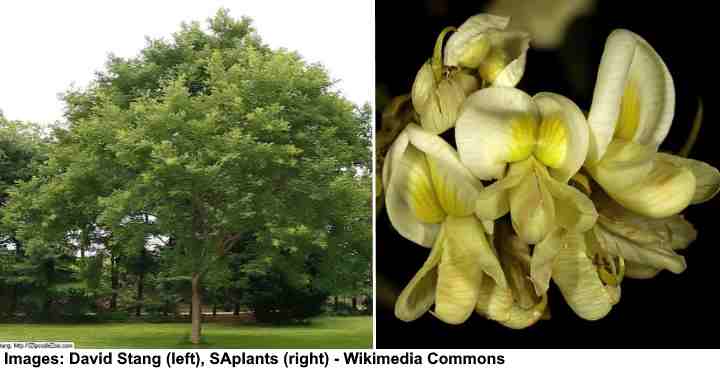
The scholar tree, also known as the Japanese pagoda tree, is highly valued as a shade tree for its attractive, drooping clusters of greenish-white to yellow blooms. These fragrant, pea-like flowers emerge in midsummer and persist for several weeks, adding beauty to the landscape. Following the flowering period, the tree produces decorative seed pods resembling “beads on a string.” During the fall season, its compound leaves turn a lovely golden yellow.
Scholar trees are versatile and can thrive in various soil types, including clay, loam, and sandy, as long as the soil is well-drained. This ornamental tree is popular for providing both shade and aesthetic appeal to any landscape. In addition, it can withstand drought conditions and salt spray, making it suitable for planting in coastal environments.
For those with compact or smaller yards, specific scholar tree cultivars like the weeping ‘Pendula’ scholar tree or the ‘Fastigiata’ cultivar with its narrow, upright habit are excellent choices. These cultivars offer the same beautiful features in a more space-efficient manner.
Mature Size: 40 to 60 ft. (12 – 18 m) tall and 30 to 50 ft. (9 – 15 m) wide
USDA Hardiness Zones: 5 to 8
Sun: Full sun to partial shade
Witch Hazel (Hamamelis)
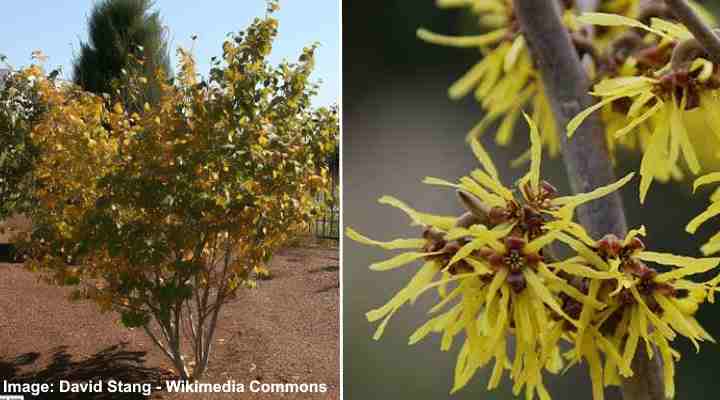
Witch hazels are versatile plants that bring color to winter gardens with their scented yellow flowers, which have delicate, spindly petals. Apart from their charming blooms, these trees also enhance the landscape with their vibrant foliage. During the spring, the attractive bright green leaves create a pleasant sight, transitioning to yellowish-orange hues in the fall.
Due to their compact size, witch hazel trees are an excellent choice for areas with limited planting space. With a height of 15 to 20 ft. (4.5 – 6 m) and a similar spread, they fit well in various settings.
These ornamental trees thrive in zones 3 – 8 and prefer locations with both full sun and partial shade. You can utilize them as privacy hedges, specimen plants, or as borders for shrubbery.
Mature Size: 15 to 20 ft. (4.5 – 6 m) tall and wide
USDA Hardiness Zones: 3 to 8
Sun: Full sun to partial shade
Golden Rain Tree (Koelreuteria paniculata)
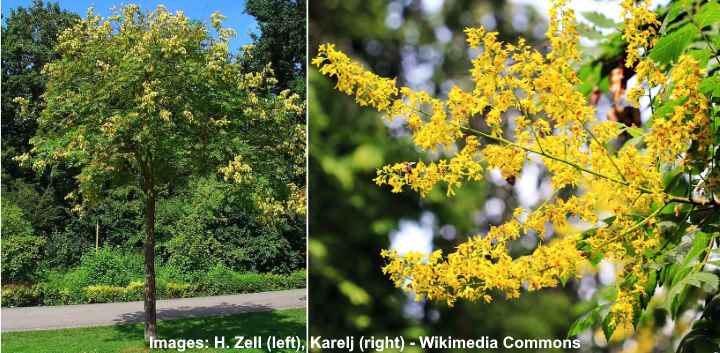
The golden rain tree is a small-medium flowering tree that can grow up to 23 ft. (7 m) high
The golden rain tree is a popular decorative tree adorned with lovely golden-yellow flowers, each with four delicate petals. Its canopy is wide and domed, offering lots of shade. As a deciduous tree, it bears pinnate, feathery leaves that emerge with a hint of pink, turning vibrant green as they mature. During autumn, the tree stands out with its unique orange-brown, papery seed pods, which start green and ripen to an attractive orange-pink hue.
To thrive, the golden rain tree requires well-drained, moist soil. Once established, it can endure both drought and salt. Thanks to its dazzling flowers, it is often grown as a focal point in any landscape and serves as an excellent shade tree due to its expansive canopy.
Mature Size: 30 to 40 ft. (9 to 12 m)
USDA Hardiness Zones: 5-9
Sun: Full sun
Ylang-ylang Tree (Cananga odorata)

Ylang Ylang Tree (Cananga odorata)
The ylang-ylang tree is a medium-sized tree known for its unique, drooping yellow flowers. These highly aromatic flowers are prized for their fragrant essential oil, which is commonly used in perfumes. The tree’s glossy, dark-green leaves and long, cascading branches are easy to recognize. Additionally, the tree bears ovular, greenish-yellow fruits that turn black when ripe.
With a rapid growth rate of up to 5 ft. (1.5 m) per year, ylang-ylang trees prefer well-drained, neutral soil and thrive in humid, subtropical climates. They are becoming increasingly popular as shade trees and are striking focal points in gardens and landscapes due to their lush foliage and delightful fragrance.
Mature Size: 30 to 70 ft. (9 to 21 m)
USDA Hardiness Zones: 10-12
Sun: Full sun
Frangipani (plumeria)
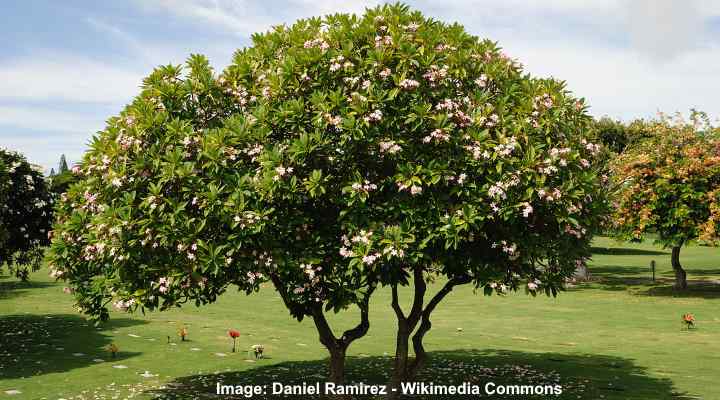
Plumeria tree
Frangipani, a family of small deciduous trees, is renowned for its exotic, star-shaped flowers that bloom in various colors. Some frangipani cultivars showcase aromatic, eye-catching yellow or whitish-yellow flowers. The frangipani leaves often take on an elliptical form, displaying a vibrant green hue. Another distinctive feature is the long, plump, green pods that gradually turn brown as they mature.

To thrive, frangipani trees prefer well-drained soil and abundant sunlight. Interestingly, they have low flammability, making them tolerant of bushfires. You can cultivate any desired cultivar as a focal point or a stunning specimen tree, adding a touch of elegance and beauty to your landscape.
Mature Size: 6 and 8 ft. (1.8 – 2.4 m)
USDA Hardiness Zones: 9-12
Sun: Full sun
Other Types of Flowering Trees (With Pictures)
Rose Trees
Roses are a flowering shrub that is one of the most popular types of flowers in the world. However, it is possible to produce a rose tree by grafting and pruning an existing rose shrub. This can create a spectacular type of flowering rose tree that can grow in containers or as a specimen tree in your landscaped garden.
Read Next: Small Flowering Shrubs With Pictures For Easy Identification
Read Next: Small Flowering Trees with Pictures For Easy Identification
How to Select Flowering Trees For Your Garden
When choosing flowering trees for your garden, it’s important to consider the size, climate, and blooming period. Opt for low-maintenance trees that align with your garden’s color and shape preferences. By keeping these factors in mind, you’ll discover the ideal tree to enhance your garden’s beauty.
Begin by evaluating the size of your garden and selecting a tree that suits the available space. Then, consider the climate to ensure the tree is well-suited to your region. Look for trees with a long blooming period, allowing you to relish their colors for an extended time. Additionally, prioritize trees with low maintenance requirements, simplifying your gardening tasks.
Lastly, take into account the color and shape of the blooms to ensure they harmonize with your garden’s aesthetic.
By carefully considering these factors, you can confidently choose the perfect flowering tree for your garden, transforming it into a picturesque haven throughout the seasons.
Related articles:


